Read the May magazine issue on food and climate change


United States nuclear weapons, 2024
By Hans M. Kristensen , Matt Korda , Eliana Johns , Mackenzie Knight | May 7, 2024
The United States has embarked on a wide-ranging nuclear modernization program that will ultimately see every nuclear delivery system replaced with newer versions over the coming decades. In this issue of the Nuclear Notebook, we estimate that the United States maintains a stockpile of approximately 3,708 warheads—an unchanged estimate from the previous year. Of these, only about 1,770 warheads are deployed, while approximately 1,938 are held in reserve. Additionally, approximately 1,336 retired warheads are awaiting dismantlement, giving a total inventory of approximately 5,044 nuclear warheads. Of the approximately 1,770 warheads that are deployed, 400 are on land-based intercontinental ballistic missiles, roughly 970 are on submarine-launched ballistic missiles, 300 are at bomber bases in the United States, and approximately 100 tactical bombs are at European bases. The Nuclear Notebook is researched and written by the staff of the Federation of American Scientists’ Nuclear Information Project: director Hans M. Kristensen, senior research fellow Matt Korda, research associate Eliana Johns, and program associate Mackenzie Knight.
This article is freely available in PDF format in the Bulletin of the Atomic Scientists’ digital magazine (published by Taylor & Francis) at this link . To cite this article, please use the following citation, adapted to the appropriate citation style: Hans M. Kristensen, Matt Korda, Eliana Johns, and Mackenzie Knight, United States nuclear weapons, 2024, Bulletin of the Atomic Scientists , 80:3, 182-208, DOI: https://doi.org/10.1080/00963402.2024.2339170
To see all previous Nuclear Notebook columns in the Bulletin of the Atomic Scientists dating back to 1987, go to https://thebulletin.org/nuclear-notebook/ .
In May 2024, the US Department of Defense maintained an estimated stockpile of approximately 3,708 nuclear warheads for delivery by ballistic missiles and aircraft. Most of the warheads in the stockpile are not deployed but rather stored for potential upload onto missiles and aircraft as necessary. We estimate that approximately 1,770 warheads are currently deployed, of which roughly 1,370 strategic warheads are deployed on ballistic missiles and another 300 at strategic bomber bases in the United States. An additional 100 tactical bombs are deployed at air bases in Europe. The remaining warheads—approximately 1,938—are in storage as a so-called “hedge” against technical or geopolitical surprises. Several hundred of those warheads are scheduled to be retired before 2030 (see Table 1).
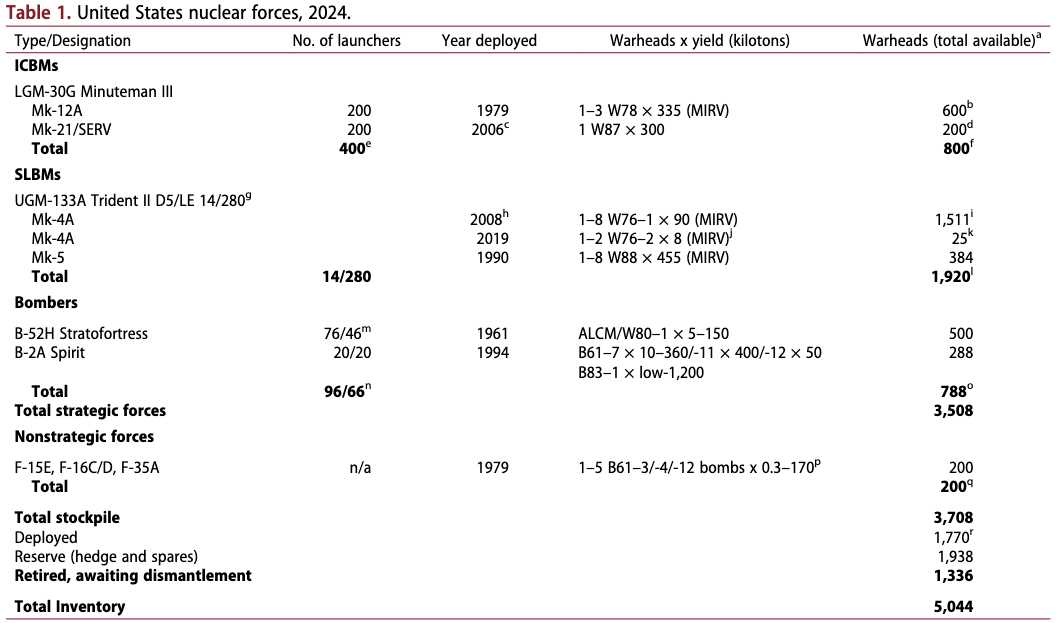
While the majority of the United States’ warheads comprises the Department of Defense’s military stockpile, retired warheads under the custody of the Department of Energy awaiting dismantlement constitute a “significant fraction” of the United States’ total warhead inventory (US Department of Energy 2023b). Dismantlement operations include the disassembly of retired weapons into component parts that are then assigned for reuse, storage, surveillance, or for additional disassembly and subsequent disposition (US Department of Energy 2023b, 2–11). The pace of warhead dismantlement has slowed significantly in recent years: While the United States dismantled on average more than 1,000 warheads per year during the 1990s, in 2020 it dismantled only 184 warheads (US State Department 2021). According to the Department of Energy, “[d]ismantlement rates are affected by many factors, including appropriated program funding, logistics, legislation, policy, directives, weapon system complexity, and the availability of qualified personnel, equipment, and facilities” (US Department of Energy 2022, 2–15). The US Department of Energy stated in April 2023 that it “was on pace to complete the dismantlement of all warheads retired before Fiscal Year (FY) 2009 [Sep. 2008] by the end of FY 2022 [Aug. 2022]” but that the COVID-19 pandemic “delayed the dismantlement of a small number of these retired warheads until after FY 2022 [Aug. 2022]” (US Department of Energy 2023a, 2–12).
Based on these timelines and recent dismantlement rates, we estimate that the United States possesses approximately 1,336 retired—but still intact—warheads awaiting dismantlement, giving a total estimated US inventory of approximately 5,044 warheads.
Between 2010 and 2018, the US government publicly disclosed the size of the nuclear weapons stockpile; however, in 2019 and 2020, the Trump administration rejected requests from the Federation of American Scientists to declassify the latest stockpile numbers (Aftergood 2019; Kristensen 2019a, 2020b). In 2021, the Biden administration restored the United States’ previous transparency levels by declassifying both numbers for the entire history of the US nuclear arsenal until September 2020—including the missing years of the Trump administration. This effort revealed that the United States’ nuclear stockpile consisted of 3,750 warheads in September 2020—only 72 warheads fewer than the last number made available in September 2017 before the Trump administration reduced the US government’s transparency efforts (US State Department 2021). We estimate that the stockpile will continue to decline over the next decade as modernization programs consolidate the remaining warheads.
Following the Biden administration’s initial declassification in 2021, it has since denied successive annual requests from the Federation of American Scientists to disclose the stockpile numbers for 2021, 2022, or 2023 (Kristensen 2023d). A decision to no longer declassify these numbers not only contradicts the Biden administration’s own recent practices, but also represents a return to Trump-era levels of nuclear opacity. Such increased nuclear secrecy undermines US calls for Russia and China to increase transparency of their nuclear forces.
The US nuclear weapons are thought to be stored at an estimated 24 geographical locations in 11 US states and five European countries (Kristensen and Korda 2019, 124). The number of locations will increase over the next decade as nuclear storage capacity is added to three bomber bases. The location with the most nuclear weapons by far is the large Kirtland Underground Munitions and Maintenance Storage Complex south of Albuquerque, New Mexico. Most of the weapons in this location are retired weapons awaiting dismantlement at the Pantex Plant in Texas. The state with the second-largest inventory is Washington, which is home to the Strategic Weapons Facility Pacific and the ballistic missile submarines at Naval Submarine Base Kitsap. The submarines operating from this base carry more deployed nuclear weapons than any other base in the United States.
Implementing the New START treaty
The United States appears to be in compliance with the New Strategic Arms Reduction Treaty (New START) limits. Although Russia “suspended” its participation in New START in February 2023, the United States publicly declared in May 2023 that it had 1,419 warheads attributed to 662 deployed ballistic missiles and heavy bombers as of March 1st, 2023 (US State Department 2023a). The United States initially said that it voluntarily released the numbers “[i]n the interest of transparency and the US commitment to responsible nuclear conduct.” However, the United States did not continue this practice beyond that initial exchange and has not published any aggregate numbers since May 2023 (US State Department 2023a).
The United States contends that Russia’s “suspension” of New START implementation is “legally invalid” (US State Department 2023c). In response, the United States adopted four countermeasures in 2023 that it claimed were fully consistent with international law 1) no longer providing biannual data updates to Russia; 2) withholding from Russia notifications regarding treaty-accountable items (i.e. missiles and launchers) required under the treaty; 3) refraining from facilitating inspection activities on US territory; and 4) not providing Russia with telemetric information on US ICBM and SLBM launches (US State Department 2023c).
The New START warhead numbers reported by the US State Department differ from the estimates presented in this Nuclear Notebook, though there are reasons for this. The New START counting rules artificially attribute one warhead to each deployed bomber, even though US bombers do not carry nuclear weapons under normal circumstances. Also, this Nuclear Notebook counts as deployed all weapons stored at bomber bases that can quickly be loaded onto the aircraft, as well as nonstrategic nuclear weapons at air bases in Europe. This provides a more realistic picture of the status of US deployed nuclear forces than the treaty’s artificial counting rules.
Since the treaty entered into force in February 2011, the biannual aggregate data show the United States has cut its arsenal by a total of 324 strategic launchers, reduced deployed launchers by 220 and the warheads attributed to them by 381 (US State Department 2011). The warhead reduction is modest, only equivalent to about 10 percent of the 3,708 warheads remaining in the US stockpile. The 2022 Nuclear Posture Review (NPR) stated that “[t]he United States will field and maintain strategic nuclear delivery systems and deployed weapons in compliance with New START Treaty central limits as long as the Treaty remains in force” (US Department of Defense 2022a, 20).
As of March 2023, the United States had 38 launchers and 131 warheads less than the treaty limit for deployed strategic weapons but had 119 deployed launchers more than Russia—a significant gap that is just under the size of an entire US Air Force intercontinental ballistic missile (ICBM) wing. So far Russia has not sought to reduce this gap by deploying more strategic launchers but instead has increased the portion of its missiles that can carry multiple warheads.
The New START treaty has proven useful so far in keeping a lid on both countries’ deployed strategic forces. But it expires in February 2026 and if it is not followed by a new agreement, both the United States and Russia could potentially increase their deployed nuclear arsenals by uploading several hundred of stored reserve warheads onto their launchers. Additionally, if the treaty’s verification and data-exchange arrangements are not replaced, both countries will lose important information about each other’s nuclear forces. Until the treaty’s so-called “suspension,” the United States and Russia had completed a combined 328 on-site inspections and exchanged 25,017 notifications (US State Department 2022).
Nuclear Posture Reviews and nuclear modernization programs
The Biden administration’s 2022 Nuclear Posture Review (NPR) was broadly consistent with the Trump administration’s 2018 NPR (albeit with minor adjustments), which in turn followed the broad outlines of the Obama administration’s 2010 NPR to modernize the entire nuclear weapons arsenal. Just like previous NPRs, the Biden administration’s NPR said the United States reserved the right to use nuclear weapons under “extreme circumstances to defend the vital interests of the United States or its allies and partners” and rejected policies of nuclear “no-first-use” or “sole purpose” (US Department of Defense 2022a, 9). Even so, the 2022 NPR notes that the United States “retain[s] the goal of moving toward a sole purpose declaration and [it] will work with [its] Allies and partners to identify concrete steps that would allow [it] to do so” (US Department of Defense 2022a, 9) (For a detailed analysis of the 2022 NPR, see Kristensen and Korda 2022).
The most significant change between the Biden and Trump NPRs was the walking back of two Trump-era commitments—specifically, canceling the proposed nuclear sea-launched cruise missile (SLCM-N) and continuing with the retirement of the B83–1 gravity bomb.
The Trump NPR had asserted that a SLCM-N with low-yield capability “may provide the necessary incentive for Russia to negotiate seriously a reduction of its nonstrategic nuclear weapons, just as the prior Western deployment of Intermediate-Range Nuclear Forces [INF] in Europe led to the 1987 INF Treaty” (US Department of Defense 2018, 55). However, this has not proved to be the case. Furthermore, the theory that additional low-yield capabilities would somehow change Russia’s behavior seems flawed because the US arsenal already includes nearly 1,000 gravity bombs and air-launched cruise missiles, combined, with low-yield warhead options (Kristensen 2017b). Moreover, US Strategic Command has already strengthened strategic bombers’ support of NATO in response to Russia’s more provocative and aggressive behavior (see below): 46 B-52 bombers are currently equipped with the AGM-86B air-launched cruise missile and both the B-52 and the new B-21 bombers will receive the new AGM-181 Long-Range Standoff Weapon (LRSO), which will have very similar capabilities to the sea-launched cruise missile proposed by the 2018 NPR.
Furthermore, the US Navy used to have a nuclear sea-launched cruise missile (the TLAM-N) but completed retirement of the system by 2013 because it was redundant and no longer needed. All other nonstrategic nuclear weapons—except gravity bombs for fighter-bombers—have also been retired because there was no longer any military need for them, despite Russia’s larger nonstrategic nuclear weapons arsenal. The suggestion that a US sea-launched cruise missile could motivate Russia to return to compliance with the INF Treaty was also flawed because Russia embarked upon its violation of the treaty at a time when the TLAM-N was still in the US arsenal; besides, the Trump administration ultimately withdrew the United States from the INF Treaty anyway. Development of a nuclear sea-launched cruise missile would violate the United States’ pledge made in the 1992 Presidential Nuclear Initiative not to develop any new types of nuclear sea-launched cruise missiles (Koch 2012, 40), and could, if deployed in the Pacific, potentially also incite China to increase its regional nuclear capabilities.
One final argument against the sea-launched cruise missile is that nuclear-capable vessels triggered frequent and serious political disputes during the Cold War when they visited foreign ports in countries that did not allow nuclear weapons on their territory. In the case of New Zealand, diplomatic relations have only recently—some 30 years later—recovered from those disputes. And Iceland recently opened its ports to non-nuclear-armed attack submarines for the first time ever. Reconstitution of a nuclear sea-launched cruise missile would reintroduce this foreign relations irritant and needlessly complicate relations with key allied countries in Europe and Northeast Asia.
The Biden administration’s NPR echoed many of these arguments, concluding that the “SLCM-N was no longer necessary given the deterrence contribution of the W76-2, uncertainty regarding whether SLCM-N on its own would provide leverage to negotiate arms control limits on Russia’s NSNW, and the estimated cost of SLCM-N in light of other nuclear modernization programs and defense priorities” (US Department of Defense 2022a, 20). The Biden administration used even stronger language against the SLCM-N in an October 2022 statement suggesting that “the SLCM-N, which would not be delivered before the 2030s anyway, is unnecessary and potentially detrimental to other priorities” (US Office of Management and Budget 2022). In its statement, the administration noted that “[f]urther investment in developing SLCM-N would divert resources and focus from higher modernization priorities for the US nuclear enterprise and infrastructure, which is already stretched to capacity after decades of deferred investments. It would also impose operational challenges on the Navy” (US Office of Management and Budget 2022). This is because to carry nuclear weapons onboard, Navy crews would require specialized training and would need to adopt strict security protocols that could operationally hinder these multipurpose vessels (Woolf 2022). Additionally, deployed nuclear sea-launched cruise missiles would take the place of more flexible conventional munitions for vessels on patrol, thus incurring a substantial opportunity cost (Moulton 2022).
Despite the Biden administration’s conclusions, however, the SLCM-N may ultimately be funded through congressional intervention. The Fiscal Year (FY) 2024 National Defense Authorization Act (NDAA) authorized nominal funding for the system and required the establishment of a program of record for the SLCM-N, even though the Biden administration’s FY 2023 budget request recommended zeroing out the system’s funding entirely (US Congress 2023). The FY 2025 NDAA continued funding of the weapon and the administration accepted it but it remains to be seen whether the SLCM-N will ultimately be fielded given funding constraints and other priorities.
The Biden administration’s NPR also continued earlier plans to retire the B83-1 gravity bomb—the last nuclear weapon with a megaton-level yield in the US nuclear arsenal—“due to increasing limitations on its capabilities and rising maintenance costs” (US Department of Defense 2022a, 20). The Trump administration had put on hold previous plans to retire the B83–1 (US Department of Defense 2018).
The complete nuclear modernization and maintenance program will continue well beyond 2039 and, based on the Congressional Budget Office’s estimate, will cost $1.2 trillion over the next three decades. Notably, although the estimate accounts for inflation (Congressional Budget Office 2017), other estimates forecast that the total cost will be closer to $1.7 trillion (Arms Control Association 2017). Whatever the actual price tag will be, it is likely to increase over time, resulting in increased competition with conventional modernization programs planned for the same period.
In 2023, multiple governmental advisory commissions published reports intended to influence US nuclear posture. The Congressionally-mandated report on “America’s Strategic Posture,” published in October 2023, included a broad range of recommendations for the United States to prepare to increase the number of deployed warheads, as well as to scale up its production capacity of bombers, air-launched cruise missiles, ballistic missile submarines, non-strategic nuclear forces, and warheads (US Strategic Posture Commission 2023). It also called for the United States to deploy multiple warheads on land-based intercontinental ballistic missiles (ICBMs) and consider adding road-mobile ICBMs to its arsenal. In contrast, the US State Department’s International Security Advisory Board report on “Deterrence in a World of Nuclear Multipolarity” advised the United States to pursue competition with Russia and China “without accelerating arms race instability or risking runaway competition” (US State Department 2023b). While neither report represents official US government policy, the Strategic Posture Commission report’s status as a bipartisan document has been particularly useful for nuclear advocates to push for additional nuclear weapons (Heritage 2023; Hudson Institute 2023; Thropp 2023).
While additional modernization programs are being discussed, the National Nuclear Security Administration, or NNSA, delivered in 2023 more than 200 modernized nuclear weapons (B61–12 bombs and W88 Alt 370 warheads) to the Department of Defense (US Department of Energy 2024).
Nuclear planning and nuclear exercises
In addition to the Nuclear Posture Review, the nuclear arsenal and the role it plays is shaped by plans and exercises that create the strike plans and practice how to carry them out.
The current strategic nuclear war plan—OPLAN 8010–12—consists of “a family of plans” directed against four identified adversaries: Russia, China, North Korea, and Iran. Known as “Strategic Deterrence and Force Employment,” OPLAN 8010–12 first entered into effect in July 2012 in response to operational order Global Citadel. The plan is flexible enough to absorb normal changes to the posture as they emerge, including those flowing from the NPR. Several updates have been made since 2012, but more substantial updates will trigger the publication of what is formally considered a “change.” The April 2019 change refocused the plan toward “great power competition,” incorporated a new cyber plan, and reportedly blurred the line between nuclear and conventional attacks by “fully incorporat[ing] non-nuclear weapons as an equal player” (Arkin and Ambinder 2022a, 2022b).
OPLAN 8010–12 also “emphasizes escalation control designed to end hostilities and resolve the conflict at the lowest practicable level” by developing “readily executable and adaptively planned response options to de-escalate, defend against, or defeat hostile adversary actions” (US Strategic Command 2012). While not new, these passages are notable, not least of which because the Trump administration’s NPR criticized Russia for an alleged willingness to use nuclear weapons in a similar manner, as part of a so-called “escalate-to-deescalate” strategy.
The Nuclear Employment Strategy published by the Trump administration in 2020 reiterates this objective: “If deterrence fails, the United States will strive to end any conflict at the lowest level of damage possible and on the best achievable terms for the United States, and its allies, and partners. One of the means of achieving this is to respond in a manner intended to restore deterrence. To this end, elements of US nuclear forces are intended to provide limited, flexible, and graduated response options. Such options demonstrate the resolve, and the restraint, necessary for changing an adversary’s decision calculus regarding further escalation” (US Department of Defense 2020, 2). This objective is not just directed at nuclear attacks, as the 2018 NPR called for “expanding” US nuclear options against “non-nuclear strategic attacks.” The Biden administration is expected to complete its guidance in 2024.
OPLAN 8010–12 is a whole-of-government plan that includes the full spectrum of national power to affect potential adversaries. This integration of nuclear and conventional kinetic and non-kinetic strategic capabilities into one overall plan is a significant change from the strategic war plan of the Cold War that was almost entirely nuclear. In 2017, former US Strategic Command commander Gen. John Hyten explained the scope of modern strategic planning by saying:
I’ll just say that the plans that we have right now, one of the things that surprised me most when I took command on November 3 was the flexible options that are in all the plans today. So we actually have very flexible options in our plans. So if something bad happens in the world and there’s a response and I’m on the phone with the Secretary of Defense and the President and the entire staff, which is the Attorney General, Secretary of State, and everybody, I actually have a series of very flexible options from conventional all the way up to large-scale nuke that I can advise the president on to give him options on what he would want to do …
The last time I executed or was involved in the execution of the nuclear plan was about 20 years ago, and there was no flexibility in the plan. It was big, it was huge, it was massively destructive, and that’s all there. We now have conventional responses all the way up to the nuclear responses, and I think that’s a very healthy thing. (Hyten 2017)
The 2022 Nuclear Posture Review and 2023 Strategy for Countering Weapons of Mass Destruction reaffirm the importance of flexibility, integration, and tailored plans (US Department of Defense 2023f). To practice and fine-tune these plans, the armed forces conducted several nuclear-related exercises in 2023. In October 2023, Air Force Global Strike Command conducted exercise Prairie Vigilance, an annual nuclear bomber exercise at Minot Air Force Base in North Dakota, which practiced the 5th Bomb Wing’s B-52 strategic readiness and nuclear generation operations (US Air Force 2023a).
The Vigilance exercises normally lead up to Strategic Command’s annual week-long Global Thunder large-scale exercise toward the end of the year, which “provides training opportunities that exercise all US Strategic Command mission areas, with a specific focus on nuclear readiness” (US Strategic Command 2021a). The exercise was most recently conducted in April 2023 at Minot AFB after being delayed in 2022 (US Air Force 2023d).
These exercises coincide with steadily increasing US bomber operations in Europe since Russia’s invasion of Ukraine in 2014 and again in 2022. Before that, one or two bombers would deploy for an exercise or airshow. But since then, the number of deployments and bombers has increased, and the mission has changed. Very quickly after the Russian annexation of Crimea, the US Strategic Command increased the role of nuclear bombers in support of the US European Command (Breedlove 2015), which, in 2016, put into effect a new standing war plan for the first time since the Cold War (Scapparotti 2017). Before 2018, the bomber operations were called the Bomber Assurance and Deterrence missions but have been redesigned as Bomber Task Force missions to bring a stronger offensive capability to the forward bases. Whereas the mission of Bomber Assurance and Deterrence was to train with allies and have a visible presence to deter Russia, the mission of the Bomber Task Force is to move a fully combat-ready bomber force into the European theater. “It’s no longer just to go partner with our NATO allies or to go over and have a visible presence of American air power,” according to the commander of the 2nd Bomb Wing. “That’s part of it, but we are also there to drop weapons if called to do so” (Wrightsman 2019). These changes are evident in the types of increasingly provocative bomber operations over Europe, in some cases very close to the Russian border (Kristensen 2022a). In October 2023, for example, a B-52 bomber from Barksdale AFB in Louisiana participated in NATO’s annual nuclear exercise Steadfast Noon, and in March 2023 a nuclear-capable B-52 cut south only a few kilometers from the Russian sea border and then flew south near Kaliningrad (Kristensen 2023a; NATO 2023).
These changes are important indications of how US strategy has changed in response to deteriorating East-West relations and the new “great power competition” and “strategic competition” strategy promoted by the Trump and Biden administrations, respectively. They also illustrate a growing integration of nuclear and conventional capabilities, as reflected in the new strategic war plan. B-52 Bomber Task Force deployments typically include a mix of nuclear-capable aircraft and aircraft that have been converted to conventional-only missions. With Sweden joining NATO, US strategic bombers now routinely operate over Swedish territory: In August 2022, for example, two B-52s—one version that is nuclear-capable and one that is de-nuclearized—overflew Sweden, the first overflight since it applied for NATO membership in May 2022 (Kristensen 2022c). On September 21, 2022—the very same day Russian President Vladimir Putin threatened to use nuclear weapons to defend newly annexed regions of Ukraine (Faulconbridge 2023)—four B-52s in Europe took off from the RAF Fairford Station in the United Kingdom and returned to the United States, two of them via northern Sweden. At the same time, their wing at Minot AFB in North Dakota was in the middle of the Prairie Vigilance nuclear exercise. Such close integration of nuclear and conventional bombers into the same task force can have significant implications for crisis stability, misunderstandings, and the risk of nuclear escalation because it could result in overreactions and misperceptions about what is being signaled.
Additionally, since 2019, US bombers have been practicing what is known as an “agile combat employment” strategy by which all bombers “hopscotch” to a larger number of widely dispersed smaller airfields—including airfields in Canada—in the event of a crisis. This strategy is intended to increase the number of aimpoints for a potential adversary seeking to destroy the US bomber force, therefore raising the ante for an adversary to attempt such a strike and increasing the force’s survivability if it does (Arkin and Ambinder 2022a).
Land-based ballistic missiles
The US Air Force (USAF) operates 400 silo-based Minuteman III ICBMs and keeps “warm” another 50 silos to load stored missiles if necessary, for a total of 450 silos. Land-based missile silos are divided into three wings: the 90th Missile Wing at F. E. Warren Air Force Base in Colorado, Nebraska, and Wyoming; the 91st Missile Wing at Minot Air Force Base in North Dakota; and the 341st Missile Wing at Malmstrom Air Force Base in Montana. Each wing has three squadrons, each with 50 Minuteman III silos collectively controlled by five launch control centers. We estimate there are up to 800 warheads assigned to the ICBM force, of which about half are deployed (see Table 1).
The 400 deployed Minuteman IIIs carry one warhead each, either a 300-kiloton W87/Mk21 or a 335-kiloton W78/Mk12A. ICBMs equipped with the W78/Mk12A, however, could technically be uploaded to carry two or three independently targetable warheads each, for a total of 800 warheads available for the ICBM force. The USAF occasionally test-launches Minuteman III missiles with unarmed multiple independently targetable reentry vehicles (MIRVs) to maintain and signal the capability to reequip the Minuteman III missiles with additional reentry vehicles, if desired. The most recent such test occurred on September 6, 2023, when a Minuteman III equipped with three test reentry vehicles was launched from Vandenberg Space Force Base in California and flew approximately 4,200 miles to the US ICBM testing ground at the Kwajalein Atoll in the Marshall Islands (US Air Force 2023e).
Although the Minuteman III was initially deployed in 1970, it has been modernized several times, including in 2015, when the missiles completed a multibillion-dollar, decade-long modernization program to extend their service life until 2030. The modernized Minuteman III missiles were referred to by Air Force personnel as “basically new missiles except for the shell” (Pampe 2012).
Part of the ongoing ICBM modernization program involves upgrades to the Mk21 reentry vehicles’ arming, fuzing, and firing system at a total cost of nearly $1 billion (US Department of Defense 2023c, 32). The publicly stated purpose of this refurbishment is to extend the vehicles’ service lives, but the effort appears to also involve adding a “burst height compensation” to enhance the targeting effectiveness of the warheads (Postol 2014). A total of 743 fuze replacements—including all necessary units for the development, qualification, certification, fielding, aging, and replenishment of the fuzes—are planned to be delivered for deployment on the Minuteman IIIs as well as their replacement missile—LGM-35 Sentinel—by the end of FY26 (US Department of Defense 2023a). A cost-projection overrun of the fuze integration program unit cost triggered a breach of the Nunn-McCurdy Act in September 2020 but is expected to begin full-rate production in FY 2024 (Reilly 2021; US Department of Defense 2023c). As part of the Mk21A program, Lockheed Martin was awarded a sole source contract in October 2023 amounting to just under $1 billion for the engineering and manufacturing of the new reentry vehicle (US Department of Defense 2023b). These modernization efforts complement a similar fuze upgrade underway to the Navy’s W76–1/Mk4A warhead.
Early acquisition activities for a Next Generation Reentry Vehicle (NGRV) began in FY24. The NGRV will be integrated into the new Sentinel ICBM to bolster its payload suite and will be capable of carrying both current and future warheads (US Air Force 2023f, 589).
The Air Force’s FY24 budget for ICBM Reentry Vehicles Research Development, Test & Evaluation Programs increased significantly from the previous President’s Budget due to changes to the Payload Reentry System requirements, which cost an extra $43.4 million, as well as the need to add another flight test due to a failed flight test in July 2022, which will cost over $48 million. In addition, NGRV funding was accelerated to begin early acquisition activities in FY24, adding $15.5 million to the FY24 budget. The total program cost for ICBM reentry vehicle development in FY24 is just over $475 million and will increase up to $864 million by FY28 (US Air Force 2023f, 589).
While the Air Force insists that “there is no backup plan for Sentinel,” it appears that it would be technically possible to conduct a second life-extension of the Minuteman III missile before it would have to be retired and replaced (Clark 2019; Heckmann 2023). A July 2022 environmental impact assessment revealed that the Air Force did consider such a life extension as well as three other options, including deploying a “[s]mall ICBM […] with lower procurement costs and enhanced accuracy;” working with “a private spacecraft company” to deploy commercial launch vehicles equipped with nuclear-capable reentry vehicles; and converting the existing Trident II D5 sea-launched ballistic missile (SLBM) to be deployed in land-based silos. However, the Air Force ultimately eliminated these options because they did not meet what it called its “selection standards,” which include criteria such as sustainability, performance, safety, riskiness, and capacity for integration into existing or proposed infrastructure (US Air Force 2022d). Instead, the Air Force opted to purchase a whole new generation of ICBMs known by its programmatic name—the Ground-Based Strategic Deterrent (GBSD)—until it was officially named the LGM-35A Sentinel in April 2022 (US Air Force 2022a).
Non-governmental experts, including those conducting Department of Defense-sponsored research, have questioned the Pentagon’s procurement process and lack of transparency regarding its decision to pursue the Sentinel option over other potential deployment and basing options (Dalton et al. 2022, 4). Moreover, it is unclear why an enhancement of ICBM capabilities would be necessary for the United States. For instance, any such enhancements would not mitigate the inherent challenges associated with launch-on-warning, risky territorial overflights, or silo vulnerabilities to environmental catastrophes or conventional counterforce strikes (Korda 2021). Additionally, even if adversarial missile defenses improved significantly, the ability to evade missile defenses lies with the payload—not the missile itself. By the time an adversary’s interceptor would be able to engage a US ICBM in its midcourse phase of flight, the ICBM would already have shed its boosters, deployed its penetration aids, and be guided solely by its reentry vehicle—which can be independently upgraded as necessary. For this reason, it is not readily apparent why the US Air Force would require its ICBMs to have capabilities beyond the current generation of Minuteman III missiles; the Air Force has yet to publicly explain why.
The development of the Sentinel has also been marked by a series of controversial industry contracts, starting with the awarding of a $13.3 billion sole-source contract to Northrop Grumman in 2020 to complete the engineering and manufacturing development stage (For a more detailed summary of the Sentinel’s procurement timeline, see Korda 2021). There have been warnings about program cost projection overruns for years: It was originally projected to cost between $93.1 billion and $95.8 billion, an increase from a preliminary $85 billion Pentagon estimate in 2016. In July 2023, the US Congressional Budget Office estimated that the cost of acquiring and maintaining the Sentinel would total approximately $118 billion over the 2023–2032 period—approximately $20 billion more than the Congressional Budget Office had previously estimated for the 2019–2028 period, and $36 billion more than the 2021–2030 period (Congressional Budget Office 2019, 2021, 2023). But in early 2024, the Air Force notified Congress of a two-year delay in the schedule and an estimated 37-percent increase from the current cost target to at least $125 billion (Tirpak 2024). These amounts do not include the costs for the new Sentinel warhead—the W87–1—which is projected to cost up to $14.8 billion, or the plutonium pit production that the US Air Force and US Strategic Command say is needed to build the warheads (Government Accountability Office 2020).
The schedule and extreme cost overruns for the Sentinel program incurred a critical breach of the Nunn-McCurdy Act, which requires the Secretary of Defense to conduct a root-cause analysis and renewed cost assessment before providing a certification to Congress that verifies the necessity and viability of the program no later than 60 days after a Selected Acquisition Report is also submitted to Congress (Knight 2024b). Only if the Secretary of Defense determines that a certification can be issued will the Sentinel program avoid termination. In this case, the Nunn-McCurdy Act then requires the program to be assigned new approval milestones and be restructured to address the causes behind the overrun. It is likely that the Secretary of Defense will justify the need for the Sentinel program. The Air Force asserted that the Sentinel program will continue at all costs and will make any necessary “trades,” which could mean an increased defense budget or a reduction or cancellation of other programs (Decker 2024).
Andrew Hunter, Assistant Secretary of the Air Force for Acquisition, Technology, and Logistics clarified that while the cost of the missile itself has increased, challenges with supporting infrastructure is the significant driver of schedule overrun, which also further impacts the overall cost (Tirpak 2024). In addition to an entirely new missile, the Sentinel program includes launch facility replacement and modifications (since the Sentinel may require a larger silo), new missile alert facilities, and new command and control facilities and systems—not to mention new training and curriculum for USAF personnel. Many of these delays are results of staffing shortfalls, clearance delays, IT infrastructure challenges, and trouble with supply chains on the part of Northrop Grumman (Government Accountability Office 2023a, 88).
According to a USAF program report published in 2020, the Air Force must deploy 20 new Sentinel missiles with legacy reentry vehicles and warheads to achieve initial operating capability, scheduled in fiscal year 2029 (Sirota 2020). The plan is to purchase a total of 659 missiles—400 of which would be deployed, while the remainder will be used for test launches and as spares (Capaccio 2020). However, the Air Force announced in early 2024 that the date of the first Sentinel deployment will slide into spring 2030 and may fall even further behind schedule. The Department of Defense has previously indicated that a two-year delay could lower the force structure by at least 30—which raises the question of whether some of the Minuteman III ICBMs will be life-extended anyways or if the US force structure will dip below the congressionally-mandated requirement of 400 deployed ICBMs (Korda and White 2021).
Program officials had originally announced that the first Sentinel prototype would conduct a test flight by the end of 2023, but this schedule has been delayed and is now planned for FY24 (Bartolomei 2021; Government Accountability Office 2023a). The first two in a series of static firing tests were completed in March 2023 and January 2024 to assess the first and second stages of the Sentinel’s three-stage propulsion system (Air Force Nuclear Weapons Center 2023, 2024). Northrop Grumman also conducted a series of “shroud fly-off and missile modal tests” in early 2024 to evaluate the “forward and aft sections” of the Sentinel (Northrop Grumman 2024). Throughout 2023, satellite imagery revealed construction to a test launch site at Vandenberg Air Force Base, in a likely effort to upgrade the site to accommodate the Sentinel test flight program (see Figure 1).
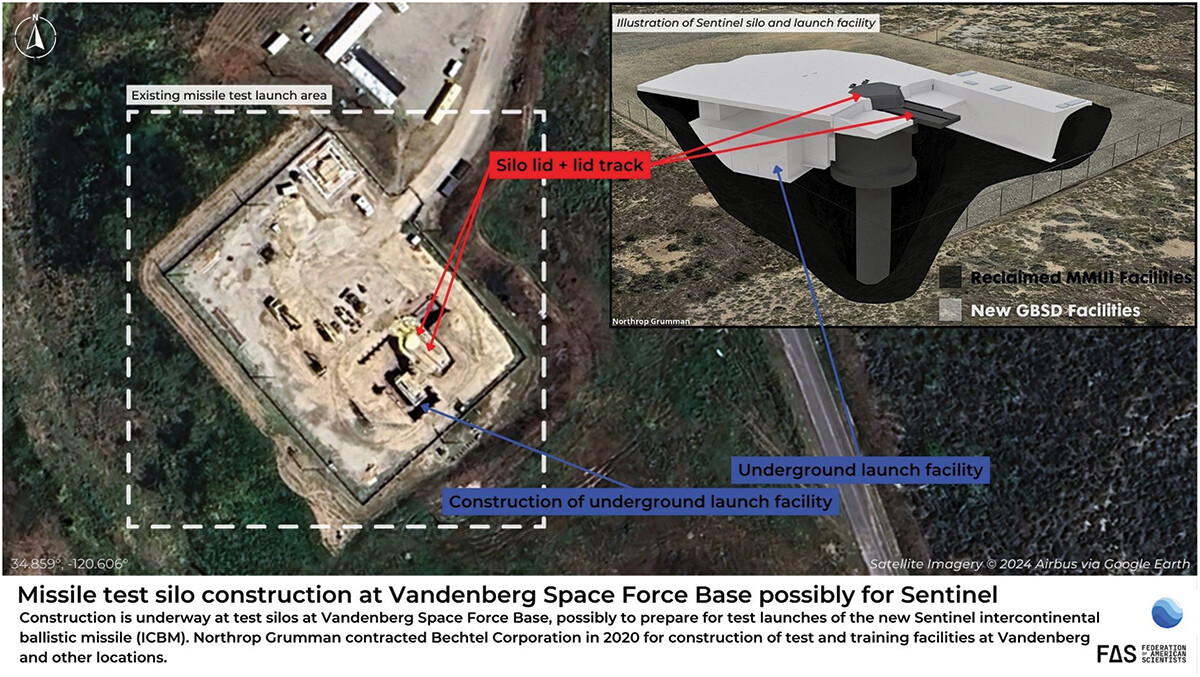
According to the US Air Force, the new Sentinel missile will meet existing user requirements but will have the adaptability and flexibility to be upgraded throughout 2075 and will have a greater range than the current Minuteman III (US Air Force 2016). Still, it is unlikely that the Sentinel will have enough range to target countries like China, North Korea, and Iran without over-flying Russia.
The Sentinel missile will be able to carry multiple warheads, possibly up to two per missile. The Air Force initially planned to equip the Sentinel with life-extended versions of the existing W78 (the modified version of which was known as Interoperable Warhead 1) and W87 warheads. However, in 2018, the Air Force and the NNSA canceled the upgrades and instead proposed a Modification Program to replace the W78 and eventually the W87 with a new warhead known as the W87–1/Mk4A. This new warhead will use a W87-like plutonium pit along with “a well-tested IHE [Insensitive High Explosive] primary design” and will be incorporated into the Mk21A, a modified version of the current Mk21 reentry vehicle (US Department of Energy 2018b). The Weapons Development Cost Report for the W87 modernization program lists the total estimated cost to be up to $15.9 million, not including the costs associated with the production of the new plutonium pits (NNSA 2023, 8–31).
As required by the FY18 National Defense Authorization Act, the NNSA has set an ambitious course of action for producing at least 80 plutonium pits per year by 2030 to meet the Sentinel’s planned deployment schedule. However, due to the agency’s consistent inability to meet project deadlines and its lack of a latent large-scale plutonium production capability, the NNSA notified Congress in 2021 of what independent analysts have long predicted—that the agency will not be able to meet the 80-pit requirement (Demarest 2021; Government Accountability Office 2020; Institute for Defense Analyses 2019). To come as close to the annual pit production requirement as possible, the Savannah River Plutonium Processing Facility has been tasked with producing 50 of the plutonium pits while the other 30 will be produced at Los Alamos National Laboratory. A repurposed, never-completed, Mixed Fuel Oxide Fuel Fabrication facility at the Savannah River Site was originally scheduled to come online in 2030 to support the goal of 50 pits per year, but the date of completion was extended to between 2032 and 2035 (NNSA 2021a).
Despite completing its Weapon Design Cost Report and entering Phase 6.3 for development engineering in FY23, the W87–1 program will continue to face significant delays and will not enter production until the early 2030s (NNSA 2023, ix, 2–8). Therefore, the Sentinel will be initially fielded with a modified version of the existing W87 known as the W87–0 (NNSA 2023, 1–6).
The Air Force is faced with a tight construction schedule for the deployment of the Sentinel. Each launch facility is expected to take 10 months to upgrade, while each missile alert facility will take approximately 16 months (US Air Force 2023c). The Air Force intends to upgrade all 150 launch facilities and eight out of 15 missile alert facilities for each of the three ICBM bases; the remaining seven missile alert facilities at each base will be dismantled (US Air Force 2023c).
Since each missile alert facility is currently responsible for a group of 10 launch facilities, this could indicate that each missile alert facility may eventually be responsible for up to 18 or 19 launch facilities once the Sentinel becomes operational, which would have implications for the future vulnerability of the Sentinel’s command-and-control system (Korda 2020). Once these upgrades begin, potentially in early 2024, the Air Force must complete one launch facility per week for nine years to complete the new missile’s deployment by 2036 (Mehta 2020).
But since it will take more than one week to complete each facility, several will be out of operation at any given time, which means the Air Force will not be able to maintain 400 operational ICBMs during the construction program. As a result, the 2023 Congressional Strategic Posture Commission recommended the Air Force deploy more than one warhead on some of the ICBMs to maintain the current warhead level (US Strategic Posture Commission 2023). It is expected that construction and deployment will take place first at F. E. Warren Air Force Base between 2023 and 2031, followed by Malmstrom between 2025 and 2033, and finally Minot between 2027 and 2036. While initial construction activities for the Sentinel were approved in May 2023, the schedule may shift as more information becomes available regarding the results from the Sentinel program’s breach of the Nunn-McCurdy Act (Miller and Perez 2023).
As the Sentinel missile gets deployed, the Minuteman III missiles will be removed from their silos and temporarily stored at their respective host bases before being transported to Hill Air Force Base, the Utah Test and Training Range, or Camp Navajo in Arizona. The rocket motors will eventually be destroyed at the Utah Test and Training Range, while non-motor components will be decommissioned at Hill Air Force Base. To that end, five and 11 new storage igloos will be constructed at Hill Air Force Base and Utah Test and Training Range, respectively (US Air Force 2020b).
The three ICBM bases will also receive new training, storage, and maintenance facilities as well as upgrades to their Weapons Storage Areas. The first base to receive this upgrade is F. E. Warren, where a groundbreaking ceremony for the new underground Weapons Storage and Maintenance Facility (also called the Weapons Generation Facility) was held in May 2019. Substantial construction began in spring 2020 and was scheduled to be completed in September 2022 (Kristensen 2020a; US Air Force 2019d). Commercial satellite imagery indicates that construction has made substantial progress as of February 2024, although completion could not be confirmed. Construction on new tactics-training facilities have also begun at both F. E. Warren and Malmstrom Air Force Bases. The National Defense Authorization Act for FY24 authorized $10.3 million for construction and land acquisition at Malmstrom that will go toward a new fire station bay and storage area (Tester 2023).
The Air Force conducts several Minuteman III flight tests each year. These are long-planned tests, and the Air Force consistently states that they are not scheduled in response to any external events. After postponements of several tests in 2022 due to global tensions, in 2023 the Minuteman III was launched three separate times from Vandenberg Air Force Base to the Reagan Test Site on Kwajalein Atoll in the Western Pacific traveling approximately 4,200 miles with between one to three test reentry vehicles (Air Force Global Strike Command Public Affairs 2023a, 2023b, 2023c). However, a fourth test that took place in November 2023 was “safely terminated” during its flight due to an “anomaly” that occurred during launch (Air Force Global Strike Command Public Affairs 2023d).
Nuclear-powered ballistic missile submarines
The US Navy operates a fleet of 14 Ohio-class ballistic missile submarines (SSBNs), of which eight operate in the Pacific from their base near Bangor, Washington, and six operate in the Atlantic from their base at Kings Bay, Georgia. In the past, two of the 14 submarines would be in reactor refueling overhaul (a lengthy refitting process typically carried out about midway through their operating lifespan) at any given time. As the last refueling was completed in February 2023, all 14 boats could now potentially be deployed until 2027 when the first Ohio-class submarine is expected to retire (PSNS & IMF Public Affairs 2023; US Navy 2019). But because operational submarines undergo minor repairs at times, the actual number at sea at any given time is usually closer to eight or 10. Four or five of those are thought to be on “hard alert” in their designated patrol areas, while another four or five boats could be brought to full alert status in hours or days.
Each submarine can carry up to 20 Trident II D5 sea-launched ballistic missiles (SLBMs), a number reduced from 24 to meet the limits of New START. The 14 SSBNs could potentially carry up to 280 such missiles but the United States has stated that it will not deploy more than 240. Since 2017, the Navy has been replacing the original Trident II D5 with a life-extended and upgraded version known as Trident II D5LE (LE stands for “life-extended”). The upgrade is expected to be completed in 2024. The D5LE, which has a range of more than 12,000 km, is equipped with the new Mk6 guidance system designed to “provide flexibility to support new missions” and make the missile “more accurate,” according to the Navy and Draper Laboratory (Draper Laboratory 2006; Naval Surface Warfare Center 2008). According to FY24 budget documents, the D5LE has also added a hard-target kill capability and increased its payload “to the level permitted by the size of the TRIDENT submarine launch tube, thereby allowing mission capability to be achieved with fewer submarines” (US Department of Defense 2023d). This is to compensate for the fact that the United States will deploy fewer Columbia-class submarines than Ohio-class submarines and each submarine will only carry 16 missiles. (See later paragraphs in this section for more details).
The D5LE upgrade will continue until all boats have been upgraded and will also replace existing Trident SLBMs on British ballistic missile submarines. The D5LE will also arm the new US Columbia-class and British Dreadnought-class ballistic missile submarines when they enter service.
Instead of building a new ballistic missile like the Air Force wants to do with the Sentinel ICBM, the Navy plans to do a second life-extension of the Trident II D5LE to ensure it can operate through 2084 (Eckstein 2019). In 2021, the Director of the Navy’s Strategic Systems Program testified to Congress that the D5LE2, as the second life-extended missile is known, is scheduled to enter service on the ninth Columbia-class SSBN beginning in FY 2039, following which it will be back-fitted to the remaining eight boats (Wolfe 2021b). The Navy also announced in 2021 that it would acquire an additional 108 Trident missiles to be used for deployment and testing (Wolfe 2021a).
Each Trident SLBM can carry up to eight nuclear warheads, but they normally carry an average of four or five warheads, for an average load-out of approximately 90 warheads per submarine. The payloads of the different missiles on a submarine are thought to vary significantly to provide maximum targeting flexibility, but all deployed submarines are thought to carry the same combination. Normally, around 950 warheads are deployed on the operational SSBNs, although the number can be lower due to maintenance of individual submarines. Overall, SSBN-based warheads account for approximately 70 percent of all warheads attributed to the United States’ deployed strategic launchers under New START.
Three warhead types are deployed on US SLBMs: the 90-kiloton enhanced W76–1, the 8-kiloton W76–2, and the 455-kiloton W88. The W76–1 is a refurbished version of the W76–0, which is being retired, apparently with slightly lower yield but with enhanced safety features added. The NNSA completed the massive decade-long production of an estimated 1,600 W76–1 warheads in January 2019 (US Department of Energy 2019). The Mk4A reentry body that carries the W76–1 is equipped with a new arming, fuzing, and firing unit with better targeting effectiveness than the old Mk4/W76 system (Kristensen, McKinzie, and Postol 2017). We estimate there may be up to 1,920 warheads assigned to the SSBN fleet (although the number might be a little lower), of which roughly 950 are deployed (see Table 1).
The higher-yield W88 warhead is currently undergoing a life-extension program that modernizes the arming, fuzing, and firing components, addresses nuclear safety concerns by replacing the conventional high explosives with insensitive high explosives, and will ultimately support future life-extension options (US Department of Energy 2022, 2–12). The first production unit for the W88 Alt 370 was completed on July 1, 2021, half had been delivered by 2023, and production is expected to be completed in FY26 (NNSA 2021b; US Department of Energy 2024).
The W76–2 only uses the warhead fission primary to produce a yield of about 8 kilotons. We estimate that no more than 25 were ultimately produced, and that one or two of the 20 missiles on each SSBN is armed with one or two W76–2 warheads each, while the remainder of the SLBMs will be filled with either the 90-kiloton W76–1 or the 455-kiloton W88 (Arkin and Kristensen 2020). The Biden NPR agreed “that the W76–2 [warhead] currently provides an important means to deter limited nuclear use”; however, the review left the door open for the weapon to be removed in the future, noting: “Its deterrence value will be re-evaluated as the F-35A [aircraft] and LRSO [air-launched cruise missile] are fielded, and in light of the security environment and plausible deterrence scenarios we could face in the future” (US Department of Defense 2022a, 20). This passage suggests that the W76–2 warhead could potentially be removed from service closer to the turn of the decade.
The United States is also planning to build a new SLBM warhead—the W93—which will be housed in the Navy’s proposed Mk7 aeroshell (reentry body). According to the Department of Energy, “all of its key nuclear components will be based on currently deployed and previously tested nuclear designs, as well as extensive stockpile component and materials experience. It will not require additional nuclear explosive testing to be certified” (US Department of Energy 2022, 1–7). The W93 is intended to initially supplement, rather than replace, the W76–1 and W88. Another new warhead is subsequently planned to eventually replace those warheads in the future. The completion of the W93ʹs first production unit is tentatively scheduled for 2034–2036 (US Department of Energy 2022, 2–10). In November 2023, the NNSA projected the W93 program to cost $22.9 billion, which is $8.9 billion more than the NNSA’s cost estimate published in March 2022 (US Department of Energy 2022, 205; 2023b, 201)—a nearly 40-percent difference of two cost projections only a year-and-a-half apart.
The US sea-based nuclear weapons program also supports the United Kingdom’s nuclear deterrent. The missiles carried on the Royal Navy ballistic missile submarines are from the same pool of missiles carried on US SSBNs. The warhead uses the Mk4A reentry body and is thought be a slightly modified version of the W76–1 (Kristensen 2011a); the UK government calls it the “Trident Holbrook” (UK Ministry of Defence 2015). The Royal Navy also plans to use the new Mk7 for the replacement warhead it plans to deploy on its new Dreadnought submarines in the future. A 2021 update to Parliament reaffirmed that “[t]he UK warhead will be integrated with the US supplied Mark 7 aeroshell to ensure it remains compatible with the Trident II D5 missile and delivered in parallel with the US W93/Mk7 warhead programme” (Government of the United Kingdom 2021). In 2023, the US Navy Director for Strategic Systems Programs clarified that, “the development of the Mk7 reentry system to support the US W93 warhead program is also critical to the development of a next generation nuclear warhead and reentry system for the UK. The two nations are working separate but parallel warhead programs with collaboration between the two” (Wolfe 2023).
In the past 25 years, deterrence patrol operations have changed significantly, with the annual number having declined by more than half, from 64 patrols in 1999 to between 30 and 36 annual patrols in recent years. Most submarines now conduct what are called “modified alerts,” which mix deterrent patrol with exercises and occasional port visits (Kristensen 2018). While most ballistic missile submarine patrols last 77 days on average, they can be shorter or, occasionally, last significantly longer. In October 2021, for example, the USS Alabama (SSBN-731) completed a 132-day patrol, and in June 2014, the USS Pennsylvania (SSBN-735) returned to its Kitsap Naval Submarine Base in Washington after a 140-day deterrent patrol—the longest patrol ever by an Ohio-class ballistic missile submarine (US Strategic Command 2021b). In the Cold War years, nearly all deterrent patrols took place in the Atlantic Ocean. In contrast, more than 60 percent of deterrent patrols today normally take place in the Pacific, reflecting increased nuclear war planning against China and North Korea (Kristensen 2018).
Ballistic missile submarines normally do not visit foreign ports during patrols, but there are exceptions. The United States conducted routine visits to South Korea in the late 1970s and early 1980s as well as occasional visits to Europe, the Caribbean, and Pacific ports during the 1980s and 1990s (Kristensen 2011b). After Russia’s invasion of Ukraine in 2014, the US Navy started to conduct one or two foreign port visits per year to send political messages and to make ballistic missile submarines more visible. Port visits by US submarines have continued every year since, except in 2020, to locations including Scotland, Alaska, Guam, and Gibraltar. In October 2022, US Central Command released photos indicating that the USS West Virginia (SSBN-736) was operating at an undisclosed location in international waters in the Arabian Sea—a highly rare public disclosure of a ballistic missile submarine’s operating area and the first Ohio-class SSBN deployment in the Indian Ocean (US Central Command 2022). Notably, in July 2023, the USS Kentucky (SSBN-737) made a port visit to Busan, South Korea following the signing of the Washington Declaration by South Korean President Yoon and President Biden to affirm extended deterrence commitments (Mongilio 2023). This was the first time that nuclear weapons have been in South Korea since the US weapons were removed from their deployment in 1991.
Design of the next generation of ballistic missile submarines, known as the Columbia-class, is well underway. This new class is scheduled to begin replacing the current Ohio-class ballistic missile submarines in the late 2020s. The Columbia-class will be 2,000 tons heavier than the Ohio-class but will be equipped with 16 missile tubes rather than its predecessor’s 20. The Columbia-class submarine program, which is expected to account for approximately one-fifth of the budget of Navy’s entire shipbuilding program from the mid-2020s to the mid-2030s, is projected to cost a little over $112 billion—an increase of $3.4 billion from the Government Accountability Office’s 2021 assessment (Government Accountability Office 2022, 179–180).
The lead boat in a new class is generally budgeted at a significantly higher amount than the rest of the boats, as the Navy has a longstanding practice to incorporate the entire fleet’s design detail and non-recurring engineering costs into the cost of the lead boat. As a result, the Navy’s fiscal 2024 budget submission estimated the procurement cost of the first Columbia-class SSBN—the USS District of Columbia (SSBN-826)—at approximately $15.2 billion, followed by $9.3 billion for the second boat (Congressional Research Service 2024, 9). A $5.1 billion development contract was awarded to General Dynamics Electric Boat in September 2017, and construction of the first boat began on October 1, 2020—the first day of FY 2021. The keel for the lead boat was laid down in June 2022, and procurement of the second boat is expected for FY24 (US Navy 2022).
Certain elements of construction were originally delayed due to the COVID-19 pandemic, but after several years of full-scale construction, the Navy continues to face delays due to challenges with design, materials, and quality of work on the lead submarine (Eckstein 2020; Government Accountability Office 2023b). According to a June 2023 report by the Government Accountability Office, “the program remains behind on producing design products—in particular, work instructions that detail how to build the submarine—because of ongoing challenges using a software-based design tool. These, in turn, contributed to delays in construction of the lead submarine” (Government Accountability Office 2023a, 160). The Navy is working to mitigate additional delays, but these constraints mean that the program is at significant risk of cost overgrowth and is very likely to suffer further setbacks.
The Columbia-class submarines are expected to be significantly quieter than the current Ohio-class fleet. This is because a new electric-drive propulsion train will turn each boat’s propeller with an electric motor instead of louder, mechanical gears. Additionally, the components of an electric-drive propulsion train can be distributed around the boat, increasing the system’s resilience, and lowering the chances that a single weapon could disable the entire drive system (Congressional Research Service 2000, 20). The Navy has never built a nuclear-powered submarine with electric-drive propulsion before, which could create technical delays for a program that is already on a very tight production schedule (Congressional Research Service 2022, 12).
The Navy’s schedule indicates that the Ohio-class boats will begin going offline in fiscal year 2027, around the same time that the first Columbia-class boat is scheduled to be delivered in October 2027. Sea trials are expected to last approximately three years, and the first Columbia deterrence patrol is scheduled for 2031 (Congressional Research Service 2022, 8). Because the Ohio retirement and Columbia production are not completely aligned, the Navy projects that the total number of operational SSBNs will go from 14 boats to 13 in 2027, 12 in 2029, 11 in 2030, and 10 in 2037, before eventually climbing back to 11 in 2041 and the full complement of 12 Columbia-class boats in 2042 (Rucker 2019; US Navy 2019). As noted previously, the lead boat of the new Columbia-class submarine fleet will be designated the USS District of Columbia (SSBN-826)—and the second boat will be designated the USS Wisconsin (SSBN-827). The rest of the Columbia-class submarine fleet has not yet been named.
The last Ohio-class to complete a mid-life multi-year refueling overhaul—the USS Louisiana (SSBN-743)—returned to full operational status in September 2023 when it carried out a Demonstration and Shakedown Operation (DASO) to test the boat’s readiness; the launch marked the 191 st successful test launch of the Trident II system (US Navy 2023).
The Columbia-class SSBNs will not require nuclear refueling; as a result, their midlife maintenance operations will take significantly less time than their Ohio- class predecessors (Congressional Research Service 2022, 5).
Strategic bombers
The US Air Force currently operates a fleet of 20 B-2A bombers (all of which are nuclear-capable) and 76 B-52 H bombers (46 of which are nuclear-capable). A third strategic bomber, the B-1B, is not nuclear-capable. Of these bombers, we estimate that approximately 60 (18 B-2As and 42 B-52Hs) are assigned nuclear missions under US nuclear war plans, although the number of fully operational bombers at any given time is lower. The New START data from September 2022, for example, only counted 43 deployed nuclear bombers (10 B-2As and 33 B-52Hs) (US State Department 2023a). The bombers are organized into nine bomb squadrons in five bomb wings at three bases: Minot Air Force Base in North Dakota, Barksdale Air Force Base in Louisiana, and Whiteman Air Force Base in Missouri. The new B-21 bomber program will result in an increase in the number of nuclear bomber bases to five (Kristensen 2017c).
Each B-2 can carry up to 16 nuclear bombs (the B61–7, B61–11, B61–12, and B83–1 gravity bombs), and each B-52 H can carry up to 20 air-launched cruise missiles (the AGM-86B). B-52 H bombers are no longer assigned gravity bombs (Kristensen 2017a). An estimated 788 nuclear weapons, including approximately 500 air-launched cruise missiles, are assigned to the bombers, but only about 300 weapons are thought to be deployed at bomber bases (see Table 1). The estimated remaining 488 bomber weapons are thought to be in central storage at the large Kirtland Underground Munitions Maintenance and Storage Complex outside Albuquerque, New Mexico.
The United States is modernizing its nuclear bomber force by upgrading nuclear command-and-control capabilities on existing bombers, developing enhanced nuclear weapons (the B61–12, B61–13, and the new AGM-181 Long-Range Standoff Weapon or LRSO), and designing a new heavy bomber (the B-21 Raider).
Upgrades to the nuclear command-and-control systems that the bombers use to plan and conduct nuclear strikes include the Global Aircrew Strategic Network Terminal (ASNT). This is a new, high-altitude, electromagnetic pulse-hardened network of fixed and mobile nuclear command-and-control terminals. This network provides wing command posts, task forces, munitions support squadrons, and mobile support teams with survivable ground-based communications to receive launch orders and disseminate them to bomber, tanker, and reconnaissance air crews. First delivery of the Global ASNT, which the Air Force describes as “the largest upgrade to its nuclear command, control and communication systems in more than 30 years,” occurred in January 2022 when Barksdale Air Force Base received the system (US Air Force 2022c). Raytheon, the US defense corporation which was awarded a $134.4 million contract to develop the system, achieved initial operational capability for the system in August 2022 (Airforce Technology 2022).
Another command-and-control upgrade involves a program known as Family of Advanced Beyond Line-of-Sight Terminals (FAB-T), which will replace existing Milstar terminals to connect strategic bombers and reconnaissance aircraft with military satellite constellations operated by the US Space Force. These new, extremely high frequency, nuclear-hardened terminals are designed to communicate with several satellite constellations, including Milstar, advanced extremely high frequency (AEHF), and enhanced polar system (EPS) constellations. The 37 ground stations and nearly 50 airborne terminals of the FAB-T will provide protected high-data rate communication for nuclear and conventional forces, including for what is officially called “presidential national voice conferencing” (US Air Force 2019c). In a February 2023 annual report to Congress on its acquisition programs, the Air Force listed the FAB-T as one of its five lowest-performing programs, reporting that the program has already faced over a decade of schedule delays and other platform issues (US Air Force 2023b). In a June 2023 report accompanying a Defense spending bill, the House Appropriations Committee said it “remains very concerned” about these lowest performing programs and directed the Assistant Secretary of the Air Force for Space Acquisition and Integration to submit to both House and Senate appropriations committees detailed, quarterly updates on “the status of corrective actions” for the programs, including the FAB-T (US House of Representatives 2023). The Air Force announced on June 28, 2023, that it awarded Raytheon Technologies a sole-source, $625 million contract to produce FAB-T (Erwin 2023).
The heavy bombers are also being upgraded with improved nuclear weapons. This effort includes development of the first guided, standoff nuclear gravity bomb, known as the B61–12, which was ultimately intended to replace all existing gravity bombs. The bomb uses a modified version of the warhead used in the current B61–4 gravity bomb. The B61–12 became operational with the B-2 bombers in 2023 (National Nuclear Security Administration 2023). The bomb will later become operational with several fighter-bomber jets (see below).
After several years delay, the First Production Unit prototype of the B61–12 was completed by NNSA on August 25, 2020, at its Pantex Plant in Amarillo, Texas (NNSA 2020). The actual First Production Unit was completed in November 2021, and NNSA confirmed in October 2022 that full-scale production had begun (NNSA 2022). By 2023, half of the planned B61-12s had been produced (US Department of Energy 2024).
The United States was initially expected to produce approximately 480 B61–12 bombs, but in 2023 it announced that a small number of them instead will be produced as the B61–13, a gravity bomb with a much larger yield (US Department of Defense 2023e) (See below paragraph for more details). The B61–13 will use the warhead from B61-7s but use the B61–12 safety and control features and guided tail kit for improved accuracy. As such, the B61–13 will have the same maximum yield of 360 kilotons, significantly higher than the B61–12’s yield of 50 kilotons. The B61–13 will be designed for the future B-21 bomber and possibly the B-2 until its retirement. The military justification for the new B61–13 gravity bomb is difficult to identify through open sources, although it appears that the bomb will have a mission related to broad area targeting and perhaps holding some underground targets at risk. The bomb’s development may also be related to the ongoing effort to retire the B83–1 (Kristensen and Korda 2023).
The Air Force is also developing a new nuclear air-launched cruise missile known as the AGM-181 LRSO. It will replace the AGM-86B air-launched cruise missile (ALCM) in 2030 and will carry the W80–4 nuclear warhead, a modified version of the W80–1 used in the current ALCM. The NNSA authorized the production engineering phase (Phase 6.4) for the W80–4 in March 2023, and the First Production Unit is scheduled for delivery in September 2027 (US Department of Energy 2023c). Production of the warhead is scheduled to be completed in FY 2031 (Leone 2022).
The LRSO will arm both the 46 nuclear-capable B-52Hs and the new B-21, the first time a US stealth bomber will carry a nuclear cruise missile. A $250 million contract was awarded to Boeing in March 2019 for the Technology Maturation and Risk Reduction phase and Engineering and Manufacturing Development (phase to integrate the future LRSO onto the B-52Hs, a process that is expected to be completed by the beginning of 2025 (Hughes 2019). On January 8, 2024, the Air Force posted a solicitation for sources to develop Carriage Equipment for integration of the LRSO onto the B-52Hs (US Air Force Nuclear Weapons Center 2024). Development and production were initially projected to reach at least $4.6 billion for the missile (US Air Force 2019b) with another $10 billion for the warhead (US Department of Energy 2018a); however, that estimate has since risen to a total acquisition cost of approximately $16 billion (Congressional Budget Office 2023).
The LRSO missile itself is expected to be entirely new, with significantly improved military capabilities compared with the ALCM, including longer range, greater accuracy, and enhanced stealth (Young 2016). Supporters of the LRSO argue that a nuclear cruise missile is needed to enable bombers to strike targets from well outside the range of current and future air-defense systems of potential adversaries. Proponents also argue that these missiles are needed to provide US leaders with flexible strike options in limited regional scenarios. However, critics argue that conventional cruise missiles, such as the extended-range version of the Joint Air-to-Surface Standoff Missile, can currently provide standoff strike capability, and that other nuclear weapons would be sufficient to hold the targets at risk. In fact, the conventional Extended-Range Joint Air-to-Surface Standoff Missile is now an integral part of US Strategic Command’s strategic war plan. (Standoff weapons engage targets from a distance where attacking personnel are standing off outside the range of defensive weapons).
After clearing the Air Force’s preliminary design review received in early 2017, the Air Force announced in early-2022 that six B-21 bombers were in production, and the first assembled bomber was taken to conduct its calibration tests in early March 2022 (Tirpak 2022a). The first test flight took place in November 2023 (Copp 2023) and a second test flight occurred on January 17, 2024 (Harpley 2024). Following its first flight, the Pentagon approved the program to enter the low-rate initial production phase. The B-21 is expected to enter service by 2027 to gradually replace the B-1B and B-2 bombers during the 2030s (Marrow 2024b).
It is expected that the Air Force will procure at least 100 (possibly as many as 145) of the B-21, with the latest service costs estimated at approximately $203 billion for the entire 30-year operational program, at an estimated cost of $550 million per plane (Capaccio 2021; Tirpak 2020). The budget and many design details of the B-21 are still secret. The official unveiling ceremony at Northrop Grumman’s production facilities in December 2022 showed a design very similar to the B-2 but slightly smaller with a reduced weapons capability (US Air Force 2022b).
The B-21 will be capable of delivering the B61–12 and B61–13 guided nuclear gravity bombs and the future AGM-181 LRSO, as well as a wide range of non-nuclear weapons, including the Joint Air-to-Surface Standoff (JASSM) cruise missile.
The Air Force announced in March 2019 that the B-21 bombers will first be deployed at Ellsworth Air Force Base (South Dakota), followed by Whiteman Air Force Base (Missouri) and Dyess Air Force Base (Texas) “as they become available” (US Air Force 2019a). Construction at Ellsworth AFB began in 2022, and the base’s new Weapons Generation Facility, which will store and maintain nuclear bombs and cruise missiles, is scheduled to be completed by February 2026 (Tirpak 2022b). Ellsworth AFB is currently expected to host two B-21 squadrons (one operational squadron and one training squadron). However, according to South Dakota Sen. Mike Rounds, a second operational squadron might eventually be stationed at Ellsworth Air Force Base as well in the future (News Center 1 2022).
The conversion of the non-nuclear B-1 host bases to receive the nuclear B-21 bomber will increase the overall number of bomber bases with nuclear weapons storage facilities from two bases today (Minot AFB and Whiteman AFB) to five bases by the 2030s (Kristensen 2020b). A new Weapons Generation Facility is also under construction at Barksdale AFB, which will reinstate nuclear storage capability once complete (Knight 2024a) (see Figure 2).
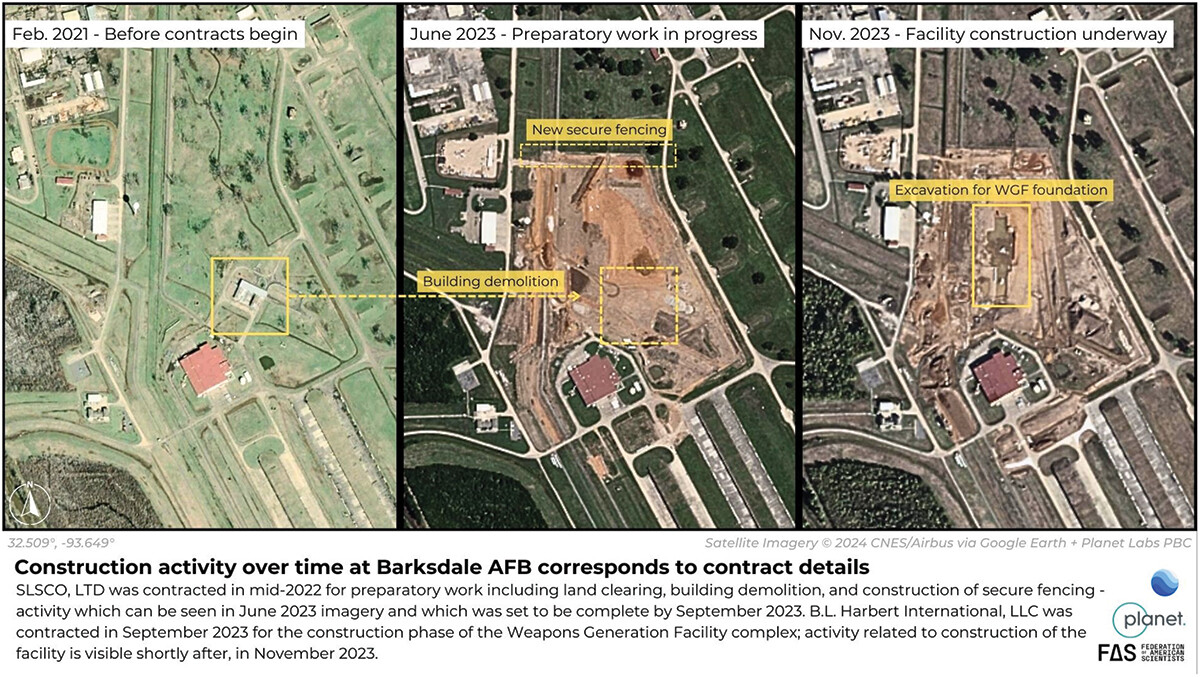
Nonstrategic nuclear weapons
The United States has only one type of nonstrategic nuclear weapon in its stockpile: the B61 gravity bomb. But it exists in several versions: the B61–3 and the B61–4 with yields varying from 0.3 kilotons up to 170 and 50 kilotons, respectively, and the new B61–12 entering the stockpile with a yield of up to 50 kilotons. All other previous versions have been retired. Approximately 200 such tactical B61 bombs are currently stockpiled (see Table 1). About 100 of these (versions −3 and − 4) are thought to be deployed at six bases in five European countries: Aviano and Ghedi in Italy; Büchel in Germany; Incirlik in Turkey; Kleine Brogel in Belgium; and Volkel in the Netherlands. This number has declined since 2009 partly due to reduction of operational storage capacity at Aviano and Incirlik (Kristensen 2015, 2019c). A seventh country—Greece—has a contingency nuclear strike mission and accompanying reserve squadron, but it does not host any nuclear weapons (Kristensen 2022b).
The other 100 B61 bombs are stored in the United States for backup and potential use by US fighter-bombers in support of allies outside Europe, including Northeast Asia. The fighter-bombers include F-15Es from the 391st Fighter Squadron of the 366th Fighter Wing at Mountain Home in Idaho (Carkhuff 2021).
Over the next few years, the new B61–12 will replace all legacy B61 bombs currently deployed in Europe and will be integrated onto US- and allied-operational tactical aircraft (Kristensen 2023b).
The Belgian, Dutch, German, and Italian air forces are currently assigned an active nuclear strike role with US nuclear weapons. Under normal circumstances, the nuclear weapons are kept under the control of US Air Force personnel; their use in war must be authorized by the US president. A 2022 NATO factsheet states that “a nuclear mission can only be undertaken after explicit political approval is given by NATO’s Nuclear Planning Group authorization is received from the US President and UK prime minister” (NATO 2022). However, it is unclear why the UK Prime Minister would have to authorize employment of US nuclear weapons, and unless NATO territory had been attacked with nuclear weapons first, it seems unlikely that the entire Nuclear Planning Group would be able to agree on approving the employment of non-strategic nuclear weapons from bases in Europe.
The Belgian and Dutch air forces currently use the F-16 aircraft for the nuclear missions, although both countries are in the process of obtaining the F-35A Lightning II to eventually replace their F-16s. Lockheed Martin presented the first F-35A for Belgium during a rollout ceremony in December 2023, during which Belgium’s Chief of Defense remarked that “the introduction of the F-35 … will enable us to continue to fulfil all our missions in the coming decades, in cooperation with our allies and partners in NATO, the EU and beyond” (Lockheed Martin 2023). The Italian Air Force uses the PA-200 Tornado for the nuclear mission but is also in the process of acquiring the F-35A. Like the Tornados, the nuclear F-35As will be based at Ghedi Air Base, which is currently being upgraded. Italy’s 6° Stormo (Wing) at Ghedi Air Base received its first F-35A in June 2022 (Cenciotti 2022). Germany also uses the PA-200 Tornado for the nuclear mission; however, it plans to retire its Tornados by 2030 and to replace them with 35 F-35A aircraft to continue the nuclear mission (US Department of Defense 2022b).
Incirlik Air Base in Turkey hosts approximately 20 to 30 B61 nuclear bombs for delivery by US aircraft or, in a contingency, Turkish F-16 aircraft. Unlike other NATO partners, Turkey does not allow the US to permanently base its aircraft at Incirlik; in a crisis, US aircraft would have to fly to the base to pick up the B61 bombs, or the bombs would have to be shipped out for use. In 2019, the Trump administration halted delivery of F-35As to Turkey—some of which were intended to take over the nuclear mission—because of its plans to acquire the Russian S-400 air-defense system (DeYoung, Fahim, and Demirjian 2019).
Despite the New York Times reporting in 2019 that US officials had reviewed emergency nuclear weapons evacuation plans for Incirlik (Sanger 2019), United States Air Force Europe A10 leaders visited Incirlik in July 2023 to discuss the “surety mission” and “the role that Incirlik plays in strategic deterrence,” indicating that the nuclear mission at Incirlik is still in effect (Myricks 2023). (“Surety” is a term commonly used by the Pentagon and the Department of Energy to refer to the capability to keep nuclear weapons safe, secure, and under positive control, whereas the “A10 office” is the Air Force’s office for “Strategic Deterrence and Nuclear Integration.”) This is further reinforced by ongoing infrastructure work at nuclear weapon storage sites in Turkey (US Department of Defense 2022c).
The United States withdrew nuclear weapons from the United Kingdom around 2007 after storing them at Royal Air Force (RAF) Lakenheath for several decades (Kristensen 2008). But increasing evidence over the past two to three years suggests that the United States may be returning its nuclear mission to UK soil (Korda and Kristensen 2023) (see Figure 3).
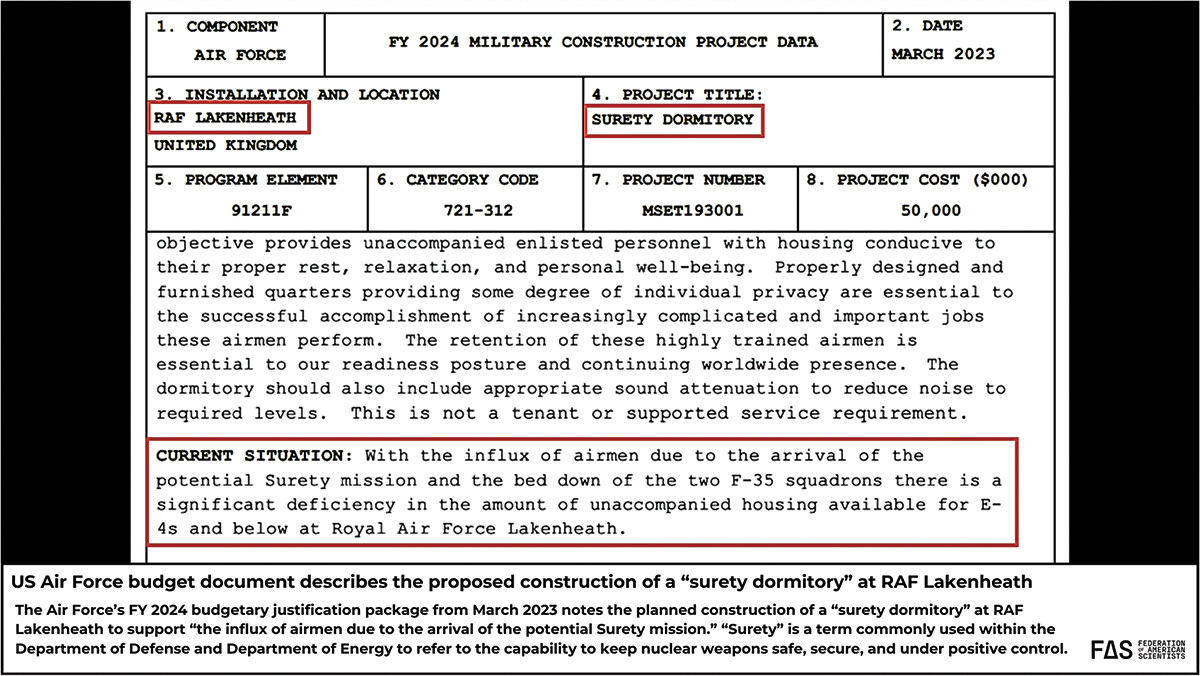
In addition to the mention of construction of a “surety dormitory” at RAF Lakenheath in USAF FY 2024 budget documents, The Telegraph in January 2024 described Pentagon contract documents that confirmed that the US Air Force intended to return the “nuclear mission” to the base (Diver 2024). Whether the US plans to permanently store nuclear weapons at RAF Lakenheath is unconfirmed, but it is clear that preparations are underway to reinstate the base’s capability to receive nuclear weapons, possibly to give NATO the option to redistribute its nuclear weapons in times of heightened tensions, or to potentially move them out of Turkey in the future (see Figure 4).
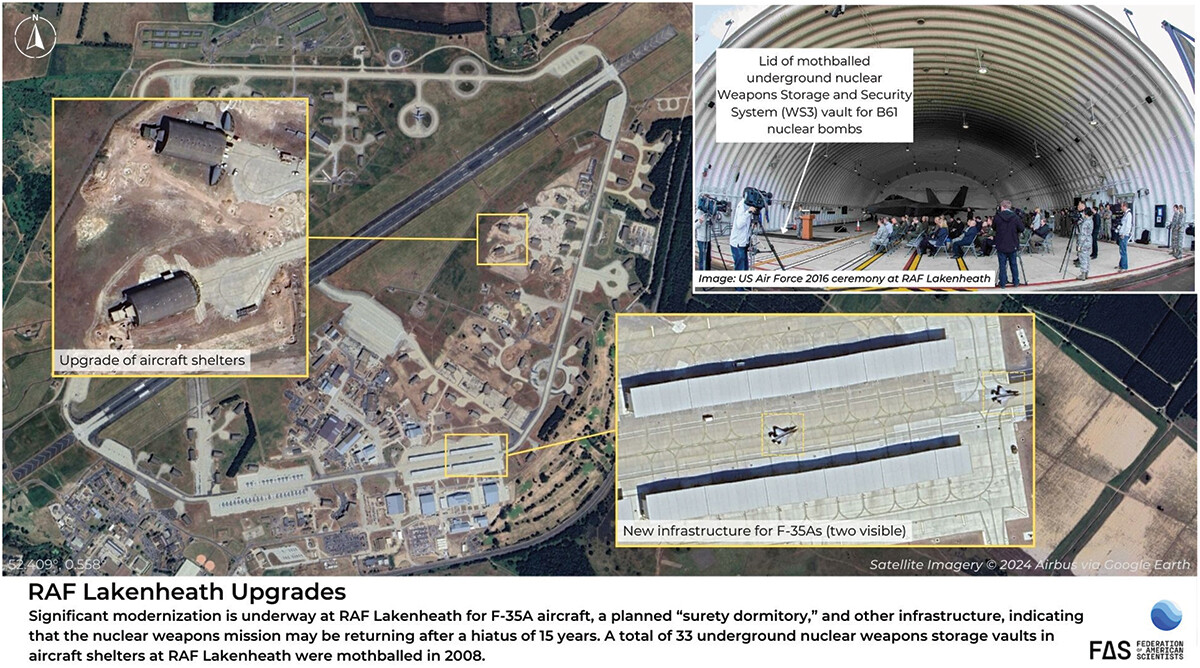
NATO Member States that do not host nuclear weapons can still participate in the nuclear mission as part of Conventional Support to Nuclear Operations (CSNO), previously known as Support of Nuclear Operations With Conventional Air Tactics, or SNOWCAT.
NATO is working on a broad modernization of the nuclear posture in Europe that involves upgrading bombs, aircraft, and the weapons storage system (Kristensen 2022b). The tactical B61–12 is identical to the strategic B61–12 assigned to the B-2 (and soon B-21) bombers. The B61–12 uses the nuclear explosive package of the B61–4, which has a maximum yield of approximately 50 kilotons and several lower-yield options. However, it will be equipped with a guided tail kit to increase accuracy and standoff capability, which will allow strike planners to select lower yields for existing targets to reduce collateral damage. The increased accuracy of the B61–12 will give the tactical bombs in Europe the same military capability as strategic bombs used by the bombers in the United States. Although the B61–12 has not been designed as a designated earth-penetrator, it does appear to have some limited earth-penetration capability that will increase the capability of the stockpile in Europe to hold at risk underground targets (Kristensen and McKinzie 2016). While the old PA-200 Tornado and F-16MLU jets will not be able to make use of the increased accuracy provided by the B61–12 tail kit, the F-15E and new F-35A will.
In March 2020, the F-15E became the first aircraft to be certified as technically capable of delivering the B61–12 bomb after completing the last in a series of six compatibility tests at Nellis Air Force Base (Nevada) and the Tonopah Test Range (Nevada) (Baker 2020). The F-35A followed in October 2021 after completing two drop B61–12 tests (US Air Force 2021). Sandia National Laboratories reported in 2023 that the F-35A, B-2A, and F-16A/B had all received initial certification of compatibility with the B61–12 (Sandia National Laboratories 2023). An image from Sandia National Laboratories seems to reveal that Volkel Air Base in the Netherlands started integration training of the B61–12 on its F-16 aircraft in 2021 (Kristensen 2023c), and in November 2023, Commander of the Dutch Air Combat Command Johan van Deventer announced on X (formerly Twitter) that the Netherlands had received “initial certification for the deterrence task with the F-35” from a US inspection team (Van Deventer 2023). Per a USAF announcement in February 2022, the US Secretary of Defense promised to deliver F-35A nuclear capability to NATO partners by January 2024 (Casem 2022). Finally, in October 2023, the F-35A achieved technical certification to carry the B61–12, clearing the way for US Air Force units in Europe to complete their nuclear surety certifications before ultimately receiving the new bombs (Marrow 2024a).
After the units in Europe receive their B61–12 certification, the new bomb is expected to be air-lifted to the bases and the old B61–3/4 bombs returned to the United States. A report that delivery of the B61–12 to Europe had been pushed up to December 2022 (Association Bender, McLeary, and Banco 2022) was denied by the Department of Defense (Johnson 2022).
In addition to weapons and aircraft, NATO’s nuclear modernization involves life-extending the weapons storage security system, including upgrading command and control, as well as security, at the six active bases (Aviano, Büchel, Ghedi, Kleine Brogel, Incirlik, and Volkel), one additional base (RAF Lakenheath), and one training base (Ramstein). Specifically, these upgrades include the installation of double-fence security perimeters, modernizing the weapon storage and security systems and the alarm communication and display systems, and the operation of new secure transportation and maintenance system trucks (Kristensen 2021). Security upgrades now appear to have been completed at Aviano, Incirlik, and Volkel, and are underway at Ghedi, Kleine Brogel, and Büchel. RAF Lakenheath will be the first USAF base in Europe equipped with the nuclear-capable F-35A (Korda and Kristensen 2023).
In addition to the modernization of weapons, aircraft, and bases, NATO also appears to be increasing the profile of the dual-capable aircraft posture. NATO is now publicly announcing its annual Steadfast Noon tactical nuclear weapons exercise. For example, NATO described in 2023 that the exercise involved the participation of 13 countries and 60 aircraft including fighter jets and US B-52 bombers (NATO 2023). Moreover, displays at nuclear bases have become more robust including with a so-called “elephant walk” of aircraft on the runway (US Air Force 2020a).
Finally, in addition to these ongoing upgrades, the United States is also considering developing a new non-strategic nuclear sea-launched cruise missile (SLCM-N). Initially proposed by the Trump administration’s Nuclear Posture Review in 2018 but canceled by the Biden administration’s 2022 Nuclear Posture Review, the US Congress has insisted on funding the weapon as what it calls a Program of Record—a budgeting term meaning that it has been approved with dedicated funding—including money for research for both the missile and warhead.
This research was carried out with generous contributions from the New-Land Foundation, the Prospect Hill Foundation, Longview Philanthropy, Ploughshares Fund, and individual donors.
Aftergood, S. 2019. “Pentagon Blocks Declassification of 2018 Nuclear Stockpile.” FAS Secrecy News , April 17. https://fas.org/blogs/secrecy/2019/04/stockpile-2018/
Air Force Global Strike Command Public Affairs. 2023a. “Minuteman III Test Launch Showcases Readiness of U.S. Nuclear force’s Safe, Effective Deterrent.” Air Force Global Strike Command , February 10. https://www.afgsc.af.mil/News/Article-Display/Article/3289352/minuteman-iii-test-launch-showcases-readiness-of-us-nuclear-forces-safe-effecti/
Air Force Global Strike Command Public Affairs. 2023b. “Minuteman III Test Launch Showcases Readiness of US Nuclear force’s Safe, Effective Deterrent.” Air Force Global Strike Command , April 19. https://www.afgsc.af.mil/News/Article-Display/Article/3367432/minuteman-iii-test-launch-showcases-readiness-of-us-nuclear-forces-safe-effecti/
Air Force Global Strike Command Public Affairs. 2023c. “Minuteman III Test Launch Showcases Readiness of U.S. Nuclear force’s Safe, Effective Deterrent.” Air Force Global Strike Command , September 16. https://www.afgsc.af.mil/News/Article-Display/Article/3516126/minuteman-iii-test-launch-showcases-readiness-of-us-nuclear-forces-safe-effecti/
Air Force Global Strike Command Public Affairs. 2023d. “Minuteman III Test Provides Vital Data Before Termination.” Air Force Global Strike Command , November 1. https://www.afgsc.af.mil/News/Article-Display/Article/3575636/minuteman-iii-test-provides-vital-data-before-termination/
Air Force Nuclear Weapons Center Public Affairs. 2023. “Air Force Conducts Second Sentinel Static Fire Test.” Air Force Nuclear Weapons Center , March 6. https://www.afnwc.af.mil/News/Article-Display/Article/3319317/air-force-conducts-sentinel-static-fire-test/
Air Force Nuclear Weapons Center Public Affairs. 2024. “Air Force Conducts Second Sentinel Static Fire Test.” Air Force Nuclear Weapons Center , January 12. https://www.afnwc.af.mil/News/Article-Display/Article/3644827/air-force-conducts-second-sentinel-static-fire-test/
Airforce Technology. 2022. “Raytheon Declares IOC for USAF’s Global ASNT System.” August 11. https://www.airforce-technology.com/news/raytheon-usafs-global-asnt-system/?cf-view
Arkin, W. M., and M. Ambinder. 2022a. “Exclusive: Ukraine Crisis Could Lead to Nuclear War Under New Strategy.” Newsweek , February 4. https://www.newsweek.com/exclusive-ukraine-crisis-could-lead-nuclear-war-under-new-strategy-1676022
Arkin, W. M., and M. Ambinder. 2022b. “Nuclear Weapons and the Ukraine Crisis.” Secrets Machine , January 28. https://www.secretsmachine.com/p/stratcoms-global-lightning-nuclear
Arkin, W. M., and H. M. Kristensen. 2020. “US Deploys New Low-Yield Nuclear Submarine Warhead.” FAS Strategic Security (blog) . January 29. https://fas.org/blogs/security/2020/01/w76-2deployed/
Arms Control Association. 2017. “The Trillion (And a Half) Dollar Triad?” Arms Control Today 9: 6 August 18. https://www.armscontrol.org/issue-briefs/2017-08/trillion-half-dollar-triad
Association Bender, B., P. McLeary, and E. Banco. 2022. “U.S. Speeds Up Plans to Store Upgraded Nukes in Europe.” Politico , October 26. https://www.politico.com/news/2022/10/26/u-s-plans-upgraded-nukes-europe-00063675
Baker, M. 2020. “B61-12 Compatible with F-15E Strike Eagle.” Sandia Lab News 72: 11 (June 5): 5. https://www.sandia.gov/app/uploads/sites/81/2021/06/labnews_06-05-20.pdf
Bartolomei, J. 2021. “Sustaining and Modernizing Ballistic Missile Operations.” Paper presented at the Air & Space Force Association’s Doolittle Leadership Center Virtual Forum, Arlington, VA, June 14. https://www.youtube.com/watch?v=nRC0RRA975A&ab_channel=AirForce
Breedlove, P. 2015. “Statement of General Philip Breedlove, Commander, U.S. Forces Europe.” February 25. https://docshouse.gov/meetings/AS/AS00/20150225/103011/HHRG-114AS00WstateBreedloveUSAFP-20150225.pdf
Capaccio, A. 2020. “U.S. ICBM to Replace 1970s Minuteman May Cost $111 Billion.” Bloomberg , October 1. https://www.bloomberg.com/news/articles/2020-10-01/pentagon-s-next-generation-icbm-program-may-cost-111-billion
Capaccio, A. 2021. “Under-Wraps B-21 Bomber Is Seen Costing $203 Billion into 2050s.” Bloomberg Government , November 17. https://www.bloomberg.com/news/articles/2021-11-17/under-wraps-b-21-bomber-is-seen-costing-203-billion-into-2050s
Carkhuff, J. 2021. “F-15E’s [Sic] Take Part in Dual-Capable Aircraft NucWSEP.” Air Combat Command Public Affairs , November 19. https://www.acc.af.mil/News/Article/2849457/f-15es-take-part-in-dual-capable-aircraft-nucwsep/
Casem, G. 2022. “F-35 ITF’s Dual Capable Aircraft Team Wins National Aviation Award.” Edwards Air Force Base , February 17. https://www.edwards.af.mil/News/Article/2940015/f-35-itfs-dual-capable-aircraft-team-wins-national-aviation-award/
Cenciotti, D. 2022. “First F-35A Officially Delivered to the 6° Stormo at Ghedi Air Base.” The Aviationist , June 16. https://theaviationist.com/2022/06/16/f-35a-delivered-to-ghedi/
Clark, R. 2019. “Fiscal Year 2020 Priorities for U.S. Department of Defense Nuclear Priorities.” Testimony to the House Subcommittee on Strategic Forces, Rayburn 2118, March 28. https://armedservices.house.gov/hearings?ID=FA8DBDAB-5585-4437AF88-61FBB1B7D428
Congressional Budget Office. 2017. “Approaches for Managing the Costs of U.S. Nuclear Forces, 2017 to 2046.” October 1. https://www.cbo.gov/system/files/115th-congress-2017-2018/reports/53211-nuclearforces.pdf
Congressional Budget Office. 2019. “Projected Costs of U.S. Nuclear Forces 2019–2028.” January 24. https://www.cbo.gov/system/files/2019-01/54914-NuclearForces.pdf
Congressional Budget Office. 2021. “Projected Costs of U.S. Nuclear Forces 2021–2030.” May. https://www.cbo.gov/system/files/2021-05/57130-Nuclear-Forces.pdf
Congressional Budget Office. 2023. “Projected Costs of U.S. Nuclear Forces 2023–2032.” July. https://www.cbo.gov/system/files/2023-07/59054-nuclear-forces.pdf
Congressional Research Service. 2000. “Electric-Drive Propulsion for U.S. Navy Ships: Background and Issues for Congress.” July 31. https://www.everycrsreport.com/files/20000731_RL30622_c288e8b1829d574fffb93ddf56d0891b36cff9fc.pdf
Congressional Research Service. 2022. “Navy Columbia (SSBN-826) Class Ballistic Missile Submarine Program: Background and Issues for Congress.” February 22. https://fas.org/sgp/crs/weapons/R41129.pdf
Congressional Research Service. 2024. “Navy Columbia (SSBN-826) Class Ballistic Missile Submarine Program: Background and Issues for Congress.” March 1. https://sgp.fas.org/crs/weapons/R41129.pdf
Copp, T. 2023. “Nuclear Stealth Bomber, the B-21 Raider, Takes First Test Flight.” Defense News , November 10. https://www.defensenews.com/air/2023/11/10/nuclear-stealth-bomber-the-b-21-raider-takes-first-test-flight/
Dalton, T., M. DuBois, N. Montoya, A. Panda, and G. Perkovich. 2022. “Assessing U.S. Options for the Future of the ICBM Force: Report to the Office of the Under Secretary of Defense for Policy.” Carnegie Endowment for International Peace , August. https://carnegieendowment.org/files/ICBM_DOD_final.pdf
Decker, A. 2024. “Air Force Sticking with Sentinel Despite Huge Cost Breach, Officials Say.” Defense One , January 24. https://www.defenseone.com/technology/2024/01/air-force-sticking-sentinel-despite-huge-cost-breach-officials-say/393600/
Demarest, C. 2021. “Plutonium Pit Production in SC Might Happen in 2035. The Target Was 2030.” Aiken Standard , June 12. https://www.postandcourier.com/aikenstandard/news/plutonium-pit-production-in-sc-might-happen-in-2035-the-target-was-2030/article_96e0b392-cada-11eb-a047-6fbc3e70d188.html
DeYoung, K., K. Fahim, and K. Demirjian. 2019. “Trump Says US. Will Cancel Turkey’s Purchase of F-35 Planes.” The Washington Post , July 16. https://www.washingtonpost.com/national-security/trump-says-us-will-cancel-turkeys-purchase-of-russian-antimissile-system/2019/07/16/4921da04-a710-11e9-86dd-d7f0e60391e9_story.html
Diver, T. 2024. “US to Station Nuclear Weapons in UK to Counter Threat from Russia.” The Telegraph , January 26. https://www.telegraph.co.uk/world-news/2024/01/26/us-nuclear-bombs-lackenheath-raf-russia-threat-hiroshima/
Draper Laboratory. 2006. Keeping trident ever ready. Explorations, spring, . 8. https://www.nuclearinfo.org/wp-content/uploads/2020/09/Keeping-Trident-Ever-Ready.pdf
Eckstein, M. 2019. “Navy Beginning Tech Study to Extend Trident Nuclear Missile into the 2080s.” US Naval Institute News , November 14. https://news.usni.org/2019/11/14/navy-beginning-tech-study-to-extend-trident-nuclear-missile-into-the-2080s
Eckstein, M. 2020. “COVID Pandemic a Barrier to Navy’s Oversight of Columbia Submarine Industrial Base; PEO Working on Virtual Oversight.” US Naval Institute News , June 2. https://news.usni.org/2020/06/02/covid-pandemic-a-barrier-to-navys-oversight-of-columbia-submarine-industrial-base-peo-working-on-virtual-oversight
Erwin, S. 2023. “Air Force Awards Raytheon $625 Million Contract for Nuclear-Hardened Satcom Terminals.” Space News , June 29. https://spacenews.com/air-force-awards-raytheon-625-million-contract-for-nuclear-hardened-satcom-terminals/
Faulconbridge, G. 2023. “Putin Escalates Ukraine War, Issues Nuclear Threat to West.” Reuters , September 21. https://www.reuters.com/world/europe/putin-signs-decree-mobilisation-says-west-wants-destroy-russia-2022-09-21/
Government Accountability Office. 2020. “NNSA Should Further Develop Cost, Schedule, and Risk Information for the W87-1 Warhead Program.” GAO-20-703, September. https://www.gao.gov/assets/710/709253.pdf
Government Accountability Office. 2022. “Weapon System Annual Assessment.” GAO-22–105230. June. https://www.gao.gov/assets/gao-22-105230.pdf
Government Accountability Office. 2023a. “Weapon System Annual Assessment.” GAO-23106059. June. https://www.gao.gov/assets/gao-23-106059.pdf
Government Accountability Office. 2023b. “Columbia Class Submarines: Program Lacks Essential Schedule Insight Amid Continuing Construction Challenges.” January. https://www.gao.gov/assets/gao-23-106292.pdf
Government of the United Kingdom. 2021. “The United Kingdom’s Future Nuclear Deterrent: The 2021 Update to Parliament.” December 16. https://www.gov.uk/government/publications/the-united-kingdoms-future-nuclear-deterrent-the-2021-update-to-parliament/the-united-kingdoms-future-nuclear-deterrent-the-2021-update-to-parliament
Harpley, U. L. 2024. “B-21 Raider Starts Test Flights Out of Edwards Air Force Base.” Air and Space Forces Magazine , January 18. https://www.airandspaceforces.com/b-21-raider-test-flight-edwards/
Heckmann, L. 2023. “Sentinel System: ‘There is No Backup Plan.” National Defense , November 8. https://www.nationaldefensemagazine.org/articles/2023/11/8/sentinel-system-there-is-no-backup-plan
Heritage Foundation. 2023. “The Strategic Posture Commission: Defending America in a Modern World.” Heritage.org , November 30. https://www.heritage.org/defense/event/the-strategic-posture-commission-defending-america-modern-world
Hudson Institute. 2023. “A Discussion with Commissioners of the Final Report of the US Strategic Posture Commission.” Hudson.org , October 23. https://www.hudson.org/events/discussion-commissioners-final-report-us-strategic-posture-commission
Hughes, R. 2019. “Boeing Contracted to Integrate LRSO Cruise Missile with the B-52H Bomber.” Jane’s 360 , March 15. https://www.janes.com/defence-news/news-detail/boeing-contracted-to-integrate-lrso-cruise-missile-with-the-b-52h-bomber
Hyten, J. 2017. “Military Reporters and Editors Association Conference, Keynote Speech, US Strategic Command.” March 31. http://www.stratcom.mil/Media/Speeches/Article/1153029/military-reporters-and-editors-association-conference-keynote-speech/
Institute for Defense Analyses. 2019. “Independent Assessment of the Two-Site Pit Production Decision: Executive Summary.” May. https://www.ida.org/-/media/feature/publications/i/in/independent-assessment-of-the-two-site-pit-production-decision-executive-summary/d-10711.ashx
Johnson, R. C. 2022. “Deputy Assistant Secretary of Defense for Nuclear and Countering Weapons of Mass Destruction Policy.” Statement at Carnegie International Nuclear Policy Conference, Washington DC, October 28. https://ceipfiles.s3.amazonaws.com/pdf/NPC22/Parsing+the+2022+U.S.+Nuclear+Posture+Review.pdf
Knight, M. 2024a. “Construction Of New Nuclear Weapons Facility At Barksdale AFB.” FAS Strategic Security (blog) . February 20. https://fas.org/publication/new-barksdale-construction-2024/
Knight, M. 2024b. “‘Critical’ Overrun Of Sentinel ICBM Program Demands Government Transparency.” FAS Strategic Security (blog) . February 2. https://fas.org/publication/critical-sentinel-overrun/
Koch, S. 2012. The Presidential Nuclear Initiatives of 1991- 1992 . Washington D.C: National Defense University. September 40.
Korda, M. 2020. “Environmental Assessment Reveals New Details about the Air Force’s ICBM Replacement Plan.” FAS Strategic Security blog , November 3. https://fas.org/blogs/security/2020/11/environmental-assessment-reveals-new-details-about-the-air-forces-icbm-replacement-plan/
Korda, M. 2021. “Siloed Thinking: A Closer Look at the Ground-Based Strategic Deterrent.” Federation of American Scientists , March. https://man.fas.org/eprint/siloed-thinking.pdf
Korda, M., and H. M. Kristensen. 2023. “Increasing Evidence That The US Air Force’s Nuclear Mission May Be Returning To UK Soil.” FAS Strategic Security (blog) . August 28. https://fas.org/publication/increasing-evidence-that-the-us-air-forces-nuclear-mission-may-be-returning-to-uk-soil/
Korda, M., and T. White. 2021. “The U.S. Intercontinental Ballistic Missile Force: A Post-Cold War Timeline.” Federation of American Scientists , March 24. https://fas.org/publication/icbm-info-timeline/
Kristensen, H. M. 2008. “U.S. Nuclear Weapons Withdrawn From The United Kingdom.” FAS Strategic Security (blog) . June 26. https://fas.org/publication/us-nuclear-weapons-withdrawn-from-the-united-kingdom/
Kristensen, H. M. 2011a. “British Submarines to Receive Upgraded US Nuclear Warhead.” FAS Strategic Security blog , April 1. https://fas.org/blogs/security/2011/04/britishw76-1/
Kristensen, H. M. 2011b. “When the Boomers Went to South Korea.” FAS Strategic Security blog , October 4. https://fas.org/blogs/security/2011/10/ssbnrok/
Kristensen, H. M. 2015. “Upgrades at US Nuclear Bases in Europe Acknowledge Security Risk.” FAS Strategic Security blog , September 10. https://fas.org/blogs/security/2015/09/nuclear-insecurity/
Kristensen, H. M. 2017a. “B-52 Bomber No Longer Delivers Nuclear Gravity Bombs.” FAS Strategic Security blog , May 25. https://fas.org/blogs/security/2017/05/b-52-bombs/
Kristensen, H. M. 2017b. “The Flawed Push for New Nuclear Weapons Capabilities.” FAS Strategic Security Blog , June 29. https://fas.org/blogs/security/2017/06/new-nukes/
Kristensen, H. M. 2017c. “USAF Plans To Expand Nuclear Bomber Bases.” FAS Strategic Security blog , November 17. https://fas.org/blogs/security/2020/11/usaf-plans-to-expand-nuclear-bomber-bases/
Kristensen, H. M. 2018. “US SSBN Patrols Steady, But Mysterious Reduction In Pacific In 2017.” May 24. https://fas.org/blogs/security/2018/05/ssbnpatrols1960-2017/
Kristensen, H. M. 2019a. “Pentagon Slams Door on Nuclear Weapons Stockpile Transparency.” FAS Strategic Security Blog , April 17. https://fas.org/blogs/security/2019/04/stockpilenumbersecret/
Kristensen, H. M. 2019b. “Urgent: Move US Nuclear Weapons Out of Turkey.” FAS Strategic Security blog , October 16. https://fas.org/blogs/security/2019/10/nukes-out-of-turkey/
Kristensen, H. M. 2020a. “Construction of New Underground Nuclear Warhead Facility at Warren AFB.” FAS Strategic Security blog , September 28. https://fas.org/blogs/security/2020/09/warren-underground-facility/
Kristensen, H. M. 2020b. “USAF Plans to Expand Nuclear Bomber Bases,” FAS Strategic Security blog , November 17. https://fas.org/blogs/security/2020/11/usaf-plans-to-expand-nuclear-bomber-bases
Kristensen, H. M. 2021. “NATO Nuclear Weapons Exercise Over Southern Europe.” FAS Strategic Security blog , October 20. https://fas.org/blogs/security/2021/10/steadfastnoon2021/
Kristensen, H. M. (@nukestrat). 2022a. “I Guess Previous Constraints on Offensive Bomber Operations are Over: One of the B-52 Bombers (60-0026) Makes a Run past Tallin toward St Petersburg, to Less than 30 Km from the Russian Border. Credit: Stockholm Overflight Video by @adampahlmant.” Twitter, September 2. https://twitter.com/nukestrat/status/1565658917056692225
Kristensen, H. M. 2022b. “NATO Steadfast Noon Exercise and Nuclear Modernization in Europe.” FAS Strategic Security blog , October 17. https://fas.org/blogs/security/2022/10/steadfast-noon-exercise-and-nuclear-modernization/
Kristensen, H. M. (@nukestrat). 2022c. “The Two B-52 Bombers that Operated over Sweden Earlier Today Included One nuclear-capable (60-0026) and One Denuclearized Version (60-0034). This Is the First Bomber Overflight of Sweden since It Applied for NATO Membership.” Twitter, August 18. https://twitter.com/nukestrat/status/1560303040053366786
Kristensen, H. M. (@nukestrat). 2023a. “After the Gulf of Finland signaling, the B-52 (60-0026, NOBLE62) flies south over Baltic States, then along Kaliningrad. Quite a mission today.” Twitter, March 11. https://twitter.com/nukestrat/status/1634643985309351936
Kristensen, H. M. 2023b. “The C-17A Has Been Cleared To Transport B61-12 Nuclear Bomb To Europe.” FAS Strategic Security blog , January 9. https://fas.org/publication/c17-cleared-to-transport-b61-12/
Kristensen, H. M. 2023c. “New Nuclear Bomb Training At Dutch Air Base.” FAS Strategic Security blog , December 13. https://fas.org/publication/new-nuclear-bomb-training-at-dutch-air-base/
Kristensen, H. M. 2023d. “While Advocating Nuclear Transparency Abroad, Biden Administration Limits It At Home.” FAS Strategic Security blog , July 31. https://fas.org/publication/while-advocating-nuclear-transparency-abroad-biden-administration-limits-it-at-home/
Kristensen, H. M., and M. Korda. 2019. “United States Nuclear Forces.” The Bulletin of the Atomic Scientists 75 (3): 122–134. https://www.tandfonline.com/doi/full/10.1080/00963402.2019.1606503
Kristensen, H. M., and M. Korda. 2022. “The 2022 Nuclear Posture Review: Arms Control Subdued By Rivalry.” FAS Strategic Security blog , October 27. https://fas.org/blogs/security/2022/10/2022-nuclear-posture-review/
Kristensen, H. M., and M. Korda. 2023. “Biden Administration Decides To Build A New Nuclear Bomb To Get Rid Of An Old Bomb.” FAS Strategic Security blog , October 27. https://fas.org/publication/biden-administration-to-build-a-new-nuclear-bomb/
Kristensen, H. M., and M. McKinzie. 2016. “Video Shows Earth-Penetrating Capability of B61-12 Nuclear Bomb.” FAS Strategic Security blog , January 14. https://fas.org/blogs/security/2016/01/b61-12_earth-penetration/
Kristensen, H. M., M. McKinzie, and T. A. Postol. 2017. “How US Nuclear Force Modernization is Undermining Strategic Stability: The Burst-Height Compensating Super-Fuze.” Bulletin of the Atomic Scientists , March 1. https://thebulletin.org/how-us-nuclear-force-modernization-undermining-strategic-stability-burst-height-compensating-super10578
Leone, D. 2022. “Two-Year Delay for First LRSO Warhead, but NNSA Says Will Still Deliver On-Time to Air Force.” Defense Daily , August 4. https://www.defensedaily.com/two-year-delay-for-first-lrso-warhead-but-nnsa-says-will-still-deliver-on-time-to-air-force/uncategorized/
Lockheed Martin. 2023. “Belgium And Lockheed Martin Celebrate Rollout Of First F-35A For Belgium.” December 10. https://news.lockheedmartin.com/2023-12-10-Belgium-and-Lockheed-Martin-Celebrate-Rollout-of-First-F-35A-for-Belgium
Marrow, M. 2024a. “EXCLUSIVE: F-35A officially certified to carry nuclear bomb.” Breaking Defense , March 8. https://breakingdefense.com/2024/03/exclusive-f-35a-officially-certified-to-carry-nuclear-bomb/
Marrow, M. 2024b. “Northrop Grumman logs billion-dollar charge on B-21 stealth bomber.” Breaking Defense , January 25. https://breakingdefense.com/2024/01/northrop-grumman-logs-billion-dollar-charge-on-b-21-stealth-bomber/
Mehta, A. 2020. “DoD Seeks Legislative Help for ICBM Replacement Construction Costs.” Defense News , September 25. https://www.defensenews.com/smr/nuclear-arsenal/2020/09/25/dod-seeking-legislative-help-for-icbm-replacement-construction-costs/
Miller, M., and N. Perez. 2023. “Environmental analysis clears Sentinel missile infrastructure construction for takeoff.” Air Force Civil Engineer Center , May 23. https://www.afcec.af.mil/News/Article-Display/Article/3404042/environmental-analysis-clears-sentinel-missile-infrastructure-construction-for/
Mongilio, H. 2023. “USS Kentucky Make Port Call in South Korea, First SSBN Visit in 40 Years.” USNI News , July 18. https://news.usni.org/2023/07/18/uss-kentucky-calls-in-south-korea-first-ssbn-visit-in-40-years
Moulton, J. 2022.“A Treater View on the Nuclear Sea- Launched Cruise Missile (SLCM-N).” Council on Strategic Risks , Briefer No. 37, November 16. https://councilonstrategicrisks.org/wp-content/uploads/2022/11/37-SLCM-Optionality-Warfighting.pdf
Myricks, E. 2023. “USAFE Senior Leaders Visit Incirlik.” Incirlik Air Base , July 21. https://www.incirlik.af.mil/News/Article-Display/Article/3466508/usafe-senior-leaders-visit-incirlik/
NATO. 2022. “NATO’s Nuclear Sharing Arrangements.” February. https://www.nato.int/nato_static_fl2014/assets/pdf/2022/2/pdf/220204-factsheet-nuclear-sharing-arrange.pdf
NATO. 2023. “U.S. B-52 Bomber Supports NATO Exercise Steadfast Noon in Transatlantic Mission.” October 26. https://ac.nato.int/archive/2023/US_B52_BTF_NATO
Naval Surface Warfare Center. 2008. “Underwater Wonder, Submarines: A Powerful Deterrent.” Crane Division, Indiana. Warfighter Solutions, 14.
News Center 1. 2022. “The B-21 Mission May Be Bigger for Ellsworth than Previously Thought.” October 28. https://www.newscenter1.tv/the-b-21-mission-may-be-bigger-for-ellsworth-than-previously-thought/
NNSA. 2020. “First Production Capability Unit Marks B61-12 Modernization Milestone at Pantex.” National Nuclear Security Administration, Department of Energy , September 10. https://www.energy.gov/nnsa/articles/first-production-capability-unit-marks-b61-12-modenization-milestone-pantex
NNSA. 2021a. “NNSA Approves Critical Decision 1 for Savannah River Plutonium Processing Facility.” National Nuclear Security Administration, Department of Energy , June 28. https://www.energy.gov/nnsa/articles/nnsa-approves-critical-decision-1-savannah-river-plutonium-processing-facility
NNSA. 2021b. “NNSA Completes First Production Unit of W88 Alteration 370.” National Nuclear Security Administration, Department of Energy , July 13. https://www.energy.gov/nnsa/articles/nnsa-completes-first-production-unit-w88-alteration-370
NNSA. 2022. “Email to Hans M. Kristensen.” National Nuclear Security Administration, Department of Energy . October 27.
NNSA. 2023. “Fiscal Year 2024 Stockpile Stewardship and Management Plan: Biennial Plan Summary.” National Nuclear Security Administration, Department of Energy , November. https://www.energy.gov/sites/default/files/2023-11/FY24SSMP_FINAL_NOVEMBER_2023_0.pdf
Northrop Grumman. 2024. “Sentinel – GBSD (Ground-Based Strategic Deterrent) – ICBM (Intercontinental Ballistic Missile) – LGM-35A.” February 20. https://news.northropgrumman.com/news/releases/northrop-grumman-advances-sentinel-design-phase-with-key-tests
Pampe, C. 2012. “Life Extension Programs Send Missiles into the Future.” US Air Force Global Strike Command , October 26. https://www.20af.af.mil/News/Article-Display/Article/457746/life-extension-programs-send-missiles-into-the-future/
Postol, T. A. 2014. “How the Obama Administration Learned to Stop Worrying and Love the Bomb.” The Nation , December 10. http://www.thenation.com/print/article/192633/how-obama-administration-learned-stop-worrying-and-love-bomb
Puget Sound Naval Shipyard & Intermediate Maintenance Facility (PSNS & IMF Public Affairs). 2023. “Louisiana back underway: Project team completes the final engineered refueling overhaul for an Ohio-class ballistic missile submarine.” Naval Sea Systems Command , March 8. https://www.navsea.navy.mil/Media/News/Article/3315248/louisiana-back-underway-project-team-completes-the-final-engineered-refueling-o/
Reilly, B. 2021. “ICBM Fuze Program Now Expected to Enter full-rate Production in FY-24.” Inside Defense , September 7. https://insidedefense.com/daily-news/icbm-fuze-program-now-expected-enter-full-rate-production-fy-24
Rucker, J. 2019. “Discussion on the Columbia Class Submarine and GBSD.” Presentation at the Triad Symposium, Washington, DC, Capitol Hill Club, October 8.
Sandia National Laboratories. 2023. “2023 Labs Accomplishments: Nuclear Deterrence.” Sandia Lab News . https://www.sandia.gov/news/publications/labs-accomplishments/article/2023/nuclear-deterrence-6/
Sanger, D. 2019. “Trump Followed His Gut on Syria. Calamity Came Fast.” The New York Times , October 14. https://www.nytimes.com/2019/10/14/world/middleeast/trump-turkey-syria.html
Scapparotti, C. M. 2017. “Statement of General Curtis M. Scaparrotti, Commander, United States European Command.” House Armed Services Committee, March 23. https://www.armed-services.senate.gov/imo/media/doc/Scaparrotti_03-23-17.pdf
Sirota, S. 2020. “GBSD Requires 20 New Launch Facilities, Missiles Equipped with Legacy Warheads by FY-29.” Inside Defense , August 3. https://insidedefense.com/daily-news/gbsd-requires-20-new-launch-facilities-missiles-equipped-legacy-warheads-fy-29
Tester, J. 2023. “Tester Authorizes Major Defense Wins Including $10 Million for Malmstrom & $30 Million for Montana Air Guard, Pay Raises for Troops.” Tester.Senate.gov , December 13. https://www.tester.senate.gov/newsroom/press-releases/tester-authorizes-major-defense-wins-including-10-million-for-malmstrom-30-million-for-montana-air-guard-pay-raises-for-troops/
Thropp, C. 2023. “HASC Chairman Mike Rogers Highlights Results of Strategic Posture Commission Report.” ExecutiveGov.com , October 13. https://executivegov.com/2023/10/hasc-chairman-mike-rogers-highlights-results-of-strategic-posture-commission-report/
Tirpak, J. A. 2020. “A New Bomber Vision.” Air Force Magazine , June 1. https://www.airforcemag.com/article/strategy-policy-9/
Tirpak, J. A. 2022a. “First B-21 Moves to New Hangar for Loads Calibration.” Air Force Magazine , March 3. http://www.airforcemag.com/first-b-21-moves-to-new-hangar-for-loads-calibration/
Tirpak, J. A. 2022b. “Some B-21 Bomber Facilities at Ellsworth to Be Ready for 2024.” Air Force Magazine , April 21. https://www.airandspaceforces.com/some-b-21-bomber-facilities-at-ellsworth-to-be-ready-for-2024/
Tirpak, J. A. 2024. “New ICBM Has ‘Critical’ Cost and Schedule Overruns, Needs SecDef Certification to Continue.” Air and Space Forces Magazine , January 18. https://www.airandspaceforces.com/new-icbm-critical-cost-schedule-overruns/
UK Ministry of Defence. 2015. “Freedom of Information Act Response to [Redacted].” October 13. https://assets.publishing.service.gov.uk/government/uploads/system/uploads/attachment_data/file/470321/20151013-FOI_2015_07375.pdf
US Air Force. 2016. “AF Reaches First Milestone in Acquisition of New ICBM.” Air Force Nuclear Weapons Council Public Affairs Office, September 1. http://www.kirtland.af.mil/News/Article-Display/Article/933565/af-reaches-first-milestone-in-acquisition-of-new-icbm
US Air Force. 2019a. “Air Force Announces Ellsworth as First B-21 Base.” 509th Bomb Wing Public Affairs , March 29. https://www.whiteman.af.mil/News/Article/1799968/air-force-announces-ellsworth-as-first-b-21-base/
US Air Force. 2019b. “US Department of Defense Fiscal Year (FY) 2020 Budget Estimates, Air Force Justification Book Volume 2 of 3: Research, Development, Test & Evaluation, Air Force Vol−II, February, 691.” https://www.saffm.hq.af.mil/Portals/84/documents/FY20/RDTE/FY20_PB_RDTE_Vol-II.PDF?ver=2019-03-18-153506-683
US Air Force. 2019c. “US Department of Defense Fiscal Year (FY) 2020 President’s Budget Submission, Air Force Justification Book Volume 3b, Research, Development, Test & Evaluation, Air Force, Volume III, Part 2, February, 3b–769.” https://www.saffm.hq.af.mil/Portals/84/documents/FY20/RDTE/FY20_PB_RDTE_Vol-IIIb.pdf?ver=2019-03-18-153459-043
US Air Force. 2019d. “USACE Contract Awarded to Fluor Corporation.” 90th Missile Wing Public Affairs , May 23. https://www.warren.af.mil/News/Article/1857157/usace-contract-awarded-to-fluor-corporation/
US Air Force. 2020a. “Aviano Elephant Walk.” June 5. https://www.aviano.af.mil/Articles/Photos/igphoto/2002311011/
US Air Force. 2020b. “Environmental Impact Statement for the Ground-Based Strategic Deterrent Deployment and Minuteman III Decommissioning and Disposal: Public Scoping Materials.” Air Force Global Strike Command , September 29. https://drive.google.com/file/d/1BQXd36ek8EispPEPOCvAz8O8Jt9aP02w/view
US Air Force. 2021. “F-35A Complete 5th Generation Fighter Test Milestone with Refurbished B61-12 Nuclear Gravity Bombs.” 53rd Wing, October 6. https://www.af.mil/News/Article-Display/Article/2801860/f-35a-complete-5th-generation-fighter-test-milestone-with-refurbished-b61-12-nu/
US Air Force. 2022a. “Air Force’s New Intercontinental Ballistic Missile System Has a Name: Sentinel.” Secretary of the Air Force Public Affairs , April 5. https://www.af.mil/News/Article-Display/Article/2990069/air-forces-new-intercontinental-ballistic-missile-system-has-a-name-sentinel/
US Air Force. 2022b. “B-21 Bomber to Be Unveiled Dec. 2.” Secretary of the Air Force Public Affairs , October 20. https://www.af.mil/News/Article-Display/Article/3164776/b-21-bomber-to-be-unveiled-dec-2/
US Air Force. 2022c. “Barksdale AFB First to Implement Upgrade to Nuclear Enterprise in More than 30 Years.’” 2nd Bomb Wing Public Affairs , February 23. https://www.af.mil/News/Article-Display/Article/2943340/barksdale-afb-first-to-implement-upgrade-to-nuclear-enterprise-in-more-than-30/
US Air Force. 2022d. “Draft Environmental Impact Statement for the Ground Based Strategic Deterrent Deployment and Minuteman III Decommissioning and Disposal.” Air Force Global Strike Command , July. https://drive.google.com/file/d/1aKCcvEq92PdKShP5qWzIxrvwNN9P7zo7/view
US Air Force. 2023a. “5th Bomb Wing carries out Exercise Prairie Vigilance 24-1.” Air Force Global Strike Command , October 30. https://www.afgsc.af.mil/News/Article-Display/Article/3575119/5th-bomb-wing-carries-out-exercise-prairie-vigilance-24-1/
US Air Force. 2023b. “Annual Report on Highest and Lowest Performing Acquisition Programs.” Office of the Assistant Secretary for Space Acquisition and Integration, February. https://insidedefense.com/sites/insidedefense.com/files/documents/2023/may/05302023_af806.pdf
US Air Force. 2023c. “Final Environmental Impact Statement for the Sentinel (GBSD) Deployment and Minuteman III Decommissioning and Disposal.” Air Force Global Strike Command , March. https://www.afgsc.af.mil/Portals/51/Docs/Sentinel/Sentinel%20FEIS%20-%20Volume%20I%20Final%20EIS%20March%202023.pdf?ver=9hr8vgh9qqkm934XersFcg%3d%3d
US Air Force. 2023d. “Global Thunder 23 concludes at Minot.” Air Force Global Strike Command , April 20. https://www.afgsc.af.mil/News/Article-Display/Article/3373381/global-thunder-23-concludes-at-minot/
US Air Force. 2023e. “Minuteman III test launch showcases readiness of U.S. nuclear force’s safe, effective deterrent.” Air Force Global Strike Command Public Affairs , September 6. https://www.afgsc.af.mil/News/Article-Display/Article/3516126/minuteman-iii-test-launch-showcases-readiness-of-us-nuclear-forces-safe-effecti
US Air Force. 2023f. “US Department of Defense Fiscal Year (FY) 2024 Budget Estimates, Air Force Justification Book Volume 3 of 4, Research, Development, Test & Evaluation, Air Force.” https://www.saffm.hq.af.mil/Portals/84/documents/FY24/Research%20and%20Development%20Test%20and%20Evaluation/FY24%20Air%20Force%20Research%20and%20Development%20Test%20and%20Evaluation%20Vol%20IIIa.pdf?ver=XlpR81Vas-iawp8KzshPww%3D%3D
US Air Force Nuclear Weapons Center. 2024. “LRSO CE Production Sources Sought.” HigherGov , January 8. https://www.highergov.com/document/lrso-ce-production-sources-sought-pdf-061f59/#overview
US Central Command. 2022. “CENTCOM Commander Embarks USS West Virginia Ballistic Missile Submarine.” October 20. https://www.centcom.mil/MEDIA/PRESS-RELEASES/Press-Release-View/Article/3194433/centcom-commander-embarks-uss-west-virginia-ballistic-missile-submarine/
US Congress. 2023. “National Defense Authorization Act for Fiscal Year 2024: Conference Report to Accompany H.R. 2670.” 118th Congress, 1st Session. December. https://armedservices.house.gov/sites/republicans.armedservices.house.gov/files/FY24%20NDAA%20Conference%20Report%20-%20%20FINAL.pdf#page=2770
US Department of Defense. 2018. “Nuclear Posture Review.” February. https://fas.org/wp-content/uploads/media/2018-Nuclear-Posture-Review-Version-2.pdf
US Department of Defense. 2020. “Report on the Nuclear Employment Strategy of the United States: 2020.” November 30. https://www.esd.whs.mil/Portals/54/Documents/FOID/Reading%20Room/NCB/21-F-0591_2020_Report_of_the_Nuclear_Employement_Strategy_of_the_United_States.pdf
US Department of Defense. 2022a. “2022 Nuclear Posture Review.” October 27. https://media.defense.gov/2022/Oct/27/2003103845/-1/-1/1/2022-NATIONAL-DEFENSE-STRATEGY-NPR-MDR.PDF
US Department of Defense. 2022b. “Germany – F-35 Aircraft and Munitions.” Defense Security Cooperation Agency , July 28. Transmittal No. 22-53. https://www.dsca.mil/sites/default/files/mas/Press%20Release%20-%20Germany%2022-53%20CN.pdf
US Department of Defense. 2022c. “Military Construction Program: FY2024 Budget, North Atlantic Treaty Organization Security Investment Program.” Justification Data Submitted to Congress, April. https://comptroller.defense.gov/portals/45/documents/defbudget/fy2023/budget_justification/pdfs/11_NATO_Security_Investment_program/FY23_NATO_Security_investment_program.pdf
US Department of Defense. 2023a. “Contracts For Oct. 30, 2023.” October 30. https://www.defense.gov/News/Contracts/Contract/Article/3573405/
US Department of Defense. 2023b. “Department of Defense Announces Pursuit of B61 Gravity Bomb Variant.” October 27. https://www.defense.gov/News/Releases/Release/Article/3571660/department-of-defense-announces-pursuit-of-b61-gravity-bomb-variant/
US Department of Defense. 2023c. “Fiscal Year (FY) 2024 Budget Estimates. Air Force: Justification Book Volume 1 of 1. Missile Procurement, Air Force.” March. https://www.saffm.hq.af.mil/Portals/84/documents/FY24/Procurement/FY24%20Air%20Force%20Missile%20Procurement.pdf?ver=1w-MhmMoMWdCOZp7CxcAig%3D%3D
US Department of Defense. 2023d. “Fiscal Year (FY) 2024 Budget Estimates. Navy: Justification Book Volume 1 of 1. Weapons Procurement, Navy.” March. https://www.secnav.navy.mil/fmc/fmb/Documents/24pres/WPN_Book.pdf
US Department of Defense. 2023e. “Selected Acquisition Report. Air Force Intercontinental Ballistic Missile Fuze Modernization (ICBM Fuze Mod).” April 19. https://www.esd.whs.mil/Portals/54/Documents/FOID/Reading%20Room/Selected_Acquisition_Reports/FY_2022_SARS/ICBM%20Fuze%20Mod_SAR_DEC_2022.pdf
US Department of Defense. 2023f. “Strategy for Countering Weapons of Mass Destruction.” September 28. https://media.defense.gov/2023/Sep/28/2003310413/-1/-1/1/2023_STRATEGY_FOR_COUNTERING_WEAPONS_OF_MASS_DESTRUCTION.PDF
US Department of Energy. 2018a. “Fiscal Year 2019 Stockpile Stewardship Management Plan.” National Nuclear Security Administration , October, 4–41. https://www.energy.gov/sites/prod/files/2018/10/f57/FY2019%20SSMP.pdf
US Department of Energy. 2018b. “W78 Replacement Program (W87-1): Cost Estimates and Use of Insensitive High Explosives.” National Nuclear Security Administration , December. https://nukewatch.org/newsite/wp-content/uploads/2019/02/W78-Replacement-Program-Cost-Estimates-IHE-1.pdf
US Department of Energy. 2019. “DOE and NNSA Celebrate W76-1 Life Extension Program.” January 23. https://www.energy.gov/articles/doe-and-nnsa-celebrate-w76-1-life-extension-program
US Department of Energy. 2022. “Fiscal Year 2022 Stockpile Stewardship and Management Plan.” March. https://www.energy.gov/sites/default/files/2022-03/FY%202022%20SSMP%20March%202022.pdf
US Department of Energy. 2023a. “Fiscal Year 2023 Stockpile Stewardship and Management Plan.” National Nuclear Security Administration , April. https://www.energy.gov/sites/default/files/2023-04/FY23%20SSMP_FINAL.pdf
US Department of Energy. 2023b. “Fiscal Year 2024 Stockpile Stewardship and Management Plan.” National Nuclear Security Administration , November. https://www.energy.gov/sites/default/files/2023-11/FY24SSMP_FINAL_NOVEMBER_2023_0.pdf
US Department of Energy. 2023c. “W80-4 Life Extension Program Enters Phase 6.4, Production Engineering.” National Nuclear Security Administration , May 1. https://www.energy.gov/nnsa/articles/w80-4-life-extension-program-enters-phase-64-production-engineering
US Department of Energy. 2024. “2023: Year In Review.” National Nuclear Security Administration , February. https://www.energy.gov/sites/default/files/2024-02/NNSA%202023%20Year%20In%20Review_0.pdf
US House of Representatives. 2023. “Report Accompanying Department of Defense Appropriations Bill, 2024.” Committee on Appropriations. 118th Congress, 1st Session, June. https://docs.house.gov/meetings/AP/AP00/20230622/116151/HMKP-118-AP00-20230622-SD002.pdf
US Navy. 2019. “Report to Congress on the Annual Long-Range Plan for Construction of Naval Vessels for Fiscal Year 2020.” Office of the Chief of Naval Operations , March. https://www.secnav.navy.mil/fmc/fmb/Documents/20pres/PB20%2030-year%20Shipbuilding%20Plan%20Final.pdf
US Navy. 2022. “Keel Laying Ceremony Held for First Columbia-Class Ballistic Missile Submarine.” June 4. https://www.navy.mil/Press-Office/News-Stories/Article/3052900/keel-laying-ceremony-held-for-first-columbia-class-ballistic-missile-submarine/
US Navy. 2023. “USS Louisiana Proves Readiness of Unmatched Strategic Weapons System.” September 28. https://www.navy.mil/Press-Office/News-Stories/Article/3542324/uss-louisiana-proves-readiness-of-unmatched-strategic-weapons-system/
US Office of Management and Budget. 2022. “Statement of Administration Policy on S. 4543 – James M. Inhofe National Defense Authorization Act for Fiscal Year 2023.” Executive Office of the President, October 18. https://www.whitehouse.gov/wp-content/uploads/2022/10/S4543-NDAA-SAP.pdf
US State Department. 2011. “New START Treaty Aggregate Numbers of Strategic Offensive Arms.” Fact Sheet, June 1. https://web.archive.org/web/20120113002048/http://www.state.gov/t/avc/rls/164722.html
US State Department. 2021. “Transparency in the US Nuclear Weapons Stockpile.” Fact Sheet, October 5. https://www.state.gov/wp-content/uploads/2021/10/Fact-Sheet_Unclass_2021_final-v2-002.pdf
US State Department. 2022. “New START at a Glance.” October 19. https://www.state.gov/new-start/
US State Department. 2023a. “New START Treaty Aggregate Numbers of Strategic Offensive Arms” May 12. https://www.state.gov/new-start-treaty-aggregate-numbers-of-strategic-offensive-arms-5/
US State Department. 2023b. “Report on Deterrence in a World of Nuclear Multipolarity.” International Security Advisory Board, November. https://www.state.gov/wp-content/uploads/2023/11/ISAB-Report-on-Deterrence-in-a-World-of-Nuclear-Multipolarity_Final-Accessible.pdf
US State Department. 2023c. “U.S. Countermeasures in Response to Russia’s Violations of the New START Treaty.” June 1. https://www.state.gov/u-s-countermeasures-in-response-to-russias-violations-of-the-new-start-treaty/
US Strategic Command. 2012. “USSTRATCOM OPLAN 8010-12: Strategic Deterrence and Force Employment.” Partially Declassified and Obtained under the Freedom of Information Act, July 30, xvi xviii–xix. https://nsarchive.gwu.edu/document/18747-u-s-strategic-command-usstratcom-oplan-8010-12
US Strategic Command. 2021a. “U.S. Strategic Command to Begin Exercise Global Thunder 22.” November 2. https://www.barksdale.af.mil/News/Article/2830350/us-strategic-command-to-begin-exercise-global-thunder-22/
US Strategic Command. 2021b. “USS Alabama Completes 100th Patrol.” October 25. https://www.stratcom.mil/Media/News/News-Article-View/Article/2823276/uss-alabama-completes-100th-patrol/
US Strategic Posture Commission. 2023. “America’s Strategic Posture: The Final Report of the Congressional Commission on the Strategic Posture of the United States.” October 12. https://armedservices.house.gov/sites/republicans.armedservices.house.gov/files/Strategic-Posture-Committee-Report-Final.pdf
Van Deventer, J. (@Jvd_Tweet). 2023. “#ACC “Ready for Operations” was de uitslag van het team dat ons deze week inspecteerde. Hiermee hebben we onze initiële certificering voor de afschrikkingstaak met de F-35. Een belangrijke stap in de transitie. Mogelijk gemaakt door Teamwerk @VlbVolkel @F35_CFTT.” Twitter, November 9. https://twitter.com/Jvd_Tweet/status/1722670191232852383
Wolfe, J. 2021a. Presentation at the Nuclear Deterrence Forum. Mitchell Institute, January 14. https://mitchellaerospacepower.org/nuclear-deterrence-forum-vadm-johnny-wolfe-ssp/
Wolfe, J. 2021b. “Testimony to House Armed Services Subcommittee on Strategic Forces Hearing: ‘FY22 Budget Request for Nuclear Forces and Atomic Energy Defense Activities’.” June 10. https://armedservices.house.gov/hearings?ID=E382890A-2CE2-4141-B0A6-F899B9D2A8B0
Wolfe, J. 2023. “Statement of Vice Admiral Johnny Wolfe, USN Director, Strategic Systems Programs Before the Subcommittee on Strategic Forces of the House Armed Services Committee on FY 2024 Budget Request for Nuclear Forces and Atomic Energy Defense Activities.” March. https://www.congress.gov/118/meeting/house/115619/witnesses/HHRG-118-AS29-Wstate-WolfeJ-20230328.pdf
Woolf, A. 2022. “Nuclear-Armed Sea-Launched Cruise Missile (SLCM-N).” Congressional Research Service , April 25. https://crsreports.congress.gov/product/pdf/IF/IF12084
Wrightsman, J. 2019. “Bomber Task Force in Europe Showcases Future of Strategic Deterrence.” 2nd Bomb Wing Public Affairs , April 19. https://www.dvidshub.net/news/318796/bomber-task-force-europe-showcases-future-strategic-deterrence
Young, S. 2016. “Just How New Is the New, Nuclear-Armed Cruise Missile?” Union of Concerned Scientists , January 13. http://allthingsnuclear.org/syoung/the-new-cruise-missile
Together, we make the world safer.
The Bulletin elevates expert voices above the noise. But as an independent nonprofit organization, our operations depend on the support of readers like you. Help us continue to deliver quality journalism that holds leaders accountable. Your support of our work at any level is important . In return, we promise our coverage will be understandable, influential, vigilant, solution-oriented, and fair-minded. Together we can make a difference.
Keywords: Nuclear Notebook , Nuclear Posture Review , United States , ballistic missiles , nuclear risk , nuclear weapons Topics: Nuclear Notebook , Nuclear Weapons
- Copy link Linked copied
Thank you for this extensive report on nuclear weapons – the greatest threat to all life on Earth and an increasing burden for us to bear. I look back at all the nuclear catastrophes we have had in the short history of nuclear energy. I also look at the dishonesty and carelessness of the nuclear industry. I consider that it is only by the grace of God that we haven’t all been destroyed already.

Hans M. Kristensen
Hans M. Kristensen is the director of the Nuclear Information Project with the Federation of American Scientists in Washington, DC. His work focuses... Read More

Matt Korda is a senior research fellow for the Nuclear Information Project at the Federation of American Scientists, where he coauthors the Nuclear... Read More

Eliana Johns
Eliana Johns, née Reynolds, is a research associate for the Nuclear Information Project at the Federation of American Scientists, where she... Read More

Mackenzie Knight
Mackenzie Knight is a program associate for Global Risk at the Federation of American Scientists where her work focuses on the Nuclear Information... Read More
ALSO IN THIS ISSUE

What do we really know about urban agriculture’s impact on people, places, and the planet?
By Agnès Fargue-Lelièvre , Jason K. Hawes , Benjamin Goldstein , Lidia Poniży , Erica Dorr

Regenerative agriculture sequesters carbon—but that’s not the only benefit and shouldn’t be the only goal
By Jessica McKenzie

Interview: Catherine Bertini on eliminating hunger in a changing climate
By Dawn Stover

What if potatoes grew on trees? An interview with the Breadfruit Institute’s Diane Ragone
By Dan Drollette Jr

Does ‘net zero’ mean zero cows?
By John Lynch , Raymond Pierrehumbert

We need to act now to ensure global food security and reduce agricultural greenhouse gas emissions
By Bradley R. Ringeisen , Clarice de Azevedo Souza , Elizabeth Njuguna , Pamela C. Ronald
RELATED POSTS
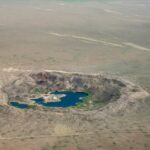
Russian nuclear weapons, 2024
By Hans M. Kristensen , Matt Korda , Eliana Johns , Mackenzie Knight

Introduction: Nuclear testing in the 21st century—legacies, tensions, and risks
By François Diaz-Maurin

New confidence-building measures can reduce tensions around subcritical tests
By Julien de Troullioud de Lanversin , Christopher Fichtlscherer
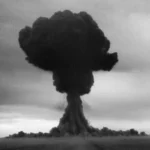
Preserving the nuclear test ban after Russia revoked its CTBT ratification
By Pavel Podvig
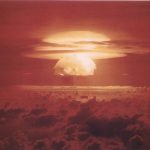
The horrors of nuclear weapons testing
By Walter Pincus

Environmental impacts of underground nuclear weapons testing
By Sulgiye Park , Rodney C. Ewing
Bulletin Daily

Missing the forest for the trees: The role of forests in Earth’s climate goes far beyond carbon storage
By Sara Blichner , James Weber

Surrounded by oil platforms, this coral reef in the Gulf of Mexico continues to thrive. For now.
By Jesse Nichols

A ‘plague’ comes before the fall: lessons from Roman history
By Colin Elliott

Formal risk assessments and nuclear arms control: exploring the value of modern methodologies
By Vicki Bier , Robert J. Budnitz , Olli Heinonen , Richard C. Lanza , Ronald F. Lehman , Sally Leivesley , Charles F. McMillan , George H. Miller , Anita Nilsson , John Organek , Robert N. Schock

How one Oregon county plans to make big oil pay for the 2021 heat dome
By Jeffrey B. Simon

France wants to extend its nuclear umbrella to Europe. But is Macron ready to trade Paris for Helsinki?
By Carine Guerout , Jason Moyer

May issue: The future of food in a time of climate change

Ukrainian journalist Illia Ponomarenko on the horror and absurdity of Russia’s senseless, existential war
By Susan D’Agostino
U.S. to scrap sea-launched nuclear missile despite military backing
- Medium Text

Sign up here.
Reporting by Phil Stewart and Idrees Ali; Editing by Chizu Nomiyama and Chris Reese
Our Standards: The Thomson Reuters Trust Principles. New Tab , opens new tab

Thomson Reuters
National security correspondent focusing on the Pentagon in Washington D.C. Reports on U.S. military activity and operations throughout the world and the impact that they have. Has reported from over two dozen countries to include Iraq, Afghanistan, and much of the Middle East, Asia and Europe. From Karachi, Pakistan.

Phil Stewart has reported from more than 60 countries, including Afghanistan, Ukraine, Syria, Iraq, Pakistan, Russia, Saudi Arabia, China and South Sudan. An award-winning Washington-based national security reporter, Phil has appeared on NPR, PBS NewsHour, Fox News and other programs and moderated national security events, including at the Reagan National Defense Forum and the German Marshall Fund. He is a recipient of the Edwin M. Hood Award for Diplomatic Correspondence and the Joe Galloway Award.

World Chevron
Senegal's prime minister Ousmane Sonko raised the possibility of closing French military bases in the West African country on Thursday in a wide-ranging speech that also touched on the euro-backed CFA franc currency, oil and gas deals and LGBTQ rights.

Official websites use .gov
Secure .gov websites use HTTPS
Nuke Sea-Launched Cruise Missile Would Bolster Deterrence, Officials Say
You have accessed part of a historical collection on defense.gov. Some of the information contained within may be outdated and links may not function. Please contact the DOD Webmaster with any questions.
Developing and deploying a sea-launched nuclear cruise missile is essential to deter Russia, U.S. officials have said.
A recent State Department paper says the new weapon would help fill a gap identified in the 2018 Nuclear Posture Review .
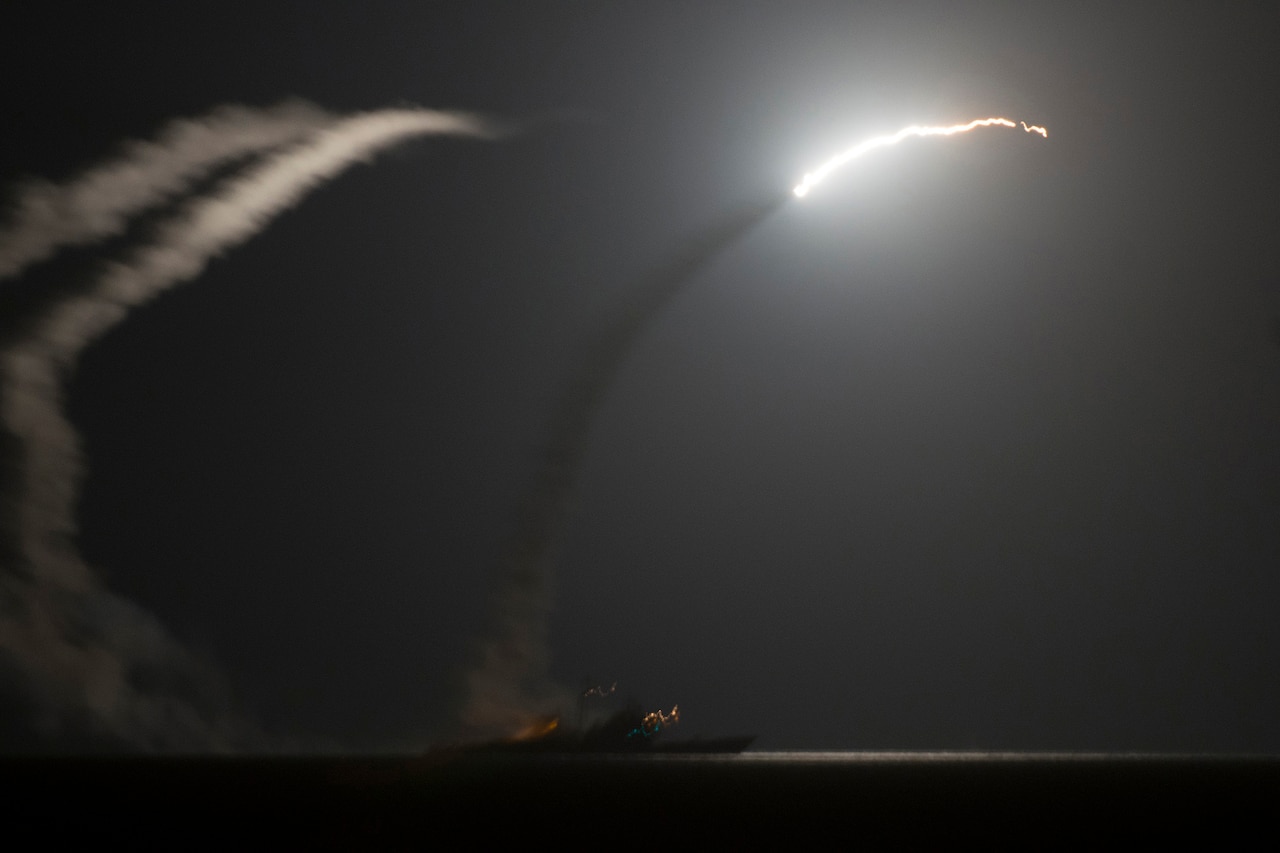
The United States retired its last nuclear sea-launched cruise missile in 2010 — one of only two remaining U.S. theater or tactical ("non-strategic") nuclear weapons. In contrast, Russia continued a comprehensive program to modernize and expand its low-yield theater and tactical nuclear weapons. What is more disturbing, officials said, is that Russian strategy actually contemplates the use of these nuclear capabilities in conflict.
Russian strategic thought mistakenly believes that limited nuclear first use with low-yield weapons could provide Russia with a "coercive advantage" in a conflict, the State Department paper says.
Russia may have pursued this strategy because the United States, unlike Russia, retired most of its non-strategic nuclear systems. Russia may believe it can use theater or tactical weapons, the paper says, because the United States could not effectively respond and might be reluctant to escalate further by responding with strategic nuclear weapons..
The 2018 Nuclear Posture Review calls for adjustments to U.S. nuclear forces to close this perceived gap on the escalation ladder and reinforce deterrence against low-yield nuclear use, DOD officials said.
A nuclear-armed sea-launched cruise missile would address alarming developments in the forces and doctrine of nuclear competitors, the posture review says, adding that Russia and China both are investing significant sums to improve and expand their nuclear forces with no clear indication as to where that expansion will stop.
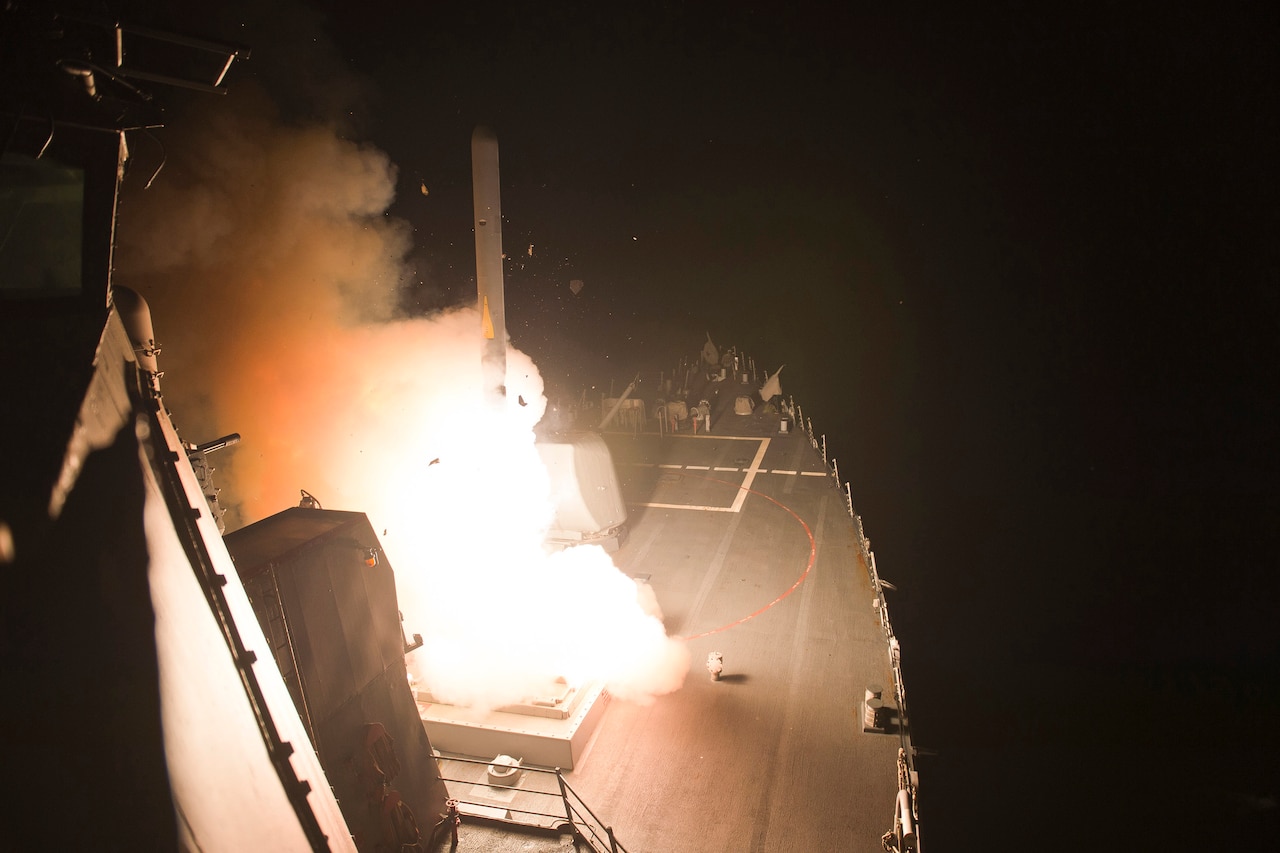
Russia's "adventurism" is the most immediate concern, officials said. The nation invaded Georgia in 2008 and still occupies two provinces. Russia illegally occupied Crimea in 2014 and sponsors a shooting war in the eastern part of Ukraine today. Russia has propped up the Assad regime in Syria and has prolonged the civil war in that nation. Russia has also sent forces to Libya, and Kremlin-associated contractors have seized two of its largest oil facilities. Finally, Russia has done its best to divide the North Atlantic Treaty Organization , seeking more leeway to intimidate the frontline states of Latvia, Estonia, Lithuania, Poland, Bulgaria and Romania.
There are credible concerns that theater and tactical nuclear capabilities are central to a Russian approach to regional conflict that envisions the early, limited use of non-strategic nuclear weapons to end a war on terms favorable to Russia.
"This approach may be premised on Russia's belief that its expanding anti-access/area denial networks will be able to neutralize the airborne nuclear deterrent forces of the United States and NATO ," the 2018 U.S. Nuclear Posture Review concluded. "In the future, it is possible that China could adopt a similar doctrine. Developing and fielding (sea-launched cruise missile-nuclear) signal the leaders of nuclear competitors in a concrete way that the United States has the capability and will to maintain operationally effective nuclear options to deter regional aggression."
The SLCM capability could also help allay the concerns of regional allies shielded by the U.S. nuclear umbrella, officials said.
The United States having such a capability would make any adversary think twice about using nuclear weapons. Without requiring nuclear testing or violating any treaty, the SLCM "will lower the risks of nuclear conflict, bolster the confidence of allies and restore a degree of balance in non-strategic nuclear weapons that could create conditions more conducive to addressing this category of forces through arms control," the posture review says.
Subscribe to Defense.gov Products
Choose which Defense.gov products you want delivered to your inbox.
Related Stories
Defense.gov, helpful links.
- Live Events
- Today in DOD
- For the Media
- DOD Resources
- DOD Careers
- Help Center
- DOD / Military Websites
- Agency Financial Report
- Value of Service
- Taking Care of Our People
- FY 2025 Defense Budget
- National Defense Strategy
The Department of Defense provides the military forces needed to deter war and ensure our nation's security.
- Air Warfare
- Cyber (Opens in new window)
- C4ISR (Opens in new window)
- Training & Sim
- Asia Pacific
- Mideast Africa
- The Americas
- Top 100 Companies
- Defense News Weekly
- Money Minute
- Whitepapers & eBooks (Opens in new window)
- DSDs & SMRs (Opens in new window)
- Webcasts (Opens in new window)
- Events (Opens in new window)
- Newsletters (Opens in new window)
- Events Calendar
- Early Bird Brief
- Digital Edition (Opens in new window)
Nuclear Arsenal
The us navy’s new nuclear cruise missile starts getting real next year.
MINOT AIR FORCE BASE, N.D. — The Pentagon intends to create a program of record for a new nuclear-armed, submarine-launched cruise missile in its next budget request, with the goal of deploying the weapon in 7-10 years, according to a senior defense official.
Speaking on condition of anonymity during a visit to Minot Air Force Base this week, the official noted that the department is going through an analysis of alternatives, or AOA, process for the weapon, which was first announced during the rollout of the Nuclear Posture Review .
“We requested $5 million in FY20, which Congress gave us. There’s nothing in the ‘21 budget because we’ll just continue to use the $5 million to do the AOA,” the official explained. “But in FY22, I hope that you’ll see a budget request that will begin the program of record for the sea-launched cruise missile.”
“You put these on submarines, the Russians won’t know where they are,” the official added. “They’ll hate it. They’ll absolutely hate it.”
As part of the Nuclear Posture Review, rolled out in early 2018, the Trump administration said it would seek two new nuclear capabilities: a low-yield warhead for the submarine-launched ballistic missile, and a sea-launched nuclear-capable cruise missile. The first goal is complete, with the warhead, known as the W76-2, deployed for the first time in late 2019.
The official said the department is still sorting how much money the program might cost, but pointed to the estimated price tag for the Long Range Standoff Weapon — or LRSO, a new air-launched cruise missile — as a rough estimate. That weapon is projected to cost the Defense Department about $8 billion to $9 billion and a similar amount for the National Nuclear Security Administration, which is charged with developing the warhead, the official said.
“Do you put it on a surface ship? Do you put it on a submarine? Do you use a new missile or an existing missile? How far does it have to travel? We’re looking at all of this. And then you also have to look at the concept of operations. How you want them to operate? Do you store the weapons on the sub all the time, or do you bring them into port and bring them in a crisis?” the official said.
Strategically, adding the cruise missile would allow the nuclear-armed Navy to go from 12 ships to 20 or 30, which would be “huge” in changing the strategic calculus for China and Russia, the official noted.
The official emphasized that the weapon doesn’t need to be a brand-new design, saying: “It doesn’t have [to] be a big deal” to design and procure.
“The SLCM [submarine-launched cruise missile] doesn’t have to be a big deal. Could be the same warhead. We’re going to look into that,” the official added.
A conventional Tomahawk weapon has a rough range of 1,250–2,500 kilometers, and the range on the new SLCM would likely be longer, as a nuclear warhead weighs less than a conventional payload. The Navy is already investing in its Next Generation Land Attack Weapon, which could provide a more updated system on which to base the SLCM. The warhead could be a modification of the W80-4, the warhead from NNSA that will be paired with the LRSO.
Critics of the idea argue that another nuclear weapon adds little to the arsenal, while eating into a naval budget that is already under strain.
“A new SLCM would be a costly hedge on a hedge,” said Kingston Reif of the Arms Control Association. “The United States is already planning to invest scores of billions of dollars in the B-21 [bomber], LRSO and F-35A [fighter jet] to address the [area-access/area denial] challenge. The Navy is unlikely to be pleased with the additional operational and financial burdens that would come with re-nuclearizing the surface or attack submarine fleet.”
Additionally, “arming attack submarines with nuclear SLCMs would also reduce the number of conventional Tomahawk SLCMs each submarine could carry,” Reif said.
Regardless of the details for the weapon, the official expects the Pentagon is 7-10 years away from deploying the new SLCM — and that’s if Congress backs the plan. Democrats have raised objections to the Trump administration’s plans for new nuclear weapons before, but ultimately did not block the W76-2 project from moving forward.
“I don’t know if Congress is going to make a big deal about it or not because there’s really no money involved” in fiscal 2021, the official said. “But it is a new weapon system, and unlike the W76-2, where you’re replacing a large warhead for a small warhead, here you’re actually introducing more deployed capabilities. But again, it’s 7-10 years.”
When the Nuclear Posture Review was rolled out, officials emphasized that the SLCM could be used as a bargaining chip in arms control negotiations with Russia. Despite a number of arms control agreements being on the ropes, the official this week again argued that the SLCM could “give us some leverage to bring [Russia] back to the arms control table.”
Aaron Mehta was deputy editor and senior Pentagon correspondent for Defense News, covering policy, strategy and acquisition at the highest levels of the Defense Department and its international partners.
More In Nuclear Arsenal
Navy, Marine Corps pitched three systems for first Replicator batch
An acquisition official said the navy and marine corps brought three systems to replicator, but declined to clarify whether all were selected..
Space Force should consider alternative launch sites, lawmakers say
The house armed services committee's fiscal 2025 defense policy bill highlights capacity concerns at dod's eastern and western launch ranges..
Lawmakers propose DIU-managed military testing and evaluation cell
The effort would begin as a three-year pilot program aimed at making it easier for high-need technologies to move through traditional testing processes..
Thales doubles down on radio production as US Army rethinks its network
The army tapped thales defense and security and l3harris technologies to furnish combat net radios. initial orders totaled tens of millions of dollars..
Former CYBERCOM boss Nakasone to lead Vanderbilt defense institute
The move follows a yearslong stint overseeing elite military hackers and global intelligence collection., featured video, sof week highlights and ai-driven fighter jets | defense news weekly full episode 5.11.24.

Financial Tips for Transitioning from Military to Civilian Life — Money Minute
MH-6 Little Bird’s future and Special Operations Forces aviation updates
Are extreme-range sniper rifles coming to special operations?
Trending now, uk navy to buy six vessels, enter new ‘golden age’ of shipbuilding, uk navy to buy six vessels, enters new ‘golden age’ of shipbuilding, us and japan sign agreement to co-develop hypersonic interceptor, ukraine, russia race to shield battle tanks from exploding drones, us army experiments with long-endurance drones, balloons in philippines.
We've detected unusual activity from your computer network
To continue, please click the box below to let us know you're not a robot.
Why did this happen?
Please make sure your browser supports JavaScript and cookies and that you are not blocking them from loading. For more information you can review our Terms of Service and Cookie Policy .
For inquiries related to this message please contact our support team and provide the reference ID below.

W80-1 Warhead Selected For New Nuclear Cruise Missile
The U.S. Nuclear Weapons Council has selected the W80-1 thermonuclear warhead for the Air Force’s new nuclear cruise missile (Long-Range Standoff, LRSO) scheduled for deployment in 2027.
The W80-1 warhead is currently used on the Air Launched Cruise Missile (ALCM), but will be modified during a life-extension program and de-deployed with a new name: W80-4.
Under current plans, the ALCM will be retired in the mid-2020s and replaced with the more advanced LRSO, possibly starting in 2027.
The enormous cost of the program – $10-20 billion by some estimates – is robbing defense planners of resources needed for more important non-nuclear capabilities.
Even though the United States has thousands of nuclear warheads on ballistic missiles and is building a new penetrating bomber to deliver nuclear bombs, STRATCOM and Air Force leaders are arguing that a new nuclear cruise missile is needed as well.
But their description of the LRSO mission sounds a lot like old-fashioned nuclear warfighting that will add new military capabilities to the arsenal in conflict with the administration’s promise not to do so and reduce the role of nuclear weapons.
What Kind of Warhead?
The selection of the W80-1 warhead for the LRSO completes a multi-year process that also considered using the B61 and W84 warheads.
The W80-4 selected for the LRSO will be the fifth modification name for the W80 warhead (see table below): The first was the W80-0 for the Navy’s Tomahawk Land-Attack Cruise Missile (TLAM/N), which was retired in 2011; the second is the W80-1, which is still used the ALCM; the third was the W80-2, which was a planned LEP of the W80-0 but canceled in 2006; the fourth was the W80-3, a planned LEP of the W80-1 but canceled in 2006.

The W80-4 will be the fifth modification name for the W80 warhead.
The B61 warhead has been used as the basis for a wide variety of warhead designs . It currently exists in five gravity bomb versions (B61-4, B61-4, B61-7, B61-10, B61-11) and was also used as the basis for the W85 warhead on the Pershing II ground-launched ballistic missile. After the Pershing II was eliminated by the INF Treaty, the W85 was converted into the B61-10. But the B61 was not selected for the LRSO partly because of concern about the risk of common-component failure from basing too many warheads on the same basic design.
The W84 was developed for the ground-launched cruise missile (BGM-109G), another weapon eliminated by the INF Treaty. As a more modern warhead, it includes a Fire Resistant Pit (which the W80-1 does not have) and a more advanced Permissive Action Link (PAL) use-control system. The W84 was retired from the stockpile in 2008 but was brought back as a LRSO candidate but was not selected, partly because not enough W84s were built to meet the requirement for the planned LRSO inventory.
Cost Estimates
In the past two year, NNSA has provided two very different cost estimates for the W80-4. The FY2014 Stockpile Stewardship and Management Plan (SSMP) published in June 2013 projected a total cost of approximately $11.6 billion through 2030. The FY2015 SSMP, in contrast, contained a significantly lower estimate: approximately $6.8 billion through 2033 (see graph below).

Official cost estimates for the W80-4 vary significantly.
The huge difference in the cost estimates (nearly 50%) is not explained in detail in the FY2015 SSMP, which only states that the FY2014 numbers were updated with a smaller “escalation factor” and “improvements in the cost models.” Curiously, the update only reduces the cost for the years that were particularly high (2019-2027), the years with warhead development and production engineering. The two-third reduction in the cost estimate may make it easier for NNSA to secure Congressional funding, but it also raises significant uncertainty about what the cost will actually be.
Assuming a planned production of approximately 500 LRSOs (there are currently 528 ALCMs in the stockpile and the New START Treaty does not count or limit cruise missiles), the cost estimates indicate a complex W80-4 LEP on par with the B61-12 LEP. NNSA told me the plan is to use many of the non-nuclear components and technologies on the W80-4 that were developed for the B61-12.
In addition to the cost of the W80-4 warhead itself, the cost estimate for completing the LRSO has not been announced but $227 million are programmed through 2019. Unofficial estimates put the total cost for the LRSO and W80-4 at $10-20 billion. In addition to these weapons costs, integration on the B-2A and next-generation long-range bomber (LRS-B) will add hundreds of millions more.

The W80-1 is not big, seen here with the author at the nuclear museum in Albuquerque, but it packs explosive yields of 5-150 kilotons.
What’s The Mission?
Why does the Air Force need a new nuclear cruise missile?
During a recent meeting with Pentagon officials, I asked why the LRSO was needed, given that the military also has gravity bombs on its bombers. “Because of what you see on that map,” a senior defense official said pointing to a large world map on the wall. The implication was that many targets would be risky to get to with a bomber. When reminded that the military also has land- and sea-based ballistic missiles that can reach all of those targets, another official explained: “Yes but they’re all brute weapons with high-yield warheads. We need the targeting flexibility and lower-yield options that the LRSO provides.”
The assumption for the argument is that if the Air Force didn’t have a nuclear cruise missile, an adversary could gamble that the United States would not risk an expensive stealth bomber to deliver a nuclear bomb and would not want to use ballistic missiles because that would be escalating too much. That’s quite an assumption but for the nuclear warfighter the cruise missile is seen as this great in-between weapon that increases targeting flexibility in a variety of regional strike scenarios.
That conversation could have taken place back in the 1980s because the answers sounded more like warfighting talk than deterrence. The two roles can be hard to differentiate and the Air Force’s budget request seems to include a bit of both: the LRSO “will be capable of penetrating and surviving advanced Integrated Air Defense Systems (IADS) from significant stand off range to prosecute strategic targets in support of the Air Force’s global attack capability and strategic deterrence core function.”
The deterrence function is provided by the existence of the weapon, but the global attack capability is what’s needed when deterrence fails. At that point, the mission is about target destruction: holding at risk what the adversary values most. Getting to the target is harder with a cruise missile than a ballistic missile, but it is easier with a cruise missile than a gravity bomb because the latter requires the bomber to fly very close to the target. That exposes the platform to all sorts of air defense capabilities. That’s why the Pentagon plans to spend a lot of money on equipping its next-generation long-range bomber (LRS-B) with low-observable technology.
The LRSO is therefore needed, STRATCOM commander Admiral Cecil Haney explained in June, to “effectively conduct global strike operations in the anti-access, access-denial environments.” When asked why they needed a standoff missile when they were building a stealth bomber, Haney acknowledge that “if you had all the stealth you could possibly have in a platform, then gravity bombs would solve it all.” But the stealth of the bomber will diminish over time because of countermeasures invented by adversaries, he warned. So “having standoff and stealth is very important” given how long the long-range bomber will operate into the future.

Lt. Gen. Stephen Wilson, the head of Air Force Global Strike Command, says the LRSO is needed to shoot holes in air defense systems.
Still, one could say that for any weapon and it doesn’t really explain what the nuclear mission is. But around the same time Admiral Haney made his statement, Air Force Global Strike Command commander General Wilson added a bit more texture: “There may be air defenses that are just too hard, it’s so redundant, that penetrating bombers become a challenge. But with standoff, I can make holes and gaps to allow a penetrating bomber to get in, and then it becomes a matter of balance.”
In this mission, the LRSO would not be used to keep the stealth bomber out of harms way per ce but as a nuclear sledgehammer to “kick down the door” so the bomber – potentially with B61-12 nuclear bombs in its bomb bay – could slip through the air defenses and get to its targets inside the country. Rather than deterrence, this is a real warfighting scenario that is a central element of STRATCOM’s Global Strike mission for the first few days of a conflict and includes a mix of weapons such as the B-2, F-22, and standoff weapons.
But why the sledgehammer mission would require a nuclear cruise missile is still not clear, as conventional cruise missiles have become significantly more capable against air defense and hard targets. In fact, most of the Global Strike scenarios would involve conventional weapons, not nuclear LRSOs. The Air Force has a $4 billion program underway to develop the Joint Air-to-Surface Standoff Missile (JASSM) and an extended-range version (JASSM-ER) for deliver by B-1B, B-2A, B-52H bombers and F-15E, F-16, and F-35 fighters. A total of 4,900 missiles are planned, including 2,846 JASSM-ERs.

The next-generation bomber will be equipped with non-nuclear weapons such as the Joint Air-to-Surface Standoff Missile (JASSM) that will provide it with a standoff capability similar to the LRSO, although with shorter range.
Since the next-generation long-range bomber would also be the launch platform for those conventional weapons, it will be exposed to the same risks with or without a nuclear LRSO.
Most recently, according to the Nuclear Security & Deterrence Monitor , Gen. Wilson added another twist to the justification:
“If I take a bomber, and I put standoff cruise missiles on it, in essence, it becomes very much like a sub. It’s got close to the same magazine capacity of a sub. So once I generate a bomber with standoff cruise missiles, it becomes a significant deterrent for any adversary. We often forget that. It possesses the same firepower, in essence, as a sub that we can position whenever and wherever we want, and it becomes a very strong deterrent. So I’m a strong proponent of being able to modernize our standoff missile capability.”
Although the claim that a bomber has “close to the same capacity of a sub” is vastly exaggerated (it is up to 20 warheads on 20 cruise missiles on a B-52H bomber versus 192 warheads on 24 sea-launched ballistic missiles on an Ohio-class submarine), the example helps illustrates the enormous overcapacity and redundancy in the current arsenal.
What Kind of Missile?
Although we have yet to see what kind of capabilities the LRSO will have, the Air Force description is that LRSO “will be capable of penetrating and surviving advanced Integrated Air Defense Systems (IADS) from significant stand off range to prosecute strategic targets in support of the Air Force’s global attack capability and strategic deterrence core function.”
There is every reason to expect that STRATCOM and the Air Force will want the weapon to have better military capabilities than the current Air Launched Cruise Missile (ALCM), perhaps with features similar to the Advanced Cruise Missile (ACM). After all, so the thinking goes, air defenses have improved significantly since the ALCM was deployed in 1982 and the LRSO will have to operate well into the middle of the century when air defense systems can be expected to be even better than today.
With a 3,000-km range similar to the ACM, the LRSO would theoretically be able to reach targets in much of Russia and most of China from launch-positions 1,000 kilometers from their coasts. Most of Russia and China’s nuclear forces are located in these areas.
In thinking about which capabilities would be needed for the LRSO, it is useful to recall the last time the warfighters argued that an improved cruise missile was needed. The ALCM was also “designed to evade air and ground-based defenses in order to strike targets at any location within any enemy’s territory,” but that was not good enough. So the Advanced Cruise Missile (ACM) was developed and deployed in 1992 to provide “significant improvements” over the ALCM in “range, accuracy, and survivability.” The rest of the mission was similar – “evade air and ground-based defenses in order to strike heavily defended, hardened targets at any location within any enemy’s territory” – but the requirement to hold at risk “heavily defended, hardened targets” was unique.
Yet when comparing the ALCM and ACM mission requirements and capabilities with the operational experience, GAO in 1993 found that “air defense threats had been overestimated” and that “tests did not demonstrate low ALCM survivability.” The ACM’s range was found to be “only slightly better than the older ALCM’s demonstrated capability,” and GAO concluded that “the improvement in accuracy offered by the ACM appears to have little real operational significance.”

The ACM was produced at great cost to provide improved targeting capabilities over the ALCM but apparently had little operational significance and was retired early in 2007. Will LRSO repeat the mistake?
Nonetheless, the ACM was produced in 1992-1993 at a cost of more than $10 billion. Strategic Air Command initially wanted 1461 missiles, but the high cost and the end of the Cold War caused Pentagon to cut the program to only 430 missiles. A sub-sonic cruise missile with a range of 3,000 kilometers (1,865 miles) and hard-target kill capability with the W80-1 warhead, the ACM was designed for external carriage on the B-52H bomber, with up to 12 missiles under the wings. The B-2 was also capable of carrying the ACM but as a penetrating stealth bomber there was never a need to assign it the stealthy standoff missile as well.
The ACM was supposed to undergo a life extension program to extend it to 2030, but after only 15 years of service the missile was retired early in 2007. An Enhanced Cruise Missile (ECM) was planned by the Bush administration, but it never materialized. It is likely, but still not clear, that LRSO will make use of some of the technologies from the ACM and ECM programs.
Conclusions and Recommendations
The W80-1 warhead has been selected to arm the new Long-Range Standoff (LRSO) missile, a $10-20 billion weapon system the Air Force plans to deploy in the late-2020s but can poorly afford.
Even though the United States has thousands of nuclear warheads on land- and sea-based ballistic missiles that can reach the same targets intended for the LRSO, the military argues that a new nuclear standoff weapon is needed to spare a new penetrating bomber from enemy air-defense threats.
Yet the same bomber will be also equipped with conventional weapons – some standoff, some not – that will expose it to the same kinds of threats anyway. So the claim that the LRSO is needed to spare the next-generation bomber from air-defense threats sounds a bit like a straw man argument.
The mission for the LRSO is vague at best and to the extent the Air Force has described one it sounds like a warfighting mission from the Cold War with nuclear cruise missiles shooting holes in enemy air defense systems. Given the conventional weapon systems that have been developed over the past two decades, it is highly questionable whether such a mission requires a nuclear cruise missile.

The Air Force has a large inventory of W80-1 warheads. Nearly 2,000 were built, 528 are currently used on the ALCM, and hundreds are in storage at the Kirtland Underground Maintenance and Munitions Storage Complex (KUMMSC) near Kirtland AFB in New Mexico.
The warfighters and the strategists might want a nuclear cruise missile as a flexible weapon for regional scenarios. But good to have is not the same as essential. And the regional scenarios they use to justify it are vague and largely unknown – certainly untested – in the public debate.
In the nuclear force structure planned for the future, the United States will have roughly 1,500 warheads deployed on land- and sea-based ballistic missiles. Nearly three-quarters of those warheads will be onboard submarines that can move to positions off adversaries anywhere in the world and launch missiles that can put warheads on target in as little as 15 minutes.
It really stretches the imagination why such a capability, backed up by nuclear bombs on bombers and the enormous conventional capability the U.S. military possesses, would be insufficient to deter or dissuade any potential adversary that can be deterred or dissuaded.
As the number of warheads deployed on land- and sea-based ballistic missiles continues to drop in the future, long-range, highly accurate, stealthy, standoff cruise missiles will increasingly complicate the situation. These weapons are not counted under the New START treaty and if a follow-on treaty does not succeed in limiting them, which seems unlikely in the current political climate, a new round of nuclear cruise missile deployments could become real spoilers. There are currently more ALCMs than ICBMs in the U.S. arsenal and with each bomber capable of loading up to 20 missiles the rapid upload capacity is considerable.
Under the 1,500 deployed strategic warhead posture of the New START treaty, the unaccounted cruise missiles could very quickly increase the force by one-third to 2,000 warheads. Under a posture of 1,000 deployed strategic warheads, which the Obama administration has proposed for the future, the effect would be even more dramatic: the air-launched cruise missiles could quickly increase the number of deployed warheads by 50 percent. Not good for crisis stability!
As things stand at the moment, the only real argument for the new cruise missile seems to be that the Air Force currently has one, but it’s getting old, so it needs a new one. Add to that the fact that Russia is also developing a new cruise missile, and all clear thinking about whether the LRSO is needed seems to fly out the window. Rather than automatically developing and deploying a new nuclear cruise missile, the administration and Congress need to ask tough questions about the need for the LRSO and whether the money could be better spent elsewhere on non-nuclear capabilities that – unlike a nuclear cruise missile – are actually useful in supporting U.S. national and international security commitments.
This publication was made possible by a grant from the New Land Foundation and Ploughshares Fund. The statements made and views expressed are solely the responsibility of the author.
The total number of U.S. nuclear warheads are now estimated to include 1,770 deployed warheads, 1,938 reserved for operational forces. An additional 1,336 retired warheads are awaiting dismantlement, for a total inventory of 5,044 warheads.
A military depot in central Belarus has recently been upgraded with additional security perimeters and an access point that indicate it could be intended for housing Russian nuclear warheads for Belarus’ Russia-supplied Iskander missile launchers.
The Indian government announced yesterday that it had conducted the first flight test of its Agni-5 ballistic missile “with Multiple Independently Targetable Re-Entry Vehicle (MIRV) technology.
While many are rightly concerned about Russia’s development of new nuclear-capable systems, fears of substantial nuclear increase may be overblown.
- Books & Press
- Proceedings
- Naval History

Suggestions
Trending topics, lawmakers question navy’s decision to abandon nuclear cruise missile.

Pentagon leaders faced tough questions from lawmakers on the Navy’s decision to shelve the development of a sea-launched nuclear cruise missile during a Thursday budget hearing before the Senate Armed Services Committee.
Several Republican lawmakers voiced concerns about acting Navy Secretary Thomas Harker’s plans to ax the missile’s funding as part of a Fiscal Year 2023 budget priorities memo reported by USNI News on Tuesday .
“I find it very concerning that an acting service secretary who hasn’t been confirmed by the Senate is making a decision like this, outside of any review process, without analysis, or input from [Office of the Secretary of Defense] policy, from Nuclear Matters, the Joint Chiefs or [U.S. Strategic Command], and without talking to other agencies or having, it seems, any discussions with our allies,” Sen. Deb Fischer (R-Neb.) said during the hearing. “I don’t think this is the right way to make decisions about nuclear policy,” she added.
Both Defense Secretary Lloyd Austin and Chairman of the Joint Chiefs Gen. Mark Milley confirmed to lawmakers that they had not seen the memo, which was a document for the Department of the Navy’s budget planning process.
“I have not seen the memo, but I would say that all of us, all the services, and the department, are again making tough choices in terms of what to prioritize and where to accept risk. That memo has to be pre-decisional because of where we are in the process,” Austin said. “And so I don’t feel comfortable in commenting on his memo. I would just say that, again, I am committed to a [Nuclear] Posture Review to make sure that we adequately analyze what our capabilities are, what’s needed in the future, and that we maintain the right balance in our nuclear forces going forward.”
Milley said he would look into the memo following the hearing.
“I’m not familiar with the memo and nor was I consulted. But as soon as we’re done here, I’ll go find that memo and get consulted,” he told lawmakers.
Sens. Joni Ernst (R-Iowa) and Marsha Blackburn (R-Tenn.) also expressed concerns over the memo’s directive about the Sea-Launched Cruise Missile. Blackburn asked why the Navy made the decision prior to the completion of a nuclear assessment.
“As I understand, the purpose of that memo was to issue some guidance for planning and evaluation to the Navy,” Austin responded. “But again, I am committed to conducting a Nuclear Posture Review that we talked about earlier.”
Austin emphasized to Ernst that the Nuclear Posture Review would inform a decision about the capability.
“We will be true to our posture review and make sure that that drives the process,” the defense secretary said.
Privately, Navy leaders have told lawmakers the introduction of nuclear cruise missiles to the fleet would present both budgetary and logistical headaches for the service, several defense and legislative sources told USNI News on Thursday.
For the Navy, a major barrier to developing a new sea-launched cruise missile is the operational limitations the service would face fielding a nuclear weapon on its fleet of surface ships or nuclear attack submarines. The ships are now armed with only conventional weapons since the nuclear-tipped Tomahawks (TLAM-N) left the Navy’s inventory in the early 1990s, according to the Center for Strategic and International Studies .
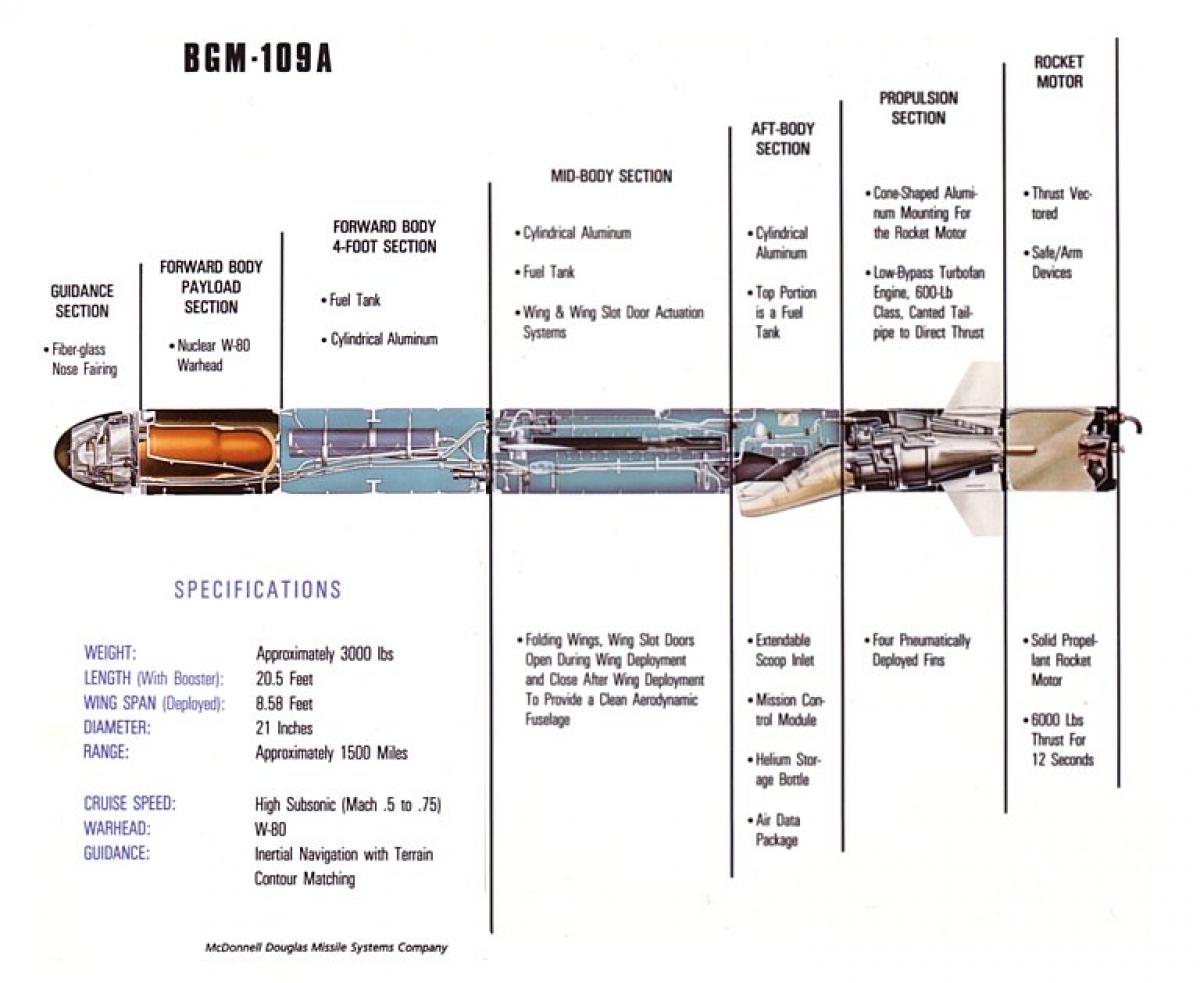
Putting nuclear weapons aboard ships would require strict onboard security protocol to protect the warheads. In the past, the Marines would provide a special security detachment to guard the warheads. Additionally, the U.S. could be limited on ports-of-call if its ships are armed with nuclear weapons. Several countries have bans on ships armed with nuclear weapons visiting their ports and the U.S. has a policy of neither confirming nor denying if nuclear weapons are aboard. In 1984, New Zealand strained relations with the U.S. after it turned away USS Buchanan (DDG-14) for not declaring if the ships possessed nuclear weapons. New Zealand only reversed the decision in 2016, USNI News reported at the time . Additionally, allies operating with U.S. Navy vessels may be reluctant to do so if there was potential that nuclear weapons were aboard, one legislative source told USNI News.
The service also has multiple large fiscal responsibilities in future budget years, including the Columbia-class submarine, the Constellation frigate program, and developing the Navy’s next-generation destroyer, submarine and fighter aircraft.
While it’s unclear where the Navy is headed in future budgets with the missile, the recent FY 2022 budget request is seeking $5.2 million in research and development money to develop the capability.
“This project will design, develop, produce and deploy a Nuclear-Armed Sea-Launched Cruise Missile (SLCM-N). SLCM-N is scoped to deliver an integrated flight system and to continue to advance SLCM-N capabilities to fully address requirements identified in the 2018 Nuclear Posture Review, SLCM-N Initial Capabilities Document, and examined in the Analysis of Alternatives to mitigate a lack of a sea-based tactical nuclear-based system,” the budget justification books read.
The 2018 Nuclear Posture Review led by the Trump administration called for the Pentagon to pursue low-yield nuclear weapons. While Republican lawmakers want to develop the capability, Democrats and President Biden have openly opposed developing the weapons.
“The United States does not need new nuclear weapons,” Biden told the Council for a Livable World in a 2019 questionnaire that was updated a month ahead of the 2020 election . “Our current arsenal of weapons, sustained by the Stockpile Stewardship program, is sufficient to meet our deterrence and alliance requirements.”

Mallory Shelbourne
Mallory Shelbourne is a reporter for USNI News. She previously covered the Navy for Inside Defense and reported on politics for The Hill . Follow @MalShelbourne
Get USNI News updates delivered to your inbox
Email address:
Frequency Daily Weekly All
Related Topics
- News & Analysis
- Submarine Forces
- Surface Forces
Related Posts

Navy’s Single Sub Buy Plan Raises Concerns with Congress

New Navy Long-Range Shipbuilding Plan Details 19 Ship Decommissionings in FY 2025

Aircraft Carrier Enterprise Delivery Delayed by 18 Months, Says Navy

Report from Pentagon Budget Reform Commission
- Skip to main content
- Skip to primary sidebar
- Skip to footer
Center for Arms Control and Non-Proliferation
June 24, 2021
Fact Sheet: Nuclear Sea-Launched Cruise Missiles
Updated May 2024

Despite the Biden administration’s previous decision not to pursue the development of a new nuclear-armed sea-launched cruise missile (SLCM-N) and its associated warhead, the W80-4 ALT, due to cost and strategic considerations, Congress provided funding for the continuation of the SLCM-N program in the FY24 National Defense Authorization Act.
In FY23 budget documents, the Navy stated that “the program was cost prohibitive and the acquisition schedule would have delivered capability late to need.” Despite the Navy’s opposition and concerns the SLCM-N would negatively affect readiness, $196 million has been authorized for FY24 for its development; $70 million for the warhead and $126 million for the missile.
In 1991, President George H.W. Bush ordered all nuclear-armed Tomahawk Land Attack Missiles removed from U.S. submarines and placed in storage. In 2010, the Obama administration declared the missiles a redundant capability and retired them. The Trump administration’s 2018 Nuclear Posture Review called for the development of a new SLCM-N to fill a theoretical gap in the U.S. arsenal for a low-yield nuclear response despite repeated DoD assurances that U.S. deterrence remained effective without SLCM. The Congressional Budget Office estimates a new SLCM-N will cost at least $10 billion through 2031. That total does not include production costs after 2031, retrofitting submarines and surface ships to carry the weapon, or other operational or security costs, which officials have hinted could lead to a total cost of up to $30 billion.
Senior Department of Defense officials shared varying opinions on the SLCM-N with Congress in the FY23 budget cycle. In April 2022, Chairman of the Joint Chiefs of Staff Gen. Mark Milley testified that he continues to support the program. Similarly, the former head of U.S. Strategic Command, Adm. Charles Richard, and the head of U.S. European Command, Gen. Tod Wolters, both supported the program in front of Congress as well. Secretary of Defense Lloyd Austin, on the other hand, opposed the system, arguing that the SLCM-N provides marginal capability compared to its cost.
A Deterrence Gap?
The argument for the SLCM-N has been raised in the context of the war in Ukraine as well. For example, Adm. Richard used the war in Ukraine as an example of a “deterrence and assurance gap” to justify the SLCM-N in an April 2022 letter to House lawmakers. Russia does, in fact, possess nuclear-capable missiles on its naval vessels; however, the SLCM-N would not be delivered before the 2030s and is therefore not relevant to the current war in Ukraine. There is also no indication that the addition of the SLCM-N would deter any future action by an adversary, such as Russia or China, and no SLCM-N type capability has been used in Ukraine or elsewhere.
Unwanted, Costly and Redundant
A new SLCM-N is a costly solution to a nonexistent problem. It is not necessary for deterrence, and pursuing such a program would be an expensive exercise that would do little to enhance U.S. security.
- SLCM-Ns weaken the U.S. Navy’s conventional warfighting duties . Arming U.S. surface or attack submarine fleets with SLCM-Ns means less space for conventional weaponry, weakening U.S. conventional capabilities and potentially leaving even fewer ships available for the Navy’s already overstretched mission set. It would also either bring nuclear weapons back to states that don’t currently house them, or force Navy ships to go out of their way to pick them up before deployment. Some U.S. allies like Japan and New Zealand also prohibit nuclear-armed vessels from docking at their ports or engaging in joint training exercises, presenting additional diplomatic challenges and resupply issues.
- The United States already has plenty of lower-yield nuclear options . The B61 gravity bomb, the W80-equipped air-launched cruise missile, and the W76-2 sea-launched ballistic missile are all low-yield capabilities already existing in the arsenal. The United States can meet adversaries at any escalation level with its current conventional and nuclear means. Adding a new SLCM-N would be a costly hedge built on an existing hedge.

820 1st Street NE, Suite LL-180 Washington, D.C. 20002 Phone: 202.546.0795

USS Long Beach: The U.S. Navy's Nuclear-Powered Crusier Was a Game Changer
Summary: The USS Long Beach (CGN-9) holds the distinction of being the first nuclear-powered surface vessel in the U.S. Navy, a milestone often overshadowed by the more renowned USS Nautilus and USS Enterprise.
-Originally intended as a smaller frigate, the Long Beach was redesigned to the size of a heavy cruiser to accommodate advanced missile systems and a helicopter pad used during Vietnam operations.
-Equipped with unique SCANFAR radar and powered by two C1W nuclear reactors, it reached speeds of 30 knots with virtually unlimited range. Commissioned in 1961, it made significant contributions, including forming part of the all-nuclear Task Force 1 and completing a historic unrefueled circumnavigation during Operation Sea Orbit.
-After service in Vietnam and participation in Operation Desert Storm, budget cutbacks led to its deactivation in 1995, culminating in its recycling in 2012.
Meet USS Long Beach
Most naval history buffs can tell you that the USS Nautilus (SSN-571) was the world's first operational nuclear-powered submarine , while USS Enterprise (CVN-65) was the first nuclear-powered aircraft carrier – yet many may wrongly assume that the carrier was also the first United State Navy surface warship to be powered by nuclear energy.
In fact, it was the USS Long Beach (CGN-9), a warship that was originally intended to be no larger than a frigate but during the design stage was rapidly increased to the dimensions of a heavy cruiser , which has the distinction of being the first nuclear-powered surface vessel.
USS Long Beach: A History
As an experimental platform, Long Beach was the only ship of her class. She was also the last cruiser built for the U.S. Navy as a cruiser design as all subsequent cruiser classes were essentially built on scaled-up destroyer hulls or converted from existing cruisers.
The increase in size was to accommodate various missile systems, while a helicopter pad was installed at the stern of the ship – however, she only carried helicopters during operations off Vietnam. During her service, Long Beach had the highest bridge structure of any warship smaller than an aircraft carrier.
The ship's high box-like superstructure housed the SCANFAR radar system, which comprised of AN/SPS-32 and AN/SPS-33 phased array radars.
Initially, a Talos missile launcher was mounted to the stern of the ship, but it was later replaced by two box launchers for BGM-109 Tomahawk cruise missiles, with each launching containing four missiles. There were also two forward launchers for the Terrier and Talos surface-to-air missiles (SAMs), and those were also later replaced by the longer-range Standard missile.
The Long Beach was powered by two C1W nuclear reactors , with two General Electric steam turbines, which provided 59.68 MW (80,000 shp). The powerplant enabled the warship to reach a speed of 30 knots, while her range was virtually unlimited.
The missile cruiser had a complement of 1,160 officers and sailors.
Service History
USS Long Beach, which was the third ship to be named after the California city, was laid down in December 1957 and launched in July 1959. She was commissioned on September 9, 1961 under the command of then-Captain Eugene Parks Wilkinson, who had previously served as the first commanding officer for the USS Nautilus. The cruiser served in the Atlantic Fleet from 1961 to 1966.
In May 1964, Long Beach joined the nuclear-powered aircraft carrier USS Enterprise and the guided-missile frigate USS Bainbridge (DLGN-25) to form the all-nuclear-powered Task Force 1, the first such battle force group of its kind in the history of naval operations.
At the end of July of that year, the three warships began Operation Sea Orbit, a two-month unrefueled cruise around the world. Task Force 1 left Gibraltar on July 31, sailed down the Atlantic Ocean and then around Africa, crossed the Indian Ocean, and then to the Pacific Ocean before rounding Cape Horn. The task force completed the 30,216 nautical mile voyage in 65 days.
In 1966, the nuclear-powered cruiser was deployed for her first tour of duty off Vietnam and was mainly stationed in the northern part of the Gulf of Tonkin, where the U.S. Navy had created its Positive Identification Radar Advisory Zone (PIRAZ).
From that position, Long Beach maintained constant radar surveillance to ensure that the North Vietnamese intruder aircraft couldn't evade identification and attempt to confront U.S. strike aircraft. The warship also provided facilities for an onboard search-and-rescue helicopter.
During her second deployment to the Gulf of Tonkin, Talos missiles fired from the cruiser destroyed two Vietnamese MiG-17s at a range of 70 miles. It was the first record use of naval SAMs in combat conditions.
The warship was updated in the late 1970s and later operated as part of the UN task force during Operation Desert Storm. Instead of receiving a third nuclear refueling and proposed upgrade,
USS Long Beach was deactivated on May 1, 1995, after more than 33 years of operational service. Nuclear power had been deemed too expensive to use on surface ships smaller than aircraft carriers in view of defense budget cutbacks after the end of the Cold War.
In July 2012, Long Beach was sold at auction for recycling. It marked the final end of the world's first nuclear-powered surface warship.
About the Author
Peter Suciu is a Michigan-based writer who has contributed to more than four dozen magazines, newspapers and websites. He regularly writes about military hardware, and is the author of several books on military headgear including A Gallery of Military Headdress , which is available on Amazon.com. Peter is also a Contributing Writer for Forbes.

The US Army's new plan to counter Russia and China has a glaring problem, experts say
- The US Army's new structure responds to drones and guided missiles and artillery.
- But the Army plans to stand up new units at a time its recruiting is struggling.
- The Army is also basing its plans on untried weapons, the Congressional Research Service warned.

The US Army is reorganizing to fight against major powers like Russia and China, but it lacks the troops and new recruits to carry it out, congressional analysts contend.
The 2024 Army Force Structure Transformation would be the Army's fifth major reorganization since 2003. Judging by details laid out in an Army white paper , the emphasis will be on responding to technological changes in warfare, such as the threat of drones and long-range guided munitions, while trying to economize on scarce manpower.
But that may be easier said than done. "It is one thing to establish the authorizations for new and existing units discussed in the Army's white paper, yet another to fill those authorizations with qualified soldiers," warns a new report by the Congressional Research Service, which analyzes issues for Congress.
The most striking aspect of the Army's plan is the large number of new units, for counter-drone protection as well as air and missile defense. These units, assigned to corps- and division-level formations, would include four more "indirect fire protection capability" battalions intended to shoot down cruise missiles, rockets, and artillery and mortar shells. In addition, there would be nine counter-small UAS batteries tasked with destroying small drones, and four more Maneuver Short Range Air Defense (M-SHORAD) battalions to stop manned aircraft, helicopters and drones.
These would help flesh out the Army's five Multi-Domain Task Forces, theater-level units with exotic capabilities such as hypersonic missiles, cyberwarfare, jamming, and integrating intelligence data. At the same time, the Army is trying to address a recruiting crisis that has left some units undermanned. The transformation plan would reduce authorized strength — the maximum number of soldiers allowed — from 494,000 to 470,000. The Army currently has about 450,000 active-duty troops. In contrast, the US Army had 770,000 soldiers in the latter stages of the Cold War, when it was structured to counter the Soviet Union.
"The Army will shrink excess, largely unmanned 'hollow' force structure and build new formations equipped with new capabilities needed for large scale combat operations," the Army white paper explained. This would include 3,000 fewer authorized special operations forces personnel. Some functions will also be consolidated, such as reassigning engineers from brigade combat teams to divisions, which would allow fewer engineer slots.
Related stories
But even with consolidation and a boost to recruitment — including new warrant officers who specialize in recruiting — the Army may not be able to find enough personnel to fill out its existing units and create new air defense formations. In 2023, the Army came up 10,000 short in its quest for 65,000 new recruits.
"Given past recruiting shortfalls and preliminary FY2024 recruiting data, it is difficult to predict if the Army will be able rectify its recruiting challenges in the near and long term," CRS said.
The Army may also be focusing too much on cutting-edge "soft" technologies rather than old-fashioned kinetic weapons that have proven quite relevant and lethal in the Ukraine war. "The Army white paper appears to address technology-based, non-kinetic space and cyber effects, long-range precision fires, and force protection more than it does conventional close-combat force capabilities, Army Special Operations Forces capabilities, and Security Force Assistance capabilities," said CRS.
The Army is also basing its plans on untried weapons, such as the Long-Range Hypersonic Missile and air defense lasers. "Some units, such as LRHW batteries and Directed Energy (DE) SHORAD units, do not have mature weapons and technologies," CRS warned. Nor does the Army — or Congress — have a good idea of how much the reorganization would cost.
Inevitably, there will also be disruptions caused by yet another Army metamorphosis. In 2003, the Army switched from a Cold War force structure of heavy mechanized divisions, to smaller, lighter brigades more suitable for counterinsurgency. Now, the Army has gone full circle as it reconfigures for Cold War-style mechanized conflict against big opponents like Russia and China. At the same time, it must also incorporate new technologies such as drones and long-range artillery, which have demonstrated their power in the Ukraine war.
The reorganization does address some of the Army's problems, Mark Cancian, a senior advisor at the Center for Strategic and International Studies, told Business Insider. "The new units are appropriate for a great power conflict. China and Russia have much stronger air and missile forces than the regional opponents the army has faced for the last generation."
Creating units armed with hypersonic missiles also makes sense, especially since Russia and the US withdrew in 2019 from the Intermediate-Range Nuclear Forces treaty, signed in 1987 to curb cruise missiles and other medium-range nuclear weapons.
"The long-range fires are an opportunity that has opened up with the end of the INF," Cancian said. Nonetheless, the reorganization doesn't address the real issue. "The Army's major problem is that it is too small overall to meet all of its likely peacetime and wartime commitments," said Cancian.
Michael Peck is a defense writer whose work has appeared in Forbes, Defense News, Foreign Policy magazine, and other publications. He holds an MA in political science from Rutgers Univ. Follow him on Twitter and LinkedIn .
Watch: Ukrainian army tests new Western weapons as NATO boosts supplies
- Main content
Advertisement
Supported by
As Russia Advances, NATO Considers Sending Trainers Into Ukraine
The move could draw the United States and Europe more directly into the war. The Biden administration continues to say there will be no American troops on the ground.
- Share full article

By Helene Cooper , Julian E. Barnes , Eric Schmitt and Lara Jakes
Helene Cooper reported from Brussels; Julian E. Barnes from Washington; Eric Schmitt from Tampa, Fla.; and Lara Jakes from Rome.
NATO allies are inching closer to sending troops into Ukraine to train Ukrainian forces, a move that would be another blurring of a previous red line and could draw the United States and Europe more directly into the war.
Ukraine’s manpower shortage has reached a critical point, and its position on the battlefield in recent weeks has seriously worsened as Russia has accelerated its advances to take advantage of delays in shipments of American weapons. As a result, Ukrainian officials have asked their American and NATO counterparts to help train 150,000 new recruits closer to the front line for faster deployment.
So far the United States has said no, but Gen. Charles Q. Brown Jr., the chairman of the Joint Chiefs of Staff, said on Thursday that a NATO deployment of trainers appeared inevitable. “We’ll get there eventually, over time,” he said.
For now, he said, an effort inside Ukraine would put “a bunch of NATO trainers at risk” and would most likely mean deciding whether to use precious air defenses to protect the trainers instead of critical Ukrainian infrastructure near the battlefield. General Brown briefed reporters on his plane en route to a NATO meeting in Brussels.
As a part of NATO, the United States would be obligated under the alliance’s treaty to aid in the defense of any attack on the trainers, potentially dragging America into the war.
The White House has been adamant that it will not put American troops, including trainers, on the ground in Ukraine, a position that an administration official reiterated on Thursday. The administration has also urged NATO allies not to send their troops.
But in February, President Emmanuel Macron of France said that “nothing should be ruled out” when it comes to sending Western troops to Ukraine. Mr. Macron has doubled down on his comment since, including after senior American diplomats asked him to stop.
The government of Estonia has not ruled out the possibility of sending troops to western Ukraine to take over rear roles that could free Ukrainian troops to go to the front, Estonia’s national security adviser said this week .
Lithuania’s foreign minister, Gabrielius Landsbergis, backed Mr. Macron’s stance in an interview with the The Guardian last week. “Our troops have been training Ukrainians in Ukraine before the war,” he said, adding, “So returning to this tradition might be quite doable.”
The American military has done training for Ukrainian troops in Poland, Germany and the United States, but pulling troops out of Ukraine is time consuming. American officials now acknowledge that the current training by Ukrainian forces is not sufficient, and that they need better and faster training to push back on an expected Russian drive this summer.
The United States used to help run a NATO training program at Yavoriv, in western Ukraine, but American troops were pulled out from there at the start of the war.
American and allied training has not always been successful. Before a Ukrainian counteroffensive last summer, U.S. soldiers provided training in Germany to Ukrainian units on maneuver warfare, mine clearing and other tasks. But learning how to use tanks, artillery and infantry troops in a coordinated way is difficult, particularly in a short 12-week period. Compounding the problem is that Ukrainians are facing a battlefield far different and more intense than what American forces have fought on in recent years.
Moving the training into Ukraine, military officials acknowledge, would allow American trainers to more quickly gather information about the innovations occurring on the Ukrainian front lines, potentially allowing them to adopt their training.
NATO last month asked Gen. Christopher G. Cavoli, the supreme allied commander for Europe, to come up with a way for the alliance to do more to help Ukraine that would mitigate risks. A U.S. official said on Wednesday that one possibility could be training Ukrainian troops in Lviv, near the country’s western border with Poland.
But Russia has already bombed Lviv, including a few weeks ago when Russian cruise missiles struck critical infrastructure there.
Some officials say that large numbers of new Ukrainian recruits might still be sent to sprawling training ranges in Germany and Poland.
But logistically that requires transporting the troops to the U.S. Army’s training grounds in Grafenwoehr, Germany, putting them through complex maneuvers meant to teach them combined arms warfare and then sending the troops nearly 1,000 miles through Lviv and then Kviv for deployment to the front lines.
“Remember, when Russia first invaded Crimea in 2014, we sent increased troop numbers into Ukraine to train Ukrainian forces in western Ukraine, and we kept rotating them in all the way to 2022, when we got spooked and withdrew them,” said Evelyn Farkas, the former top Pentagon official for Ukraine during the Obama administration. “It shouldn’t surprise anyone now, when manpower is in short supply at the Ukrainian front, that NATO members and the alliance leadership consider how to help again from the rear.”
Other NATO allies, including Britain, Germany and France, are working to base defense contractors in Ukraine to help build and repair weapons systems closer to the combat zone — what military officials have described as a “fix it forward” approach. Current and former U.S. defense officials said the White House is now reviewing its ban on allowing American defense contractors in Ukraine, although a small number have already been allowed in, under State Department authorities, to work on specific weapons systems like Patriot air defenses.
“There is an element of ally malpractice in the fact that we’re providing masses of Western equipment to Ukraine, but not giving them the resources to sustain it,” said Alexander S. Vindman, a retired Army lieutenant colonel and a Ukrainian-born American combat veteran.
Helene Cooper is a Pentagon correspondent. She was previously an editor, diplomatic correspondent and White House correspondent. More about Helene Cooper
Julian E. Barnes covers the U.S. intelligence agencies and international security matters for The Times. He has written about security issues for more than two decades. More about Julian E. Barnes
Eric Schmitt is a national security correspondent for The Times, focusing on U.S. military affairs and counterterrorism issues overseas, topics he has reported on for more than three decades. More about Eric Schmitt
Lara Jakes , based in Rome, reports on diplomatic and military efforts by the West to support Ukraine in its war with Russia. She has been a journalist for nearly 30 years. More about Lara Jakes
Our Coverage of the War in Ukraine
News and Analysis
With his army making advances in Ukraine and his political grip tightened at home, President Vladimir Putin of Russia arrived in Beijing in search of another win: more support from his “dear friend,” Xi Jinping .
The Biden administration is increasingly concerned that Putin is gathering enough momentum to change the trajectory of the war.
Secretary of State Antony Blinken sought to reassure Ukrainians that they could weather an ominous new Russian offensive and count on long-term support from the United States and its European allies.
World’s Nuclear Inspector: Rafael Grossi took over the International Atomic Energy Agency five years ago at what now seems like a far less fraught moment. With atomic fears everywhere, the inspector is edging toward mediator .
Frozen Russian Assets: As much as $300 billion in frozen Russian assets is piling up profits and interest income by the day. Now, Ukraine’s allies are considering how to use those gains to aid Kyiv .
Rebuilding Ukrainian Villages: The people of the Kherson region have slowly rebuilt their livelihoods since Ukraine’s military forced out Russian troops. Now they are bracing for another Russian attack .
How We Verify Our Reporting
Our team of visual journalists analyzes satellite images, photographs , videos and radio transmissions to independently confirm troop movements and other details.
We monitor and authenticate reports on social media, corroborating these with eyewitness accounts and interviews. Read more about our reporting efforts .
- Election 2024
- Entertainment
- Newsletters
- Photography
- Personal Finance
- AP Investigations
- AP Buyline Personal Finance
- AP Buyline Shopping
- Press Releases
- Israel-Hamas War
- Russia-Ukraine War
- Global elections
- Asia Pacific
- Latin America
- Middle East
- Election Results
- Delegate Tracker
- AP & Elections
- Auto Racing
- 2024 Paris Olympic Games
- Movie reviews
- Book reviews
- Personal finance
- Financial Markets
- Business Highlights
- Financial wellness
- Artificial Intelligence
- Social Media
What are tactical nuclear weapons and why did Russia order drills?
FILE - In this photo taken from a video distributed by Russian Defense Ministry Press Service, on Dec. 9, 2020, a Russian Tu-160 strategic bomber fires a cruise missile at test targets, during a military drills, Russia. The Russian Defense Ministry said that the military will hold drills involving tactical nuclear weapons – the first time such exercise was publicly announced by Moscow. (Russian Defense Ministry Press Service via AP, File)
FILE Russian President Vladimir Putin, center, walks to attend a welcome ceremony with Kyrgyzstan’s President Sadyr Japarov prior to their talks in Bishkek, Kyrgyzstan, Thursday, Oct. 12, 2023. Putin has repeatedly reminded the West about Moscow’s nuclear might in a bid to discourage it from increasing military support to Kyiv. (Pavel Bednyakov, Sputnik, Kremlin Pool Photo via AP, File)
FILE - In this photo taken from video released by the Russian Defense Ministry Press Service on Monday, Jan. 22, 2024, a Su-25 warplane is seen from the cockpit of another such aircraft as they fire rockets on a mission over Ukraine. The Russian Defense Ministry said that the military will hold drills involving tactical nuclear weapons – the first time such exercise was publicly announced by Moscow. (Russian Defense Ministry Press Service via AP, File)
FILE - This photo taken from video provided by the Russian Defense Ministry Press Service on Feb. 19, 2022, shows a Yars intercontinental ballistic missile being launched from an air field during military drills in Russia. The Russian Defense Ministry said that the military will hold drills involving tactical nuclear weapons – the first time such exercise was publicly announced by Moscow. (Russian Defense Ministry Press Service via AP, File)
FILE - In this photo taken from video provided by the Russian Defense Ministry Press Service on Tuesday, Jan. 25, 2022, The Russian army’s Iskander missile launchers take positions during drills in Russia. The Russian Defense Ministry said that the military will hold drills involving tactical nuclear weapons – the first time such exercise was publicly announced by Moscow. (Russian Defense Ministry Press Service via AP, File)
FILE In this photo released by Russian Defense Ministry Press Service on Friday, Feb. 2, 2024, Russian troops load an Iskander missile onto a mobile launcher during drills at an undisclosed location in Russia. The Russian Defense Ministry said that the military will hold drills involving tactical nuclear weapons – the first time such exercise was publicly announced by Moscow. (Russian Defense Ministry Press Service via AP, File)
FILE Russian President Vladimir Putin, right, and Belarusian President Alexander Lukashenko watch military drills via videoconference in Moscow, Russia, Saturday, Feb. 19, 2022. The Russian military on Friday announced massive drills of its strategic nuclear forces. Last year, Russia moved some of its tactical nuclear weapons into the territory of its ally Belarus that neighbors Ukraine and NATO members Poland, Latvia and Lithuania. (Alexei Nikolsky, Sputnik, Kremlin Pool Photo via AP, File)
FILE Russian President Vladimir Putin, left, and Belarus President Alexander Lukashenko shake hands during a meeting of the Union State Supreme Council in St. Petersburg, Russia, Monday, Jan. 29, 2024. Last year, Russia moved some of its tactical nuclear weapons into the territory of its ally Belarus that neighbors Ukraine and NATO members Poland, Latvia and Lithuania. (Dmitry Astakhov, Sputnik, Government Pool Photo via AP, File)
FILE - This photo taken from video provided by the Russian Defense Ministry Press Service on Saturday, Feb. 19, 2022, shows a Russian Iskander-K missile launched during a military exercise at a training ground in Russia. The Russian Defense Ministry said that the military will hold drills involving tactical nuclear weapons – the first time such exercise was publicly announced by Moscow. (Russian Defense Ministry Press Service via AP, File)
FILE - In this photo taken from video provided by the Russian Defense Ministry Press Service on Thursday, Feb. 17, 2022, Su-30 fighters of the Russian and Belarusian air forces fly in a joint mission during the Union Courage-2022 Russia-Belarus military drills in Belarus. The Russian Defense Ministry said that the military will hold drills involving tactical nuclear weapons – the first time such exercise was publicly announced by Moscow. (Russian Defense Ministry Press Service via AP, File)
FILE - In this photo released by Russian Defense Ministry Press Service on April 20, 2022, a Sarmat intercontinental ballistic missile is launched from Plesetsk in northwestern Russia. The Russian Defense Ministry said that the military will hold drills involving tactical nuclear weapons – the first time such exercise was publicly announced by Moscow. (Russian Defense Ministry Press Service via AP, File)
FILE - In this photo taken from video released by Russian Defense Ministry Press Service on April 14, 2023, a Belarusian air force pilot speaks at an unidentified location. The video said that Belarusian air crews have completed a training course in Russia on using nuclear weapons. The Russian Defense Ministry said that the military will hold drills involving tactical nuclear weapons – the first time such exercise was publicly announced by Moscow. (Russian Defense Ministry Press Service via AP, File)
FILE - In this photo taken from video released by the Russian Defense Ministry Press Service, a long-range Tu-160 bomber takes off from a base in Russia to patrol Belarus’ airspace on Nov. 11, 2021. The Russian Defense Ministry said that the military will hold drills involving tactical nuclear weapons – the first time such exercise was publicly announced by Moscow. (Russian Defense Ministry Press Service via AP, File)
- Copy Link copied
Russia’s Defense Ministry said Monday that the military would hold drills involving tactical nuclear weapons — the first time such an exercise has been publicly announced by Moscow .
A look at tactical nuclear weapons and the part they play in the Kremlin’s political messaging.
WHAT ARE TACTICAL NUCLEAR WEAPONS?
Unlike nuclear-tipped intercontinental ballistic missiles that can destroy entire cities, tactical nuclear weapons for use against troops on the battlefield are less powerful and can have a yield as small as about 1 kiloton. The U.S. bomb dropped on Hiroshima during World War II was 15 kilotons.
Such battlefield nuclear weapons — aerial bombs, warheads for short-range missiles or artillery munitions — can be very compact. Their small size allows them to be discreetly carried on a truck or plane.
Unlike strategic weapons, which have been subject to arms control agreements between Moscow and Washington, tactical weapons never have been limited by any such pacts, and Russia hasn’t released their numbers or any other specifics related to them.
WHAT HAS PUTIN SAID ABOUT NUCLEAR WEAPONS?
Since launching the full-scale invasion of Ukraine on Feb. 24, 2022, Russian President Vladimir Putin has repeatedly reminded Western nations about Moscow’s nuclear might in a bid to discourage them from increasing military support to Kyiv.
Early on in the war, Putin frequently referenced Moscow’s nuclear arsenal by vowing repeatedly to use “all means” necessary to protect Russia. But he later toned down his statements as Ukraine’s offensive last summer failed to reach its goals and Russia scored more gains on the battlefield.
Moscow’s defense doctrine envisages a nuclear response to an atomic strike or even an attack with conventional weapons that “threaten the very existence of the Russian state.” That vague wording has led some pro-Kremlin Russian experts to urge Putin to sharpen it to force the West to take the warnings more seriously.
Putin said last fall that he sees no reason for such a change.
“There is no situation in which anything would threaten Russian statehood and the existence of the Russian state,” he said. “I think that no person of sober mind and clear memory could have an idea to use nuclear weapons against Russia.”
WHY DID RUSSIA SEND NUCLEAR WEAPONS TO BELARUS?
Last year, Russia moved some of its tactical nuclear weapons into the territory of Belarus , an ally that neighbors Ukraine and NATO members Poland, Latvia and Lithuania.
Belarus’ authoritarian president, Alexander Lukashenko , had long urged Moscow to station nuclear weapons in his country, which has close military ties with Russia and served as a staging ground for the war in Ukraine.
Both Putin and Lukashenko said that nuclear weapons deployment to Belarus was intended to counter perceived Western threats. Last year, Putin specifically linked the move to the U.K. government’s decision to provide Ukraine with armor-piercing shells containing depleted uranium.
Neither leader said how many were moved — only that Soviet-era facilities in the country were readied to accommodate them, and that Belarusian pilots and missile crews were trained to use them. The weapons have remained under Russian military control.
The deployment of tactical nuclear weapons to Belarus, which has a 1,084-kilometer (673-mile) border with Ukraine, would allow Russian aircraft and missiles to reach potential targets there more easily and quickly, if Moscow decides to use them. It has also extended Russia’s capability to target several NATO allies in Eastern and Central Europe.
Follow the AP’s coverage of the war at https://apnews.com/hub/russia-ukraine
Russia says it's deploying tactical nukes in drills as Ukraine cries 'blackmail'
MOSCOW − Vladimir Putin's Russia said Monday it would practice deploying tactical nuclear weapons during a military exercise after what Moscow said were threats from France, Britain and the U.S.
Since Russia invaded Ukraine in 2022, it has repeatedly warned of rising nuclear risks − warnings which the U.S. says it has to take seriously though American officials say they have seen no change in Russia's nuclear posture.
Russia says the United States and its European allies are pushing the world to the brink of confrontation between nuclear powers by supporting Ukraine with tens of billions of dollars of weapons, some of which are being used against Russian territory.
"We do not see anything new here," said Andriy Yusov, a spokesperson for Ukrainian military intelligence. "Nuclear blackmail is a constant practice of Putin's regime."
More: Alexei Navalny, a thorn in Vladimir Putin's side, died. What does it mean for Russia?
Prep for the polls: See who is running for president and compare where they stand on key issues in our Voter Guide
Nuke drills near Ukraine
Russia's defense ministry said it would hold military drills including practice for the deployment of tactical nukes. It said the exercises were ordered by President Vladimir Putin.
"During the exercise, a set of measures will be carried out to practice the issues of preparation and use of non-strategic nuclear weapons," the ministry said.
Missile forces in the Southern Military District − which borders Ukraine − aviation units and the navy will take part, the defense ministry said.
The exercise is aimed at ensuring Russia's territorial integrity and sovereignty "in response to provocative statements and threats by certain Western officials against the Russian Federation," it said.
More: Donald Trump threatens NATO, says he would 'encourage' Russia to 'do whatever the hell they want'
US, Russia lead in warheads
Russia and the United States are by far the world's biggest nuclear powers, holding more than 10,600 of the world's 12,100 nuclear warheads. China has the third-largest nuclear arsenal, followed by France and Britain.
Russia has about 1,558 non-strategic nuclear warheads, according to the Federation of American Scientists , though there is uncertainty about exact figures for such weapons due to a lack of transparency.
No power has used nuclear weapons in war since the United States unleashed the first atomic bomb attacks on the Japanese cities of Hiroshima and Nagasaki in 1945.
Major nuclear powers routinely check their nuclear weapons but very rarely publicly link such exercises to specific perceived threats in the way that Russia has.
More: Ukrainian President Volodymyr Zelenskyy rebuffs Donald Trump, says he can't 'manage' war with Russia
Biden plays down Russian nuclear threat
President Joe Biden said last year that he felt there was no real prospect of Russia using nuclear weapons but CNN reported that top U.S. officials did contingency planning for a potential Russian nuclear strike against Ukraine in 2022.
Some Western and Ukrainian officials have said Russia is bluffing to scare the West, though the Kremlin has repeatedly indicated that it would consider breaking the nuclear taboo if Russia's existence was threatened.
The Kremlin said it was in response to remarks by French President Emmanuel Macron , British officials and a representative of the U.S. Senate.
Macron has in public raised the idea of sending European troops to fight Russia in Ukraine while British Foreign Secretary David Cameron said that Ukraine had a right to use the weapons provided by London to strike targets inside Russia.
More: NATO troops in Ukraine? French proposal brings a warning from Russia
Kremlin spokesman Dmitry Peskov said Western statements about sending NATO soldiers to Ukraine amounted to "a completely new round of escalation of tension − it is unprecedented, and of course it requires special attention and special measures".
Putin warned the West in March that a direct conflict between Russia and the U.S.-led NATO military alliance would mean the planet was one step away from World War Three but said hardly anyone wanted such a scenario.
Putin casts the Ukraine war as part of a centuries-old battle with the West which, he says, humiliated Russia after the Berlin Wall fell in 1989 by enlarging NATO and encroaching on what Moscow considers Russia's historical sphere of influence.
Ukraine and its Western backers say the war is an imperial-style land grab by a corrupt dictatorship. Western leaders have vowed to work for a defeat of Russian forces in Ukraine, while ruling out any deployment of NATO personnel there.

Russia Is Flexing Its Nuclear Muscles With Unprecedented Drills. So, What Now?
The West is watching with wary eyes...
On Monday, Russia announced its Southern Military District would hold snap tactical nuclear weapons drills involving its ground, navy, and air forces that will help “iron out” how exactly it might conduct a tactical nuclear strike.
While such drills are not unprecedented, announcing them in advance was , as Moscow usually only gives advance warning of its long-range strategic weapons capable of reaching the U.S. soil.
Fortunately, the drills do not involve actual weapons launches, and a Pentagon spokesman told the media he doesn’t see any movement of Russia indicating actual planning to use nukes now any more than it has after making dozens of past nuclear threats.
Russia’s tactical (or ‘non-strategic’) nuclear weapons have the range to hit targets out to Germany, if ground-launched by Iskander missile launchers in the Baltic enclave of Kaliningrad) or across most of Europe using Kh-32 cruise missiles air-launched by Russian bombers or (possibly) Kinzhal hypersonic missiles mounted on MiG-31 interceptors. Various Russian warships also can launch nuclear-capable Kalibr and P-800 Oniks cruise missiles.

Russian rhetoric specifically indicates the drill is in response to comments by British Foreign Secretary David Cameron that it would permit Ukraine to use-long range weapons supplied by the U.K. (presumably, highly effective Storm Shadow cruise missiles ) for strikes on Russian soil. Meanwhile, French President Emmanuel Macron has also inspired Russian ire with comments suggesting he might consider deploying a limited number of French troops to aid Ukraine.
Other grievances cited by Russia’s foreign ministry include Poland’s requests to join NATO’s nuclear-sharing policy (which involves U.S. B61 tactical nuclear gravity bombs mounted on F-16, F-35 or Tornado jet fighters of allies) and false claims that F-16s newly supplied to Ukraine can carry nuclear weapons. While some F-16s are wired to deliver nuclear weapons, that is not true of those delivered to Ukraine in particular.
Prior to now, such NATO-supplied weapons have been provided on the stipulation they’re used only on targets in Ukrainian soil—a policy that has led Ukraine to rely only on its own improvised drones and missiles for such attacks.
Did ATACMS kill Russia's Iskander?
But the Russian drills might be more than a response to Western rhetoric. On social media , RAND defense analyst Dara Massicot connects the drills to a Ukrainian strike on Crimea on the evening of May 4 involving newly delivered American ATACMS ballistic missiles that may have destroyed Russian Iskander missile launchers.
After receiving an initial batch of older, shorter-range (max 103 miles) M39 ATACMS missiles that Ukraine used to destroy around 20 landed Russian helicopters last Fall , there was a pause in ATACMS deliveries due to opposition from Republicans in Congress.
But nearly a half year later in, April U.S. aid finally resumed, now including deliveries of much longer-range M57 ATACMs missiles with a max range of 186 miles and GPS-enhanced precision, considerably expanding Ukraine’s strike options.
The May 4 strike may have knocked out Iskander ballistic missiles launchers trucks, which are dual-capable, meaning they can be used for both nuclear and conventional attacks.
Satellite imagery on May 5 confirms fires and scorch marks on the ground where Iskander launchers were spotted in earlier satellite photos made public on May 2. Russian sources claim to have shot down four ATACMS missiles over Crimea missile that evening. However, other Russian social media posts suggest two Iskander-M launchers and an ammunition warehouse were hit.
The latest images don’t conclusively confirm whether any Iskander launchers were knocked out.
Dara Massicot, Senior Fellow, Carnegie Endowment for International Peace, Russia and Eurasia Program, writes :
“If [Ukraine] destroyed or damaged an Iskander SRBM [short-range ballistic missile], it would be a first for this war. And I suspect, if this site was targeted -regardless of damage, they want to make sure everyone knows those launchers are dual-use. The launchers are a critical vulnerability for Russia’s ability to strike Ukraine. They cannot replace launchers quickly and there’s not that many.”
It’s important to emphasize Iskanders are ‘fair game’, as Russia has used conventionally armed Iskander missiles extensively to attack both military and civilian targets in Ukraine; the system’s hypersonic ballistic missiles are much harder for Ukrainian defense to intercept than more common subsonic cruise missiles and Shahed drones.
And Iskanders in occupied Crimea are situated on what is legally Ukrainian soil (much as Putin vehemently insists otherwise after seizing the peninsula in 2014) and thus not in violation of any U.S.-Ukrainian agreement forbidding attacks on Russian soil using U.S. weapons.
Why Russia keeps on threatening to go nuclear
While Russia is undoubtedly mad about Cameron's recent statement authorizing Ukraine to use British weapons for strikes on Russian soil, ironically, Russia itself has repeatedly led the pack in violating treaties and norms on long-range weapons and nuclear arms when it deployed longer-range Iskander-K nuclear missiles in violation of the INF treaty during the 2010s ( leading to the treaty's collapse ), then deployed nuclear weapons to Belarus , and apparently acquired ballistic missiles from North Korea and launched them at Ukraine .
While expensive nuclear arsenals have never again been used in war since the two U.S. atomic bombings of Japan in 1945, in recent years, Russia has particularly sought to derive additional value from its nukes by hinting they might get used in response should it suffer major military defeats or face escalated western support for Ukraine.
More explicitly, but less officially, senior Russian politicians like former president Dmitry Medvedev and propagandists like Margarita Simonyan have fantasized on state television regarding unleashing nuclear weapons to secure victory in Ukraine.
Growing reliance on nuclear threats reflects Russia’s relative weakness in conventional military power vis-à-vis NATO in the post-Soviet era.
Though Putin’s bluffed nuclear redlines have been crossed many times in the last two years, nuclear threats have nonetheless affected the thinking of certain Western policy makers—notably German Chancellor Olaf Scholz and U.S. National Security Advisor Jake Sullivan—and thereby curbed the volume and kinds of military aid certain states are willing to provide Ukraine.
After all, there’s still no telling which redlines are false and which are real, a state of ambiguity Putin appears happy to exploit despite the inherent risks.
Russia’s Iskander missile threat
Generally, Russia is believed to possess just over 160 Iskander-M launchers (NATO codename SS-26 Stone) including 12 attached to Russia’s Coastal Defense force, as the Iskander does have a terminal seeker that may enable engagement of moving naval targets.

The basic eight-wheeled Iskander MZKT-79306 ASTROLOG transport-erector-launcher (TEL) truck carries two 9M723 missiles. A separate MZKT truck carries two reload missiles, while various six-wheeled trucks by Kamaz serve as command and equipment transport vehicles.
The standard missile used is the 9M723 quasi-ballistic missile, landing on average within 7 meters when aided by satellite navigation, or 30 meters when not. That’s a major improvement over its Soviet predecessor, the OTR-21 Tochka (codename SS-21 Scarab). Iskander ostensibly has a maximum range of 310 miles, but that has likely been extended substantially since Russia withdrew from the INF treaty.
9M723s are also much harder to shoot down thanks to an extreme peak speed of Mach 6-7, and ability to maneuver evasively mid-flight and ability to release six air defense decoys (known as ‘penetration aids’). The 9M723 can be armed with a nuclear warhead of up to 50 kilotons yield, a regular high explosives warhead, cluster sub-munitions—or more rarely, thermobaric, ground-penetrating, and EMP payloads. Each missile allegedly costs $3 million, a particularly steep price by Russian standards.
An Iskander-K variant armed with the slower 9M729 Novator cruise missile also exists and was a key factor in the collapse of the INF arms control treaty due to its range likely exceeding 1,000 miles.

Early in the war, Iskanders particularly targeted Ukrainian airbases and air defense radars. More recently, Russia has used Iskanders supported by drone-forward spotters for successful time-sensitive strikes that destroyed one or more launchers belonging to a Ukrainian Patriot air defense battery and an HIMARS M142 rocket-launching truck.
Fortunately, Russia’s use of Iskanders missiles is constrained by monthly production after using up most of its back inventory early in the war. Presently ‘fresh’ Iskander strikes are limited by a production rate of roughly 30 new 9M723 ballistic missiles per month (up from only 6 produced monthly at the war’s onset) supplemented by 12 additional 9M729 cruise missiles monthly.
As a result, Russia has also withdrawn from retirement the much-less-accurate Tochka-U ballistic missile for strikes on Ukraine, including a notorious cluster munition attack that killed 58 civilians fleeing the war at the Kramatorsk’s train station on April 8, 2022.
Sébastien Roblin has written on the technical, historical, and political aspects of international security and conflict for publications including 19FortyFive, The National Interest, MSNBC, Forbes.com, Inside Unmanned Systems and War is Boring. He holds a Master’s degree from Georgetown University and served with the Peace Corps in China. You can follow his articles on Twitter .

.css-cuqpxl:before{padding-right:0.3125rem;content:'//';display:inline;} Pop Mech Pro .css-xtujxj:before{padding-left:0.3125rem;content:'//';display:inline;}

Overhaul Your Shop

The Source of All Consciousness May Be Black Holes

F-22s are Flocking to This Island in the Pacific

Special Ops Gunship Shreds “Fishing Boat”

Henrietta Lacks Never Asked to Be Immortal

Ukraine Is Using an Ancient Weapon on Russia

Inside the CIA’s Quest to Steal a Soviet Sub

Jumpstart Your Car With a Cordless Tool Battery

Lost Villa of Rome’s Augustus Potentially Found

Could Freezing Your Brain Help You Live Forever?

Air Force’s Combat Drone Saga Has Taken a Turn

IMAGES
VIDEO
COMMENTS
Six years after the 2018 Nuclear Posture Review recommended a nuclear armed sea-launched cruise missile (SLCM-N) to counter the growing Russian and Chinese nuclear threat, the program is finally underway, according to recent congressional testimony by administration officials. By authorizing and funding the SLCM-N, Congress took a very important step toward bolstering nuclear deterrence in an ...
Development of a nuclear sea-launched cruise missile would violate the United States' pledge made in the 1992 Presidential Nuclear Initiative not to develop any new types of nuclear sea-launched cruise missiles (Koch 2012, 40), and could, if deployed in the Pacific, potentially also incite China to increase its regional nuclear capabilities.
W80 Mod 4 thermonuclear weapon. Operational. range. 2,500+ km (predicted) Launch. platform. B-52 Stratofortress. B-21 Raider. The AGM-181 Long Range Stand Off Weapon ( LRSO) is a nuclear-armed air-launched cruise missile under development by Raytheon Technologies that will replace the AGM-86 ALCM .
WASHINGTON — Raytheon Technologies will get up to $2 billion to develop the U.S. Air Force's Long Range Standoff Weapon system, a new nuclear-capable, air-launched cruise missile that will be ...
The decision to cancel the submarine-launched cruise missile could help President Joe Biden address calls from fellow Democrats to scale back America's nuclear arsenal without sacrificing major ...
The United States first deployed a nuclear-armed version of the Tomahawk land-attack cruise missile (TLAM-N) in the mid-1980s. The missiles were deployed on both surface ships and attack submarines.
The AGM-129A advanced cruise missile is a stealth, nuclear-capable cruise missile used exclusively by B-52H bombers. The ACM achieves maximum range through its highly efficient engine, aerodynamics and fuel loading. B-52H bombers can carry up to six AGM-129A missiles on each of two external pylons for a total of 12 per aircraft. (U.S. Air Force ...
The idea of a sea-launched nuclear cruise missile was introduced in the 2018 NPR to provide a low-yield warhead option as a response to the use of an adversary's tactical nuclear weapon.
WASHINGTON — The new head of U.S. Strategic Command, which oversees the country's nuclear arsenal, is taking a less forceful tone on developing the sea-launched cruise missile than his ...
The United States first deployed a nuclear-armed version of the Tomahawk land-attack cruise missile (TLAM-N) in the mid-1980s. The missiles were deployed on both surface ships and attack submarines. With a range of 2,500 kilometers (around 1,550 miles), the missiles were not considered part of the U.S. strategic nuclear forces (see
July 15, 2021 at 1:23 PM PDT. This article is for subscribers only. The U.S. Air Force's new nuclear cruise missile will cost at least $29 billion to develop, procure, operate and sustain, a ...
The United States retired its last nuclear sea-launched cruise missile in 2010 — one of only two remaining U.S. theater or tactical ("non-strategic") nuclear weapons.
Surface ships. Submarines. TELs. The Tomahawk ( / ˈtɒməhɔːk /) Land Attack Missile ( TLAM) is a long-range, all-weather, jet-powered, subsonic cruise missile that is primarily used by the United States Navy and Royal Navy in ship and submarine-based land-attack operations. Developed at the Applied Physics Laboratory of Johns Hopkins ...
MINOT AIR FORCE BASE, N.D. — The Pentagon intends to create a program of record for a new nuclear-armed, submarine-launched cruise missile in its next budget request, with the goal of deploying ...
The AGM-86 ALCM is an American subsonic air-launched cruise missile (ALCM) built by Boeing and operated by the United States Air Force.This missile was developed to increase the effectiveness and survivability of the Boeing B-52H Stratofortress strategic bomber.The missile dilutes an enemy's forces and complicates air defense of its territory.. The concept started as a long-range drone ...
This article is for subscribers only. Raytheon Technologies Corp. was awarded a contract worth as much as $2 billion to develop a new nuclear cruise missile, the first major Biden administration ...
The U.S. Nuclear Weapons Council has selected the W80-1 thermonuclear warhead for the Air Force's new nuclear cruise missile (Long-Range Standoff, LRSO) scheduled for deployment in 2027. The W80-1 warhead is currently used on the Air Launched Cruise Missile (ALCM), but will be modified during a life-extension program and de-deployed with a new name: W80-4. […]
On 11 January 2021, the United States Air Force's National Air and Space Intelligence Center (NASIC) published its latest unclassified report on ballistic and cruise missiles. For the first time, it features Russia's Burevestnik (RS-SSC-X-09 Skyfall) nuclear-powered very-long-range nuclear-armed missile. The prospects for the weapon ...
DoD Photo. Pentagon leaders faced tough questions from lawmakers on the Navy's decision to shelve the development of a sea-launched nuclear cruise missile during a Thursday budget hearing before ...
The B61 gravity bomb, the W80-equipped air-launched cruise missile, and the W76-2 sea-launched ballistic missile are all low-yield capabilities already existing in the arsenal. The United States can meet adversaries at any escalation level with its current conventional and nuclear means.
The 12 vertical-launch Tomahawk missile tubes of the USS Oklahoma City (SSN-723). Corbis via Getty Images. Putting nuclear cruise missile on Virginia-class would be a quick and easy way of ramping ...
Initially, a Talos missile launcher was mounted to the stern of the ship, but it was later replaced by two box launchers for BGM-109 Tomahawk cruise missiles, with each launching containing four ...
AGM-86 Air-launched Cruise Missile (ALCM) was fielded in 1982, also with a 10year design - life, and is now operating in its 42 nd year. LRSO's capabilities remain critical to deterrence, as it ... U.S. nuclear capabilities also play a vital role in maintaining peace, stability, and nonproliferation - in the IndoPacific- for countries such as ...
Nuclear cruise missiles of the United States include cruise missiles with a nuclear warhead which were designed, built, or operated by the United States. Subcategories. This category has only the following subcategory. N. Nuclear cruise missiles of the United States Navy (6 P)
Creating units armed with hypersonic missiles also makes sense, especially since Russia and the US withdrew in 2019 from the Intermediate-Range Nuclear Forces treaty, signed in 1987 to curb cruise ...
The move could draw the United States and Europe more directly into the war. ... including a few weeks ago when Russian cruise missiles struck critical infrastructure there. ... World's Nuclear ...
FILE - In this photo taken from video provided by the Russian Defense Ministry Press Service on Tuesday, Jan. 25, 2022, The Russian army's Iskander missile launchers take positions during drills in Russia. The Russian Defense Ministry said that the military will hold drills involving tactical nuclear weapons - the first time such exercise ...
Russia and the United States are by far the world's biggest nuclear powers, holding more than 10,600 of the world's 12,100 nuclear warheads. China has the third-largest nuclear arsenal, followed ...
Project Pluto was a United States government program to develop nuclear-powered ramjet engines for use in cruise missiles.Two experimental engines were tested at the Nevada Test Site (NTS) in 1961 and 1964 respectively.. On 1 January 1957, the U.S. Air Force and the U.S. Atomic Energy Commission selected the Lawrence Radiation Laboratory to study the feasibility of applying heat from a nuclear ...
Russia's tactical (or 'non-strategic') nuclear weapons have the range to hit targets out to Germany, if ground-launched by Iskander missile launchers in the Baltic enclave of Kaliningrad) or ...